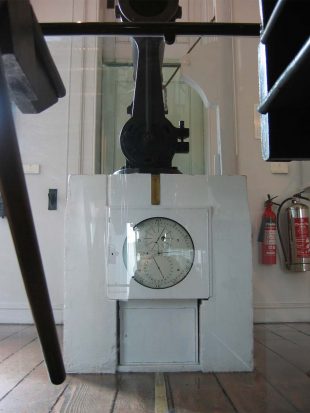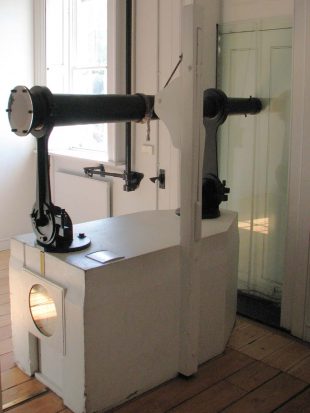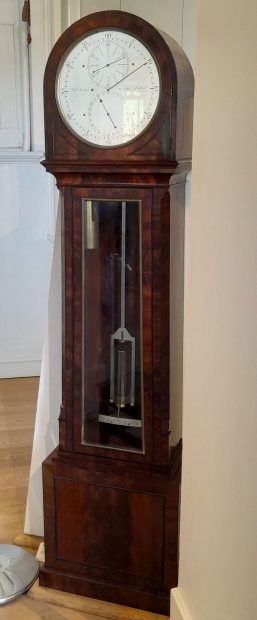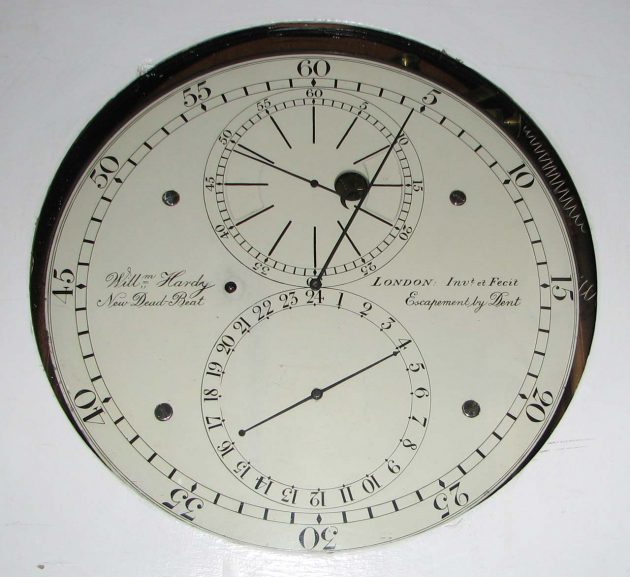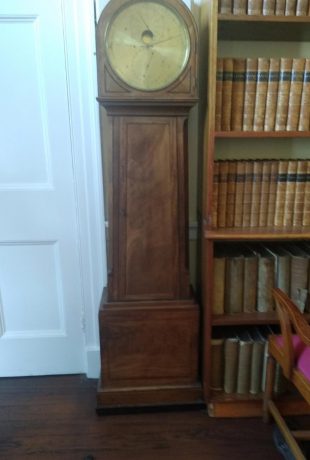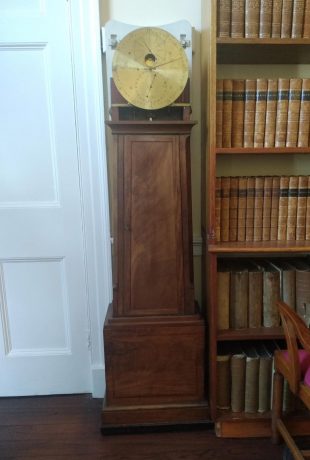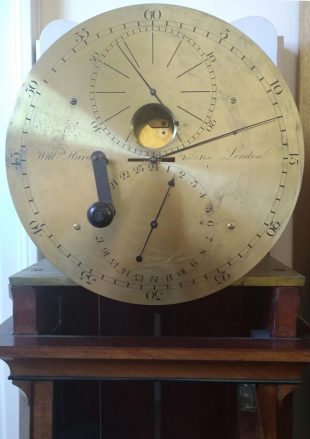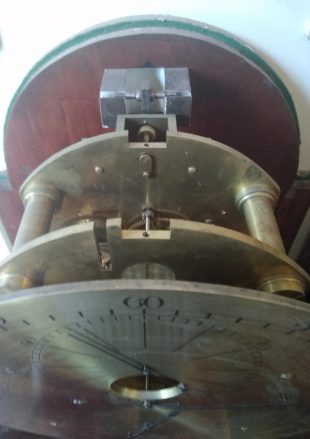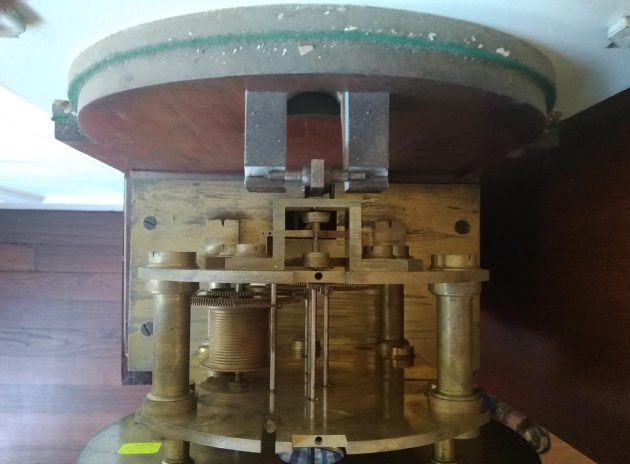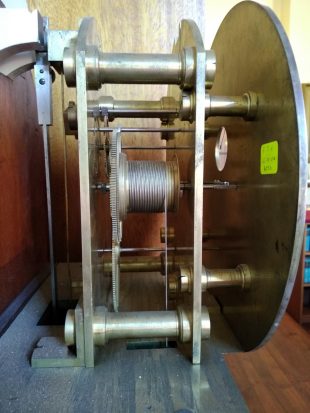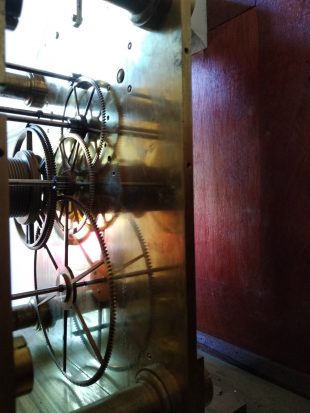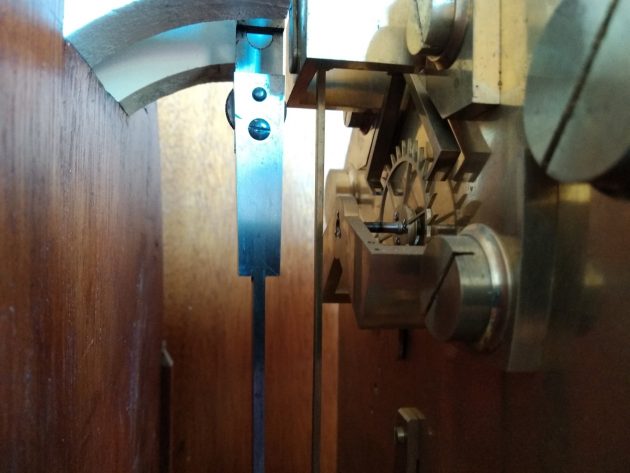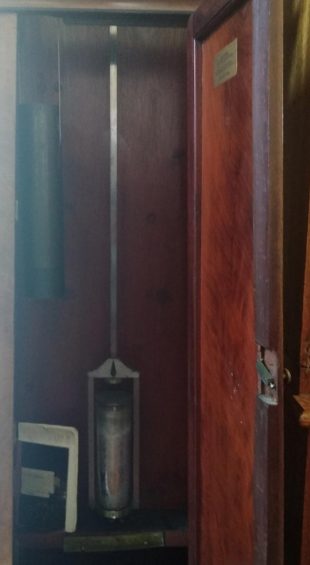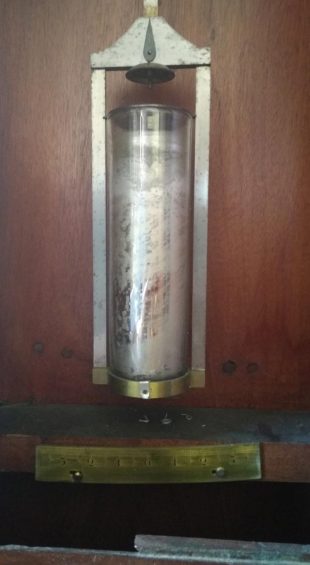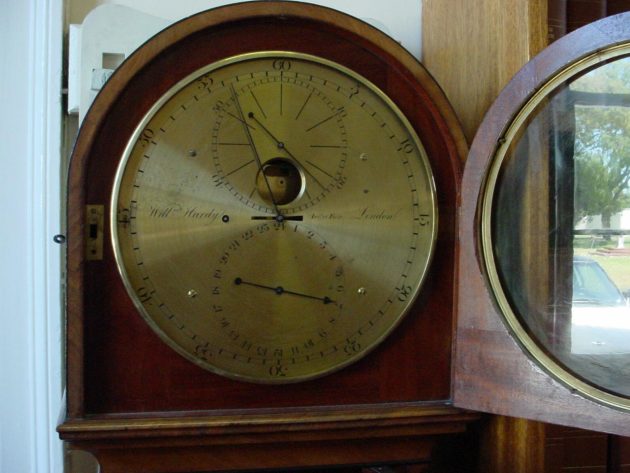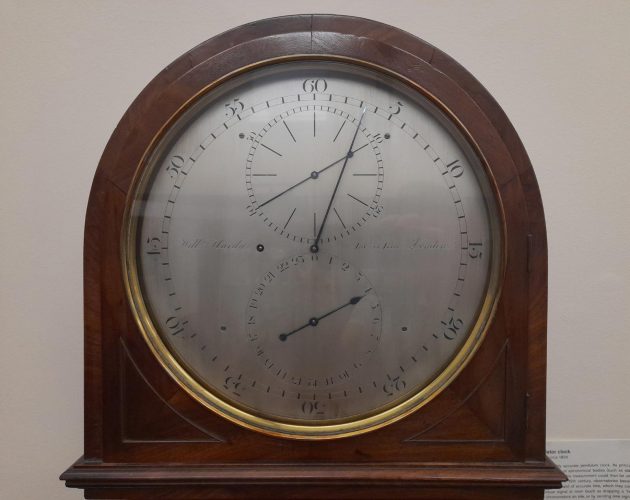…where east meets west
- Home
- Brief History
- The Greenwich Meridian
- Greenwich
(1675–1958) - Herstmonceux
(1948–1990) - Cambridge
(1990–1998) - Outstations (1822–1971)…
- – Chingford (1822–1924)
- – Deal
(1864–1927) - – Abinger
(1923–1957) - – Bristol & Bradford on Avon
(1939–1948) - – Bath
(1939–1949) - – Hartland
(1955–1967) - – Cape of Good Hope
(1959–1971)
- Administration…
- – Funding
- – Governance
- – Inventories
- – Pay
- – Regulations
- – Royal Warrants
- Contemporary Accounts
- People
- Publications
- Science
- Technology
- Telescopes
- Chronometers
- Clocks & Time
- Board of Longitude
- Libraries & Archives
- Visit
- Search
Astronomical Regulator: Hardy
Made by William Hardy and known as 'Hardy' since the mid 1830s, this particular regulator was delivered to the Observatory in 1811 and remained in continuous use as a Transit Clock until 1954. It is one of the most important clocks that the Observatory ever owned. During the 143 years that it was in active service, the Observatory was headed by five different Astronomers Royal: John Pond (1811–1835), George Airy (1835–1881), William Christie (1881–1910), Frank Dyson (1910–1933) and Harold Spencer Jones (1933–1955). During its lifetime, it underwent numerous and significant alterations.
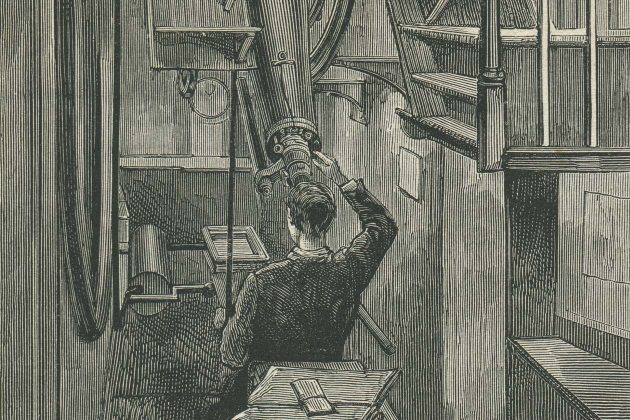
Hardy in use with the Airy Transit Circle. The observer is in a pit below the level of the floor. The dial can be seen towards the top left. From the 8 August 1885 edition of The Graphic (detail)
Although the clock was ordered by the fifth Astronomer Royal, Nevil Maskelyne, he does not appear to have lived long enough to see it brought into use. When it was ordered, the intention was to use it as a Transit Clock with a Mural Circle that was then under construction.
As originally conceived, the plan was for the Mural Circle to replace both the existing 8-foot Transit Telescope and the Mural Quadrants. In practice, it proved insufficiently stable to make reliable transit observations, so a new 10-foot Transit Instrument was ordered from Troughton in 1813. It was brought into use in 1816 and used initially with Graham 3, the same Transit Clock that had been used with its predecessor. In 1821, Graham 3 was dismounted and replaced by a series of transit clocks in quick succession (some or all of which appear to have been supplied on a trial basis), starting with a clock by Molyneux and Cope. None appear to have been satisfactory. By late 1823, Hardy needed to be moved to make way for a second Mural Circle in the Circle Room and it was at this point, that it was transferred from the Circle Room to the Transit Room for use with the 10-foot Transit Instrument.
In 1851, the Airy Transit Circle, replaced both the 10-foot Transit Telescope and the Mural Circles. Hardy remained in use as the Transit Clock and continued to be used with the Transit Circle until the last observation was taken in 1954.
Until 1871, when the regulator Dent 1906 was brought into use, the Transit Clock was the Observatory's de facto sidereal standard.
Today, Hardy can be seen on the south side of the Airy Transit Circle in the same position that it has occupied since December 1850. It is cared for by the National Maritime Museum (Object ID: ZAA0591). A replica pier (similar to that used with an earlier transit clock) was erected beside the Troughton Transit Instrument by the Museum in the mid-1960s, and marks the position Hardy occupied from 1823 until 1850.
Management and oversight of the Observatory in the early 1800s
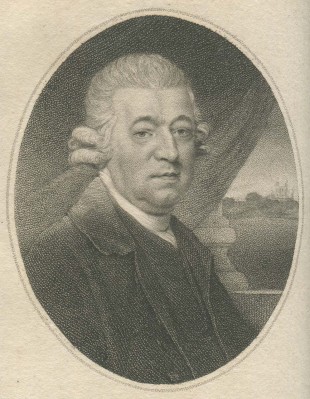
Nevil Maskelyne, the fifth Astronomer Royal. Engraved from a pastel drawing by John Russell and published by J. Asperne, 1 March 1804
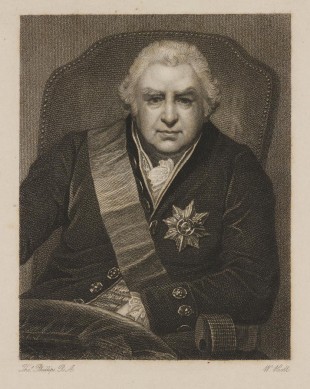
Sir Joseph Banks. Engraving by W. Holl from the 1815 oil painting by Thomas Phillips. � The Board of Trustees of the Science Museum. Reproduced under the terms of a Creative Commons Attribution-NonCommercial-ShareAlike 4.0 Licence (CC BY-NC-SA 4.0), details below
To understand the early history of the clock, it is helpful to understand a little more about the relationship between Maskelyne and the President of the Royal Society, Sir Joseph Banks, as well as how things were handed over to Pond when he became Astronomer Royal following the death of Maskelyne in early 1811. Banks and Maskelyne were both Commissioners of the Board of Longitude and Maskelyne was answerable to the Observatory's Board of Visitors of which Banks, as President of the Royal Society, was Chairman (and had been since 1778). Maskelyne also held high office at the Royal Society, having been a longstanding member of its Council. Their working relationship on the Board of Longitude came under severe strain in 1784 and an abrupt end in 1806 when Banks stopped attending meetings following a disagreement with his fellow Commissioners, and in particular Maskelyne, about an award made to Thomas Earnshaw. Although Banks had stopped attending meetings of the Board of Longitude, Maskelyne who by then was in his mid 70s, continued to attend meetings of Council of the Royal Society.
It was during Bank's absence at the Board of Longitude that the seeds were sown that led to the Nautical Almanac being brought into disrepute in the 1810s. This was due in large part to a lack of succession planning. The comparer Malachy Hitchins (1741–1809), the Board's Secretary, George Gilpin (c.1755?–1810), and Maskelyne (1732–1811), all died in quick succession while still in office. During this period, the Board normally met just three times a year. The meeting on 7 March 1811 was the first to be held following the death of Maskelyne and the first that Banks had attended since March 1806. None of the members of the Board appear to have had a clue about what was involved in managing the production of the Almanac as it was resolved:
‘That the Astronomer Royal [Pond] be requested to conduct the business of the Nautical Almanac by superintending & paying the Computers and Comparer in the manner that has been heretofore done & that the Secretary be requested to allow him access to the Minutes of the Board in order that he may collect from them the mode in which that business has been hitherto carried on.’(RGO14/7/145)
What is striking is that Pond wasn’t handed a dossier by the Secretary setting out how the Almanac had been managed and what the present state of play was. He was required instead to extract this information from the Board’s minutes. This would have been an all but impossible task since the minutes, of which 800 pages had been accumulated since the Almanac was conceived in 1765, did not contain the information in the detail that Pond would have needed. So what of the handover to Pond of the Observatory business?
We know that there was no ongoing correspondence included amongst the ‘Printed Books Manuscripts and Pictures left and presented by Mrs Maskelyne at Flamstead House for the Use of the Royal Observatory’ that were formally handed to Pond by Maskelyne's widow when he took up residence in April (RS/MS372/168 & NMM REG09-000037).
But we also know that Pond dined with Maskelyne at the Observatory on at least seven occasions between 1806 and 1809. He may also have dined after 1809, but there are no surviving records for this period. Pond was elected a fellow of the Royal Society on 26 February 1807. As well as becoming a member of the committee that looked into the acquisition of the Mural Circle, Pond was one of the fellows invited to attend the Observatory as a Visitor on 10 July 1807 (RGO6/22/56). He was also invited to all the later Visitations. However, the only ones he attended prior to his appointment as Astronomer Royal were those in 1807 and 1810 (RGO6/22). In late 1810, he was also brought onto the Council of the Royal Society.
Pond was clearly familiar with some aspects of the way in which the Observatory was run during Maskelyne's time. But what if anything did he know either about the likelihood of succeeding Maskelyne or about the clock? Although Maskelyne made his last observation on 1 Sep 1810, a little over 3 months before he died, there is no record of any succession planning having taken place. The catalogue of Maskelyne's papers (RGO4) makes no reference to either Hardy or the purchase of a new Transit Clock, suggesting that Pond may have had little if any knowledge of what had been agreed between Maskelyne and Hardy. The fact that the catalogue also makes no reference to the Mural Circle is also interesting and leads us to ask: was the paperwork retained by his widow, was it handed to Pond, but subsequently destroyed or is there some other explanation for its absence?
The documentation surrounding the early history of the clock is very sketchy. Much of what survives is contained in the Royal Society file RS/MS/372 and the minutes of the meetings of its Council. Extracts from the minutes from 1710–1830 deemed relevant to the Royal Observatory were transcribed for George Airy and can be found in RGO6/21&22. What, if anything, was omitted is not known and a comparison with the originals would be needed to find out – a task that no researcher has yet undertaken in any sort of a systematic manner. It is known however that the resolution relating to the clock that appears in the minutes of the committee that met on 22 January 1807 and mentioned in the section below (RS/MS600/59) does not appear with the rest of the minutes of the committee that were transcribed into RGO6/22 as part of the minutes of the Council meeting held on 19 March 1807 (RGO6/22/53). It is not yet known if this was because of an error made when the committee minutes were transcribed into the Council minutes or when the Council minutes were transcribed for Airy.
The need to re-equip the Observatory – the chronology of events leading up to a new clock being ordered from Hardy
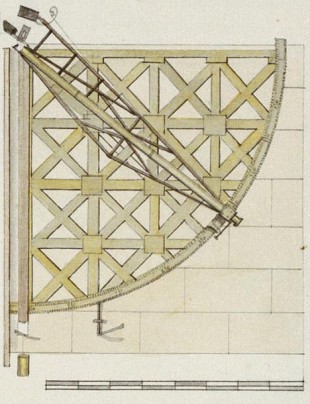
Bradley's Mural Quadrant. Detail from a drawing by John Charnock c.1785. Reproduced under the terms of the Creative Commons Attribution-Non-Commercial-ShareAlike (CC BY-NC-SA) licence courtesy of the National Maritime Museum, Greenwich, London (see below)
Nothing much happened until 22 January 1807, when a specially convened committee of the Society resolved that the Royal Observatory should be provided with a vertical circle together with a clock to go with it and a new room to house them in (RS/MS600/59). Pond was subsequently co-opted onto the committee, and later that year, a large Mural Circle was ordered for the Observatory from the instrument maker Edward Troughton with the intention that it would supersede both the Mural Quadrants and the 8-foot Transit Telescope.
Meanwhile, back on 8 January 1807, the chronometer maker William Hardy had written to to George Gilpin, the Secretary of the Board of Longitude explaining that he had invented a new form of spring pallet escapement and asking if it could be put on trial at the Royal Observatory (RGO14/23/239). Perhaps in part because the Observatory was looking to acquire a new clock, at its meeting on 5 March 1807, Maskelyne and the board assented. Hardy records that:
‘He [Maskelyne] accordingly called on me the day after the meeting of the Board, to see the escapement; and being pleased with it, desired me to send the clock to the Observatory for trial, as soon as I possibly could.’
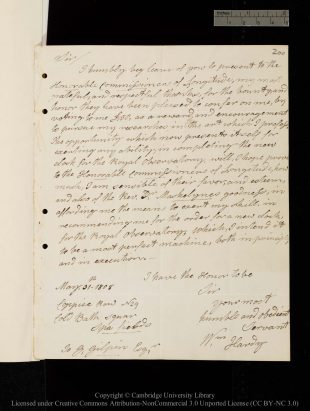
Hardy's letter to the Board of Longitude containing the first mention of a clock being ordered for the Royal Observatory. It was written on 31 May 1808. Reproduced under the terms of a Creative Commons Attribution-Non-Commercial 3.0 Unported License (CC BY-NC 3.0) courtesy of Cambridge Digital Library (see below)
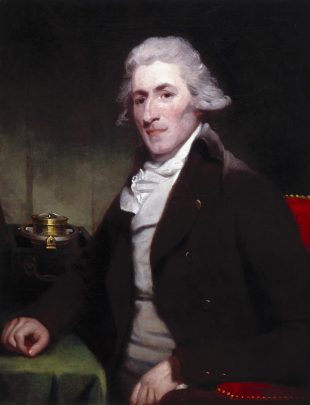
Thomas Earnshaw (1749-1829), attributed to Sir Martin Archer Shee, 1798. Reproduced under a Creative Commons Attribution 4.0 licence courtesy of The Board of Trustees of the Science Museum (see below)
In the mean time, at the end of May, a three month trial of the clock had already begun.The details of the trial are gone into in more detail below, but at this point it is only necessary to know that the results were not tabled at the next meeting of the Board, but at the one after that on 3 March 1808, where it was resolved: 'That the sum of £50 be given to Mr William Hardy as a Reward for the performance of his Clock, and to encourage him to proceed in the farther improvement of Clocks.’ (RGO14/7/115).
Maskelyne subsequently ordered a clock from Hardy for use with the new Mural Circle. Exactly when the order was made is unclear as the first we hear about it is from a letter that Hardy wrote to the Board on 31 May 1808 thanking them for their award in which he wrote:
‘I am sensible of their [the Board’s] esteem and also of the Rev. Dr. Maskelynes goodness, in affording me the means to extend my skill, in recommending me for the order for a new clock for the Royal Observatory, which, I intend it to be a most perfect machine, both in principle,and in execution.’ (RGO14/1/200)
In the meantime, in February 1808, Thomas Earnshaw was writing the introduction to his pamphlet: Longitude: an appeal to the public: stating Mr Thomas Earnshaw's claim to the original invention of the improvements in his timekeepers, ...which was published later that year.
Long before Hardy had launched himself onto the clock-making scene, Maskelyne had asked Earnshaw to make a clock for the observatory in Armagh. The clock he produced performed exceedingly well when put on trial at the Royal Observatory in 1792 before being shipped to Armagh in 1794. Like the clock that Hardy was to make, it had both jewelled pallets & pivot holes. Unlike Hardy's clock it also had a sealed case to keep out dust and draughts and, according to Earshaw, had been running for the past 14 years without being cleaned. On page 48 of his Appeal, Earshaw wrote the following:
'After I had pointed out to Dr. Maskelyne the absurd manner in which the famous Mr. Arnold had jewelled the transit clock [Graham 3] at Greenwich, he wanted me to re-jewel it, and do any thing else I thought necessary; I refused, saying, that let me do what I might, it was still Graham's clock, and his name was on it, and if the Royal Society, after the proofs I had given of my superiority, did not choose to order as good a clock of me, as I could make, they might keep their old one as it was, as a standing monument of disgrace to Mr. Arnold and others, who had botched it up in the manner it now is.'
Given Maskelyne's championing of Earnshaw and the proven performance of not only the clock that he made for Armargh, but also others that he made subsequently; it has to be asked, why was the commission for the new clock at Greenwich given to Hardy who had no proven record beyond a short trial of his new escapement? One can only speculate on the reason. Perhaps Maskelyne did suggested him and Banks vetoed the idea or maybe Maskelyne chose not to suggest him for fear of opening up old wounds.
Images of the clock and the documentation of its history
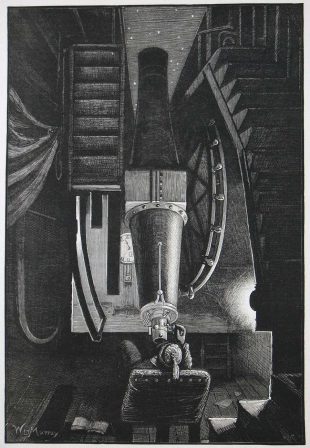
The Airy Transit Circle with Hardy in the background. The illustrator, William Bazett Murray, has simplified the dial beyond recognition. From the 11 December 1880 edition of The Illustrated London News
The earliest photos seem to be those taken for conservation purposes in the mid and late 1960s. Showing details of the movement, they have never been published. Nor have any others that show the movement. Even today, the clock is rarely if ever photographed by Museum visitors.
The only known images prior to the 1960s are two woodcuts of the Airy Transit Circle in which the clock appears in the background. Lacking in detail, they were published in the 11 December 1880 edition of The Illustrated London News (right) and the 8 August 1885 edition of The Graphic (from which a detail is reproduced above).
No correspondence has been found between Hardy and Maskelyne or between Hardy and Pond apart from a single letter sent by Maskelyne that appears to have ended up in the hands of the bookseller John Nourse and is now in the collections of the Royal Astronomical Society.
The clock has a complex history which is made all the more difficult to unravel not only due to the lack of images, but also because the records are often rudimentary and not always complete. Snippets of information are spread thinly across a very wide range of sources including the Royal Society archives, the Observatory archives and the published volumes of observations. Tracking them down is rather like looking for possible needles in a large but unknown number of haystacks.
Five key features of the Greenwich Clock as originally supplied
- Hardy's escapement
- Accurately cut epi-cycloid shaped teeth on the wheels and pinions
- Jewelled bearings and pallets
- A mercury compensated pendulum
- An integrated stone pier which formed part or most of the case
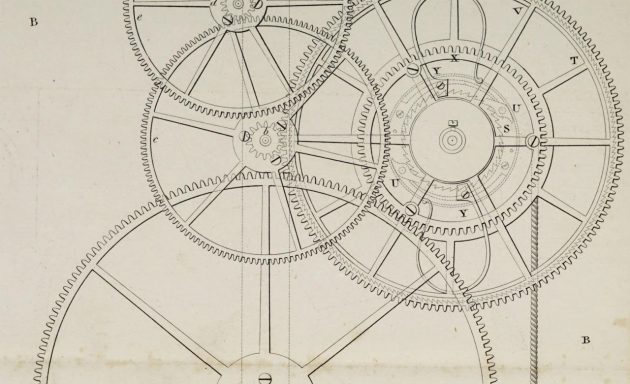
The epi-cycloid shaped teeth on the wheels and pinions of Hardy's regulators. Detail from plate 34 accompanying Hardy's description of his escapement. Reproduced from Transactions of the Society Instituted at London for the Encouragement of Arts, Manufactures and Commerce. Volume 38, courtesy of the Wellcome Library & Internet Archive
Servicing and altering the clock: the Hardy and Dent correspondence
Although Hardy came to the Observatory to service or alter the clock, as mentioned above, none of the correspondence appears to have been preserved. Hardy continued to have responsibility for the clock until 1830 when he failed to respond having been asked twice to attend. Not having received a reply Pond turned to Edward Dent instead (more on this below). As things turned out, Hardy never worked on the clock again. Although he did not die until 1832, it was Dent rather than Hardy who attended when the clock next needing cleaning at the end of 1831. From that point on, Dent was always the clockmaker called on by Pond and his successor Airy to work on the clock.
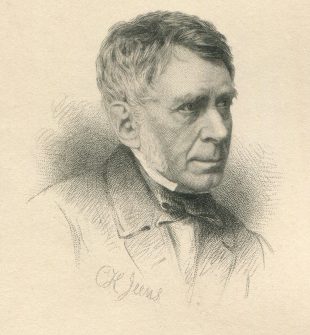
George Airy engraved by C H Jeens from a photograph probably taken by Alfred Brothers in Manchester in September 1861
The Dent company names include:
1826–30 E.J. Dent
1830–40 Arnold & Dent
1840–53 Edward J. Dent
1853–61 Frederick Dent
1861–64 Dent & Co
1864–97 E. Dent & Co
1897–today E. Dent & Co. Ltd
Altogether, there are around 800 sheets of correspondence between the Observatory and the Dent companies that relate to the Observatory clocks during Airy's period in office (1835-1881). All except those from the year 1878 (which are missing) are preserved in the Correspondence with tradesmen files (RGO715-758). They exclude the correspondence relating to chronometer trials, which Airy filed elsewhere. Although other makers started to be used as well after Airy retired, the Dent companies continued to do work for the Observatory until at least 1920.
One of the difficulties with the Dent correspondence is that clocks are not always identified by name. Another is that the correspondence is just one part of an ongoing dialogue that continued in spoken form while Dent or his aides or staff from the successor companies were at the Observatory. Not being privy to those conversations makes some of the correspondence difficult to follow.
Research is still ongoing. All the Dent correspondence in RGO6 relating to years when work on the clock is mentioned in the volumes of Greenwich Observations or the Reports of the Astronomer Royal has been examined in detail as has the correspondence from certain other years. The remaining correspondence (1841–1848, 1852–3, 1857–63 and 1865–69 ) will be examined during the next few months.
Articles and chapters on Hardy's escapement and regulators
Greenwich Observatory, Vol 3. Derek Howse (1975), p.p.132–133
What’s Wrong With Hardy’s Escapement? Christopher Wood, Volume 9/8 (September 1976)
William Hardy’s Regulator. A.J. Turner, Volume 11/6 (Winter 1979)
William Hardy and His Spring Pallet Regulators. Charles Allix, Volume 18/6 (Summer 1990)
Design Analysis of a William Hardy Regulator Spring Detent. Leslie Paton, Vol. 19/2 (Winter 1990)
What’s Wrong With Hardy’s Escapement? A Re-Appraisal. Christopher Wood, Vol. 20/4 (Winter 1992)
Horological Journal
The performance of a 19th century regulator. John Redfern & Philip Woodward, Vol 135/9 (March 1993)
English Precision Pendulum Clocks. Derek Roberts (2003), pp. 83–94.
Maskelyne, Astronomer Royal. Rory McEvoy, Ed. Higgitt (2014), chapter 5
The bulk of the original work that has been published about Hardy's regulators has appeared in the various horological journals and sits behind a paywall. Some accounts draw on Howse, who made a number of incorrect statements. In his book, Robert's has drawn heavily on some of the Journal articles where there were already misunderstandings and created an even more misleading account strewn with errors. This is particularly unfortunate as the book is a first point of reference for auction houses.
1807: Hardy's escapement tested at the Observatory for the Board of Longitude
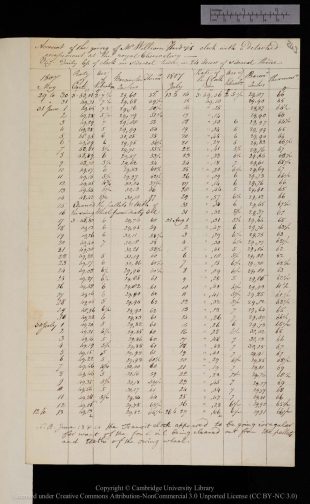
Trial results showing the rate of the clock. Reproduced under the terms of a Creative Commons Attribution-Non-Commercial 3.0 Unported License (CC BY-NC 3.0) courtesy of Cambridge Digital Library (see below)
The results of the 1807 trial are reproduced alongside. Against the entry for 15 & 16 June, Maskelyne has written 'Cleaned the pallets & teeth of the swing Wheel from dirty oil'. At the bottom of the page however, Maskelyne has also written:
'N.B. June 13 & 14 the Transit clock [Graham 3] appeared to be going irregular for want of the foul oil being cleaned out from the pallets and teeth of the swing wheel.'
What Maskelyne did not record, was that Graham 3 was stopped on the following day to clean it. This information comes from the 15 June entry in the published observations where Maskelyne's Assistant Thomas Firminger recorded:
'At 6h24' stopped the Transit Clock, and cleaned away all the dirty oil from the swing wheel and pallets of the verge; then put a little of the best olive oil to them, and set the clock going again, exactly one minute faster than before. The clock was stopped 24 minutes. T.F.
Having stopped Graham 3, it would have had to be re-rated before the rate of Hardy's clock could be measured again. In light of this, it has to be asked, what exactly did Maskelyne mean by his entry for the Hardy's clock on 15 & 16 June? Was the Hardy clock stopped and cleaned or was the entry a somewhat ambiguous reference to Graham 3 that was partially clarified by the note at the bottom of the page? If Hardy was cleaned, it was probably only done as a precaution while the trial was paused while Graham 3 was being cleaned and re-rated. It also seems likely that Hardy would have been summoned to clean it. There is no evidence that he was sent for.
Very few Hardy escapements still exist in their original form and there has been much debate about why this is. One of the downsides of the escapement (said by McEvoy to be its Achilles' heel) is that any build up of dirt on the pallets had a significant impact on the rate of the clock.
It is an unfortunate fact, that the results of the trial have been misunderstood in the past and that this misunderstanding is in serious danger of becoming embedded. In his book English Precision Pendulum Clocks, Derek Roberts published a transcript of the trial results (with a shockingly large number of transcription errors) and wrote:
'Note that even at this time its going became irregular after just 10 weeks [days] because of "foul oil"; however its overall performance was excellent, remaining within the same second'.
In December 2021, Bonhams sold what they believed to have been the trial clock for £25,250 (Bohnams Catalogue). Seemingly building on what Roberts had written, the catalogue entry states of the trial:
‘Overall the performance was very promising. The regulator maintained a rate of to within one second a day, but not before a problem in the middle of June when the performance became erratic due to the accumulation of dirt on the pallets. Hardy had to clean the pallets and "the teeth of the swing wheel" (escape wheel). It took two days to do this and reset the clock when it ran until the end of August to within one second a day.’
Contemporary descriptions of the escapement
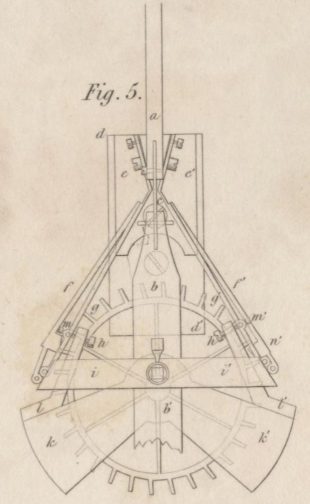
Hardy's Escapement. Detail from Plate 14 of Pearson's An introduction to practical astronomy (London, 1829). Copied by J Farey from plate 34 of Hardy's description in the Transactions of the Society Instituted at London for the Encouragement of Arts, Manufactures, and Commerce and engraved by E. Turrell. Reproduced courtesy of Robert B. Ariail Collection of Historical Astronomy, Irvin Department of Rare Books and Special Collections, University of South Carolina Libraries
Letter and description: Transactions of the Society Instituted at London for the Encouragement of Arts, Manufactures, and Commerce. Volume 38, (1820) pp.168–185.
At the end of the description, Hardy made the following somewhat ambiguous statement:
‘I think it proper to add, for the benefit of the time-piece and regulator makers, that I have enabled Mr. Thomas Leyland, clock-maker, of Prescot, in Lancashire, to cut wheels and pinions with teeth made truly epicycloidal, from patterns generated by myself, and also to make and fit up regulator movements complete.’
What he failed to state is who Leyland was authorised to make them for? We don't even know if he made them for Hardy himself.
There are at least 18 clocks known to have been made by (or for?) Hardy. They are listed in the appendix at the bottom of the page. Although all are very similar there are significant variations between them. These include the number of pillars linking the front and back plates (some have five and others four), the train count, the precise detailing of the dial and the positioning of the four screws fastening the dial to the rest of the movement. In many ways, the Greenwich Clock was an overspecified prototype for those that followed and differed from them in a number of significant details. A proper comparative study is long overdue, but is regrettably beyond the scope of this website.
In 1824, Ferdinand Hassler published a description of the two clocks supplied by Hardy in about 1813 for his survey of the coast of the United States. It included four figures which included drawings of the escapement. It is interesting to note, that they differ in significant details from those published by Hardy
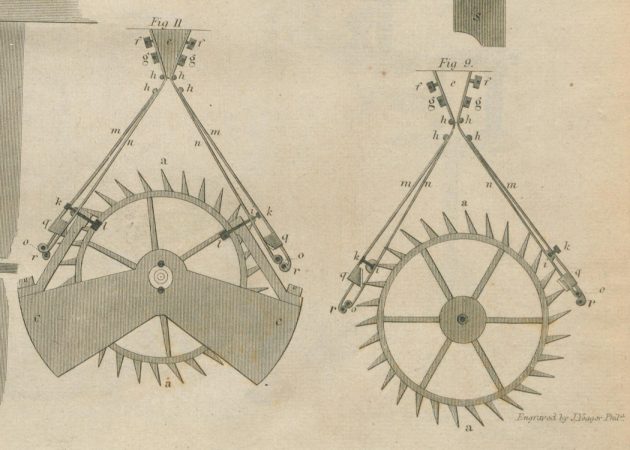
Hardy's escapement as drawn from life at Greenwich by Ferdinand Hassler in 1812 and later engraved by J. Yeager. At some point later, Hardy seems to have modified the design as the escape wheel teeth have squarer ends in the designs he published in 1820. Detail from plate 6 of Papers on various subjects connected with the survey of the coast of the United States by F. R. Hassler (1824) Reproduced under a Creative Commons BY-SA 4.0 license courtesy ETH Z�rich
In 1816, William Pearson (1767–1847), bought a Hardy Regulator. A few years later he helped found the Royal Astronomical Society, and in 1826 he joined the Observatory's Board of Visitors. At the end of the 1820s he produced his magnum opus, An introduction to practical astronomy, in which he described Hardy's escapement and how it should be cleaned. His account and illustrations however were largely adapted (largely without acknowledgement) directly from the account given by Hardy in 1820. Links to the relevant pages are provided below.
Description: An introduction to practical astronomy, Vol 2 pp.306–8
Illustrations: An introduction to practical astronomy, Vol 3, Plate 14, figs 5, 6, 7, 8, 9
Instructions on cleaning the escapement: An introduction to practical astronomy Vol 2 p.315
Hardy is said to be the first (British?) Clock maker to use accurately cut epi-cycloid shaped teeth on the wheels and pinions of his clocks. Details of how they were cut were initially published in 1822 by Thomas Gill in Volume 1 of his Technical Repository: and elaborated on in 1839 in Volume 1 of his Machinery Improved.
The delivery of the Greenwich Clock prior to Pond's arrival and an argument over the bill
What is very clear, is that the sort of information one would normally expect to find about the clock is not present in the minutes of the Council of the Royal Society as transcribed for Airy in RGO6/22. In particular, there is no record of any discussion between Maskelyne and Council about ordering a clock from Hardy. Nor is there a record of Maskelyne or Pond submitting Hardy's bill to Council for them to approve and then forward to the Board of Ordnance for payment in the normal way. Pond himself would have been aware of this procedure regarding the payment of bills before he became Astronomer Royal as he was present at the Council meeting on 13 December 1810 when Maskelyne submitted a set of bills for approval (RGO6/22/63). Either all the references to the clock were overlooked during the transcription process, or irregular procedures were being followed.
The minutes of the Council held on 23 April 1807 record that:
'a letter from the Secretary to the Board of Ordnance date March 23rd 1807 was read stating that the said Board had given orders that the Circular Instrument, and necessary alterations to the building of the Royal Observatory, recommended by the President and Council of the Royal Society should be immediately provided.' (RGO6/22/54)
There is no mention of the clock in the minutes of the meeting and neither the original letter nor a copy of it can be located so that the full text can be examined. Nor is there any mention elsewhere of the Board authorising the purchase of a new clock.
The exact date of Pond’s appointment as Maskelyne's successor is uncertain as is the date that the clock was delivered. The Navy Estimates for 1812 show that Pond was paid from 18 February 1811 (ADM181/20), the official announcement of his appointment being made five days later in The London Gazette (Issue 16457). However, he was unable to take up residence until 13 April due to the length of time it took Maskelyne's widow and daughter to move out.
The Mural Circle was erected in 1812, with the first published observations being made on 11 June. A note Pond wrote in 1830 records that the clock was installed in 1811 and that 'its daily rate from April to the end of the year was remarkably uniform' (RGO5/222). Although Pond's note does not state when in April the measurements began, a table of the clock's rate published in Rees’ s Cyclopaedia in 1819 shows that it was up and running by 12 April. In other words, it was installed before Pond took up residence. Whether of not it was delivered before or after Maskelyne died is not known. What we do know however is that the pier on which the clock was to be mounted was in place by the autumn of 1809. In a letter to Hardy dated 13 September, Maskelyne wrote:
'You desired the pier built for receiving the clock bespoke of your for the new room, might not be painted; but I forgot to mention it in time, and they have now painted it, without my being aware of it. You will consider whether it will do any harm, and how long time it will take drying, & whether it will do harm, & if the paint should be scraped off? Pray urge Mr. Troughton to finish the pendulum.' (RAS/MSS/Add/5/7)
The letter is of interest on several counts. Firstly its incoherent nature. Secondly because it conveys a sense of urgency and thirdly because of the mention of Troughton making the pendulum (assuming that it is that it was for Hardy's clock rather than another clock at the Observatory or for pendulum swinging experiments). Given the letter's contents, one might reasonably expect the clock to have been erected long before Maskelyne died. On the other hand, there is no evidence that Hardy ever submitted a bill to Maskelyne for the completed clock, which suggests it was completed afterwards. Hardy's letter that was written in 1820 and accompanied his description of the escapement in the Transactions of the Society Instituted at London for the Encouragement of Arts, Manufactures, and Commerce also seems to imply that it was delivered afterwards.
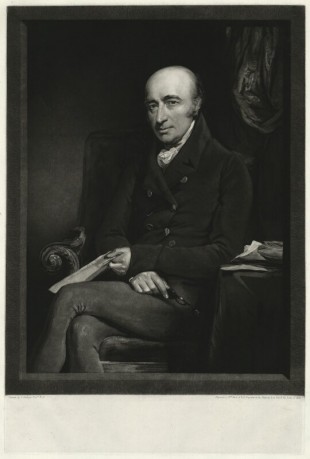
William Hyde Wollaston, by William Ward, after John Jackson. Mezzotint, early 19th century. � National Portrait Gallery, London. Reproduced under a Creative Commons Attribution-NonCommercial-NoDerivs 3.0 Unported (CC BY-NC-ND 3.0) licence (see below)
‘Mr. Wm. Hardy having delivered a Bill amounting to £325 for the astronomical clock he has prepared for the Royal Observatory, and the Astronomer Royal having stated that the charge is much greater than was expected or thought reasonable by the Council of the Royal Society: I am directed to acquaint you therewith, and request you will move the Council to favour the Board with their opinion, what would be a reasonable sum to be allowed Mr. Hardy for the Clock alluded to.’ (RS/MS/172/146)
The letter was not acted upon until some twelve weeks later when it was read at what appears to be the next meeting of Council on 14 November. There it was resolved that 'Mr Hardy be desired to attend a meeting of the Council on Thursday next [21 November]'. There is no mention however of Hardy actually having attended in RGO6/22.
In light of Bank's relationship with Maskelyne from 1806 onwards, it is interesting to note what information the Council of the Royal Society did and did not include when they gave their opinion to the Ordnance as to 'what would be a reasonable sum to be allowed Mr. Hardy for the Clock' After a brief introductory paragraph, their report continued:
'That having examined Mr Hardy on the reasons & calculations of his charge of £325 for an Astronomical Clock; and then inquired of all such persons as they thought able to give them information respecting the just value of & proper prices for such Instruments. Hence they are opinion That Mr Hardy has in consequence of a misconception of the verbal directions given to him by the late Astronomer Royal unnecessarily incurred a considerable expense in executing those parts of the clock which have no real influence on the correctness of its going. He appears to have finished those parts almost as highly as the principal movements. The labour and expense thus bestowed are of little or no value to the purchasers of a Clock as a measure of time. That he has employed more jewel work, than usual, in making this clock, more than they believe has before been thought expedient in the construction of any clock whatever. That he has been so inattentive to the interest of his employers, as to suffer the tradesmen, of whom he ordered those parts of the clock which the clockmaker does not usually supply (the case for instance) to charge for their work prices as unreasonable as his own charge is deemed by the Council to be. That he has, in computing his charge for this clock, included the expense of some part of the tools with which it was made; a practice never customary with tradesmen of any kind, as the tools remain their property; and those of Mr Hardy have actually enabled him to make other clocks for the persons who now employ him. On considering the whole of the case, the general testimony of those who have inspected the Clock that it seems to be extremely well executed, and the report of the Astronomer Royal that it has gone with extraordinary exactness since it was put up in the Royal Observatory. The Council do resolve to recommend to the Board of Ordnance to pay Mr Hardy the sum of Two hundred guineas for the clock he has delivered; and they are of opinion that this sum, which is considerably larger than any that has been before paid for an Astronomical Clock, is a liberal compensation to Mr Hardy for his skill & labour in making the Clock as well as for the just and reasonable cost of the articles not furnished by himself.' (RGO6/22/69 & RS/MS/172/153)
The extent to which Banks was attempting to deflect blame away from himself and the Society for the Hardy fiasco by being economical with the truth is difficult to judge. Only one individual can be identified by name as having talked to Hardy – the clockmaker Alexander Cumming. Nowhere in either his report to the Society or the Society's report to the Ordnance is there any mention of a written contract with Hardy – so did one actually exist? The real elephant in the room however is the signed but undated itemised estimate from Hardy for £269 3s 6d. for supplying the Greenwich clock. Held in the Royal Society archives (RS/MS/372/152) rather than those of the Observatory, there is no reference to it in Cumming's or the Royal Society's reports, (nor seemingly in most modern accounts of the affair either).
Estimate of the Greenwich Clock
| To ten months, and two weeks workmanship, and time | £210-0-0 | ||
| Frames Mounting | 8-0-0 | ||
| Brass Plate | 6-10-0 | ||
| Wood work | 20-0-0 | ||
| Varnishing D.o | 1-0-0 | ||
| Pendulum and index | 8-10-0 | ||
| Weight, and pulley work | 1-11-6 | ||
| Dial place, and glass | 2-10-0 | ||
| Engraving D.o afresh | 1-0-0 | ||
| Jewelling | 9-10-0 | ||
| Porterage and carriage | 0-12-0 | ||
| £269 3 6 | |||
| charge - £325 [written in another hand] | W.m Hardy |
After interviewing Hardy, Cumming wrote to Wollaston on 19 Jan 1812. In his letter, he explained how he had met with Hardy (apparently at the Council's request and at the suggestion of Hardy) to discuss the terms of the contract. Although the Ordnance letter of 21 August 1811 could be construed as meaning that Hardy appealed over Pond's head directly to the Ordnance for payment, this does not appear to be the case, as Cumming wrote that Hardy 'said that he understood that his Bill was sent to the Tower, and he supposed it was to be paid' (RS/MS/172/149).
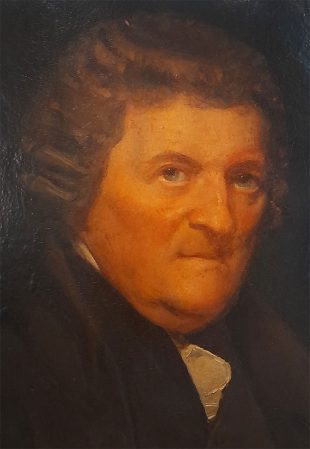
Alexander Cumming. Portrait by an unknown artist (detail) presented to the Worshipful Company of Clockmakers by his grand-nephew, John Grant in 1882
In the published letter of 1820, Hardy himself gave the following account of the agreement that had been made:
‘It was from the satisfactory performance of this clock [the one that had been on trial], that I was recommended by the Doctor [Maskelyne] to the Board of Ordnance as a fit person to furnish a clock on the same principle for the room in which the famous mural circle is placed, which circle was then making by the celebrated Edward Troughton. The order for the clock was unlimited in price, and directed me to consult the Doctor on every particular connected with it. I therefore waited on the Doctor to receive his instructions; his treatment to me was kind and hospitable, and he gave me every encouragement to exert myself, and to complete the clock in such a manner as to be durable and certain in its performance. As it was to accompany one of the most excellent instruments that ever was made, he wished the clock to be equally so in point of excellence. This excited me to use my utmost exertion, and to spare neither time nor expense in order to make it as perfect as possible. It was decided upon to jewel every action in the escapement and all the pivot holes. The teeth of the wheels and pinions were epicycloidal, and were all finished in the engine by cutters which I made for that purpose; and the whole of the clock was finished in a style equal to any of our first-rate chronometers.’
Having received a letter from the Ordnance that they were 'not disposed to allow the amount' of his bill, Hardy replied on 17 February 1812 asking 'for two or three superior chronometer makers' to arbitrate or 'to have permission to take back the clock' (RS/MS/372/150). Two days later on 19 February the Ordnance forwarded a copy of Hardy's letter to Wollaston and asked for the opinion of the Royal Society on the matter (RS/MS/372/151). Impatient for a reply, the Ordnance wrote again on 3 March asking for the Society's response (RS/MS/372/148). Two days later, on 5 March, the letter was discussed at Council, who somewhat scathingly:
'Resolved. That the Council of the Royal Society do recommend to the Board of Ordnance that Mr. Hardy's proposal of submitting his bill to a reference be consented to; but since the matter iin question between the Board of Ordnance & Mr, Hardy is a clock and not a chronometer, the Council deem it a necessary condition that the referees be not mere Chronometer Makers but Clock makers.
Resolved Further. That the Council of the Royal Society would highly approve the nomination of Mr. Alexander Cumming who was originally named to them by Mr. Hardy as a referee peculiarly qualified to judge of the merits and value of his workmanship.' (RGO6/22/70)
At this point, the record peters out so it is not known for sure how the situation was resolved. Clearly Hardy did not take the clock back as it remained at the Royal Observatory. It is usually stated that Hardy was paid 200 guineas for the Greenwich clock. This is despite the fact that no evidence has been uncovered to verify that this was actually the case. The best that can really be said is that he was probably paid 200 guineas (£210).
Known prices charged by Hardy or paid to him for the clocks he supplied
Price |
Ordered |
Delivered |
Supplied to |
Ref: |
||
| £2101 | 1808 | 1811 | Royal Observatory Greenwich | See above | ||
| £150 | 1809 | ? | Garnethill Observatory, Glasgow |
Myles (1982)2 |
||
| £125 | 18 | 16 | Rev. William Pearson | Allix 1990 | ||
| £105 | 18 | 22 | Royal Observatory, Cape of Good Hope |
RGO14/7/3913 |
||
| £150 | 18 | 25? | Rev. Thomas Hussey | 1982QJRAS..23..552D4 |
1. This price assumed to have been paid (see section above)
2. Order either cancelled or clock repossessed c.1814
3. See also RGO14/48/173 & RGO14/48/58
4. Said by Hussey to be one of Hardy's most expensive ones
Hardy's astronomical regulators are known to have been expensive and tended to cost more than those by other makers. But exactly how his prices compared is difficult to judge as figures are not generally available. One that is known, is the £120 paid for the 8 day regulator by Grimaldi & Johnson, which was acquired for the Observatory in 1819 (RGO6/22/100). Clocks could however be obtained for much less as can be seen from the November 1817 Catalogue of Optical, Mathematical, and Philosophical Instruments made and sold by W. & S. Jones where the price of an astronomical clock, with mercurial, or other compensating Pendulum is listed as £47.5s. to £84 depending on the jewelling.
Further details of the Hardy clocks listed above can be found in the appendix at the bottom of the page.
The origin of some of the brass used by Hardy
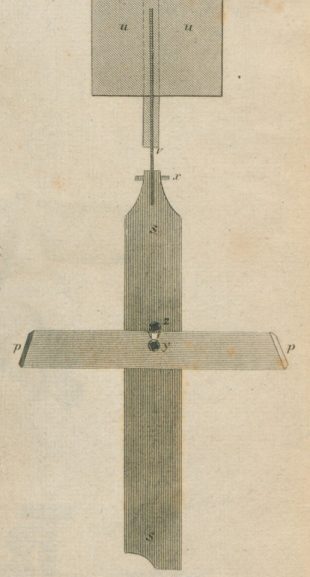
The cross bar of the pendulum. According to Hassler, the ends (marked p,p) on the clocks supplied to him were made from brass once owned by John Harrison. Adapted from Fig.8 from Plate 6 of Papers on various subjects connected with the survey of the coast of the United States by F. R. Hassler (1824) Reproduced under a Creative Commons BY-SA 4.0 license courtesy ETH Z�rich
The first was made by Thomas Gill on 14 July 1818 in his article titled On English and Foreign Copper, Zinc, and Brass that was published in volume 12 of The Annals of Philosophy.
'The late Mr. Harrison made his celebrated time-pieces of old Dutch pan brass; and Mr. Hardy was recently furnished with some of it by the Board of Longitude, in whose hands it had been preserved from the time of Mr. Harrison, to make a timepiece with for the Royal Observatory at Greenwich.'
The second, also by Gill, was published a month later when he made a correction to the above writing:
'Having seen Mr. William Hardy since the publication of my paper, "On English and Foreign Copper, Zinc, and Brass," in your last number of the Annals, he informs me that he had the old Dutch brass of which he made the wheels for the time-piece at the Royal Observatory at Greenwich, not of the Board of Longitude, but of a Mr. Frodsham; and paid him for it at the rate of one guinea per pound! – a proof of the very high estimation in which it is held by watchmakers.'
The third was made in 1823 by Hassler himself who said of the two clocks that Hardy made for him:
'Only the scapements are jewelled in these clocks. The other pinion holes are boxed with brass taken from a piece brought to England from Bengal as a sample, which was given by the Board of Longitude to Mr. Harrison, the first inventor of chronometers. At his death, Mr. Hardy bought it, and uses it with the greatest economy for such purposes. The ends p,p [see diagram] of the cross bar on the pendulum are also lined with this brass.'
The historic locations of the Greenwich clock, the method of mounting and the design of the case
Although Pond published an engraving of the Mural Circle in his first volume of published observations, he failed to show the clock or where it was mounted relative to the telescope. The Circle Room as shown on the 1831 Observatory plan (RGO6/45) shows the room as it was some seven or more years earlier and predates the construction of the pier for the second Mural Circle (which began in January 1824). It shows an unlabelled structure, presumed to be the clock pier, close to the Circle Room wall immediately to the east of the centre of the Troughton Mural Circle. When Airy drew his manuscript plan of the Observatory in 1846 (ADM140/426), it included the pier for the second mural circle on the site previously occupied by the clock, and a new and rather smaller clock pier located against the south wall and roughly equidistant from the two Mural Circles to which a journeyman clock was originally fitted.
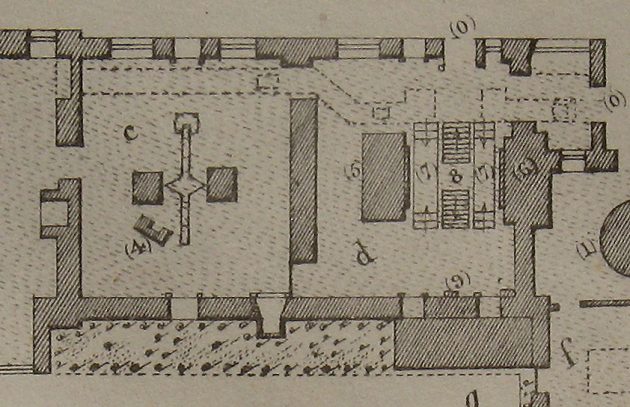
Detail from the plan published in 1847 as an addendum to the 1845 volume of Greenwich Observations (north at the top). It is based on Airy's 1846 manuscript plan (ADM140/426). Key: (c) Transit Room. (d) Circle Room. (4) the pier for the Transit Clock (Hardy from 1823–1850) – note the recess cut into it. (5) the pier for Troughton's Circle. (6) the Pier for Jones's Circle. (7) the pits for the convenience of reading the lower microscopes of the Circles. (8) the stage for reading the upper microscopes of the Circles. (9) the pier for the Circle Room Clock (probably erected here in 1823 or 1824 around the time Hardy was moved to the Transit Room). The large shaded area on the opposite side of the wall to (9) is marked on the manuscript plan as a buttress
The earliest evidence for how the clock Hardy was originally mounted comes from Hardy himself in the letter that he wrote for publication in 1820:
‘The Doctor [Maskelyne] being sensible of the great importance of fixing up the clock upon a material that should be permanent and immoveable, I suggested that it should rest upon a strong brass plate screwed fast to the top of a stone pier, in which a recess or channel might be cut out to receive the weight and the pendulum, which was adopted.’
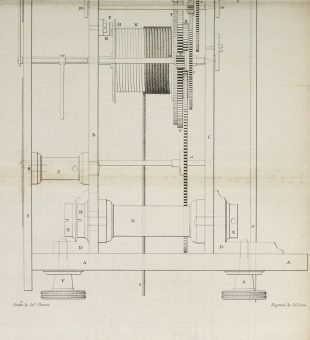
Detail of plate 35 accompanying Hardy's description of his escapement. Drawn by Joseph Clement and engraved by James Davis., it shows a side view of the lower half of a movement that was possibly drawn from life in Hardy's workshop. The dial is on the left. (A) is the brass plate (the seatboard) on which the movement rested. It is about half an inch thick, several inches deep and more than a foot in length. At Greenwich, the seatboard spanned the top of the recess of the stone pier to which it was bolted. It contained piercings through which the pendulum (x) and the cord (5) which supported the driving weight passed. Reproduced from Transactions of the Society Instituted at London for the Encouragement of Arts, Manufactures and Commerce. Volume 38, courtesy of the Wellcome Library & Internet Archive
William Ellis, who started work at the Observatory in 1841 gave this brief description of the clock in his reminisces which were published in The Observatory in 1897:
'The transit clock stood then encased in a stone pier, the pendulum being visible through a plate of glass fixed in front, and if my memory does not deceive me, the letters O and E were painted in black on the stone, one on each side of the glass front.'
Taking into account what both Hardy and Ellis had to say, it would seem either that the movement as well as the pendulum was encased in the stone block or that the clock had a fairly conventional hood, possibly similar to that of the Brisbane and Garnethill clocks.
With its integral stone pier, the Greenwich Clock would not have been easy to move and this might well explain why instead of moving it to the Transit Room in 1816, Pond continued to use Graham 3 there. Eventually, starting in 1821, he dismounted Graham 3 and installed a series of transit clocks in quick succession (some or all of which appear to have been supplied on a trial basis), starting with a clock by Molyneux and Cope. Finally, in late 1823, with work shortly to begin on erecting the pier for the second circle, Pond had Hardy moved into the Transit Room. On 4 November, he recorded in Greenwich Observations: 'Took down the temporary transit clock, and removed Mr. Hardy's clock from the circle room into its place.' How long this took is not clear as no further observations were made until 9 November. Given that observations were made with the Circle on 6 November, it sounds as though the move took a minimum of three days. Given that in 1816, it took no more than eleven days to increase the height of the piers on which the Bird Transit Instrument had been mounted and to get the new Troughton Transit Instrument installed in its place, it is likely that as well as the clock being moved in 1823, the pier was as well, especially as the 1831 plan implies that the two clock piers had the same footprint and the 1846/7 plan (above) shows the pier with a recess cut into it. Further evidence that the pier was moved comes from Pond in his explanation to the Visitors of how Dent's name came to be inscribed on the dial in 1830. In it, he wrote:
'Another clock could not be permanently substituted, as the stone pier is constructed expressly for Mr. Hardy's Clock, so that in this emergency no method of proceeding with the observations appeared so advisable of availing ourselves of Mr. Dent's offer. (RS/MS371/58)'
Normally when things needed doing to the clock, Hardy was involved and Pond recorded this in Greenwich Observations with phrases like 'Mr. Hardy took down the Clock to be cleaned.' or 'Mr. Hardy put up the Clock, and set it nearly with sidereal Time.' Although Hardy was not mentioned by name in the 4 November entry, there are two reasons to believe he was there. Firstly, because on 22 November Pond recorded that Hardy had stopped the clock and fitted a new second hand (presumably because the original was damaged during the move). Secondly because in 1824, Thomas Gill wrote in his Volume 5 of his Technical Repository:
‘We were exceedingly gratified by Mr. Hardy's information, a few days since, that the teeth of the wheels and pinions of his time-piece at the Royal Observatory at Greenwich, were lately examined with magnifiers, by several of our most scientific men, and that not the slightest appearance of rubbing could be perceived upon them, after thirteen years' wear!’
going on to say:
'This is, indeed, a most satisfactory example of the value of the epicycloid, when applied with accuracy to the teeth of wheels and pinions.'
Having been moved, the Greenwich Hardy was to remain in position for just 27 years before being moved again. Being a systematic man, Airy decided that he wanted observations with his new Transit Circle to commence on 1 January 1851 or as soon thereafter as weather permitted. To this end, he had Hardy moved from the Transit Room to the Transit Circle Room towards the end of December. He recorded the following in the 1850 volume of Greenwich Observations.
'December 27, 0h. The transit-clock (Hardy) was removed to the Transit-Circle Room, and a clock by Arnold (A2) was used in its stead.'
What he did not report was that whilst removing the pendulum 'the spring' was broken and a new one had to be specially made in a great hurry by Dent's team (RGO6/723/151–2).
Although Airy informs us that Hardy was placed in a recess built into the brickwork of the pier supporting the south collimator of the Transit Circle, he failed to mention that the upper section where the movement sits is around 18 inches wide, whist the lower section below the seatboard is roughly 14 inches wide. Nor did he mention that a massive cast iron seatboard was substituted for the brass one. In its new location, the movement was no longer accessible from above or from the side. On the assumption that Hardy made the clock broadly in accordance with his published plans, this would also have necessitated altering the way in which the pendulum was suspended (more on this below).
The cast iron seatboard is slightly less wide than the upper part of the recess. Rather than being of a uniform thickness, it has two bracing ribs than run from side to side across the bottom. As a result, the thickness varies from around ½ inch to more than three inches. The corners of the left and right hand edges extend beyond the central section and taper inwards. This presumably made it easier to remove when required. It is not currently known if the seatboard originally sat directly on the brickwork, nor if it was held in place solely by its own weight. Nor is it known if there was some kind of locating lug to ensure it was always returned to the same place.
Airy arranged things so that the dial was in clear view of the observer siting in the pit of the instrument and looking towards the south (see image at the top of the page). As a result, most of the clock was below ground level, with the dial itself being about a foot above the floor of the room. When Airy published his description of the Transit Circle in Appendix 1 of the 1852 volume of Greenwich Observations, he failed to mention how the pendulum was accessed for adjustment and maintenance. If as originally conceived the section of flooring between the collimator pier and pit was removable, this is no longer the case, the floor having been replaced at least twice since the 1960s under the stewardship of the National Maritime Museum.
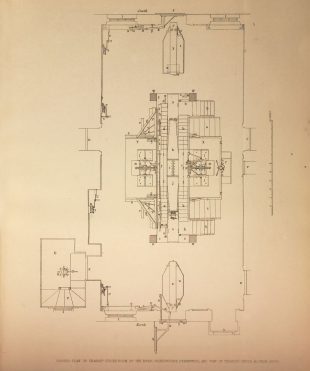
Ground plan of the Transit Circle Room and view of the Transit Circle etc. from above. Adapted from Plate 3 of Airy's description of the Transit Circle published as Appendix 1 of the 1852 volume of Greenwich Observations
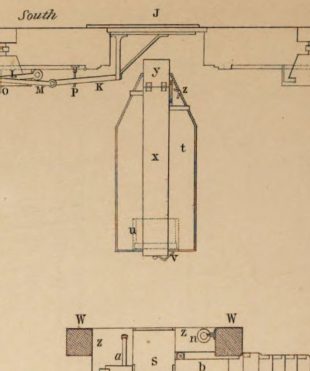
Detail, showing the location of Hardy and the lamp used to illuminate it (key below). Reproduced courtesy of the Munich DigitiZation Center (MDZ) and the Bavarian State Library (BSB).
Key (adapted from Greenwich Observations): Complete Key to plate 3.
| t. | The pier for the south collimator. Made of brick, it was covered with a slab of sandstone. | |
| u. | (Dotted lines,) the recess in the brickwork of the pier below the stone slab, in which the transit clock is placed. | |
| v. | A small projection from the clock case, in which a chronometer was placed when it was being compared with the transit clock (no longer present). | |
| n. | A gas light with its smoke chimney fixed to W for illuminating the transit clock (no longer present). |
|
| x. | Wooden box covering the collimator | |
| W. | Pillars supporting the roof. |
In its new location Hardy was particularly vulnerable to damp, so much so, that in 1861/2 Airy was to tell the Visitors:
'The steel-work of the Transit Clock (which is almost buried in the South Collimator Pier) had been found extremely liable to rust; but holes have been made through those parts of the Pier which encase the clock, permitting a much more free ventilation of the clock than it formerly received: and the rusting seems to have been in great measure prevented.' (1862 Report)
Whilst an improvement, the dampness was still clearly problematic as in 1868 Airy was to tell the Visitors:
'I have given a new form to the head of the clock, for admission of small tin boxes in which a few lumps of quicklime will be placed, in order to keep the air about the wheel-work in a state of dryness.' (1868 Report)
The following year he informed them that the quicklime was changed once a month (1869 Report). After this, there is no further mention of either quicklime or the tin boxes, meaning that it is not possible to know if and when the practice was discontinued.
The damp however remained a problem. In 1874, the clock was absent from the Observatory for around ten to eleven weeks while being refurbished. Having 'become exceedingly rusty', it was absent again in 1878, this time for just over eight weeks as (more on these absences below). Later, in 1905, the then Astronomer Royal William Christie noted in his Report to the Board of Visitors:
'The Clock Hardy, which was much rusted owing to damp weather, has been cleaned by Messrs. Kullberg, who have made alterations in the case to protect the clock from damp as far as possible.'
What the alterations were was not recorded. It is possible that further research in the archives may yield details, but such work is currently beyond the scope of this article.
Regrettably, no records have yet been located that show how the seatboard sat within the recess prior to the clock being put on display by the National Maritime Museum in 1967. Conservation photos taken in 1969 show that at that time the brickwork surrounding the clock was painted black with the seatboard seemingly sitting directly on the brickwork below. At some point, possibly around 1990, when an attempt was made to increase the running time of the clock from 3¾ days to 8 days (more on this below), the recess was lined with what appears to be plywood. The seatboard no longer sits directly on the brickwork but on some kind of a wooden plinth that sits between them. Its left and right hand edges are now concealed by the lining that rises vertically above it. As a consequence, the dial is around 5cm higher than it was before and the seatboard can no longer be easily removed from the recess. The plywood also prevents an inspection of the brickwork for evidence of where the holes may have been made in 1861/2. It should also be noted that the holes have long since been plugged on the outer surface of the pier and there is little indication of where they may have been – though in racking light, one possible location can be picked out on the eastern side.
The piers which supported Troughton's Transit together with the pier on which the transit clock had been mounted were removed at the start of 1851. When the Observatory was turned into a museum, replica piers were erected on the site of the originals. The replica clock pier is rectangular in section and tapering towards the top, with a vertical face on which to mount the clock. It is suspected it was modelled on that shown in a late eighteenth century drawing of the Transit Room, when Graham 3 was mounted there. Purchased in 1966 (Object ID: PAF2956), a year before the building which houses the telescope was opened to the public, it was drawn by John Charnock, probably in the 1790s. The Museum however had a problem on its hands. Hardy, which was loaned by the Astronomer Royal was (rightfully) retained in its 1851 position with the Airy Transit Circle.
The dilemma the Museum faced, was what clock to mount on the replica pier given that it did not own Graham 3 which had been retained by the Royal Greenwich Observatory (RGO). The RGO also retained Graham 1 and Graham 2 until its closure in 1998 when all three being transferred to the museum. To solve its problem the Museum borrowed a Shelton clock from St John's College Cambridge. It remained on loan to the Museum from 1966 until 1992. Today (2023), rather than supporting Graham 3, the replica pier in the Transit Room supports a clock by Hardy which although never used at the Observatory was purchased by the Museum in 1980 (Object ID:ZAA0606). Known as the Jenson Hardy after a previous owner, not only is it mounted in an entirely different way to the Greenwich Hardy, the detailing of the dial is also different. It also lacks the brass seatboard, being supported instead by one of wood (view image) and has an escape wheel of a different design. Interestingly, in 1967, the Museum also borrowed the regulator by Hardy that had been bought in the 1820s by the Cambridge Observatory (now part of the Institute of Astronomy). It was returned to Cambridge in 1981 following the Museum's purchase of the clock mentioned above. It now forms part of the collections of the Whipple Museum (Accession Number 2800).In 1975, volume 3 of Greenwich Observatory by Derek Howse was published. Although Howse was a curator at the National Maritime Museum and a key player in the 1960s in converting the Observatory into a museum, he seems to have believed that the clock was originally supplied and mounted in a conventional wooden case. In the book, he provides a table of key dates in the history of the clock. Against the year 1850 he has recorded 'Movement taken out of wooden case and mounted in Transit Circle Room pit as transit clock'. His successors seem to have taken much the same view and much the same information is currently (2023) given on the Museum's website. It seems probable that Howse was not aware of Hardy's 1820 letter.
When Hardy supplied his clocks to (some?) purchasers, he also supplied instructions on how they should be mounted. Those republished by Pearson began:
'The case must be fixed up to a solid stone pier by the four blocks and screws. The screw holes must be made in the back of the case, where they are marked. The brass plate on which the clock is seated is to be made perfectly horizontal, by placing the spirit-level betwixt the pencil lines drawn thereon. ...'
By contrast, in the description published in 1820 Hardy wrote something completely different:
'AA, plate XXXV, represents the edge of a horizontal brass plate [the seatboard], which must be fixed on two brackets firmly screwed to a stone pedestal or wall, and quite independent of any part of the case of the clock.'
The three different mounting methods published in different locations at different times perhaps help explain the confusion that has existed for so many decades about the way in which the Greenwich Clock was mounted.
The dial
Measuring 297mm across and 3mm thick, the dial was originally silvered brass. The large outer dial indicates the minutes, the small upper dial the seconds and the small lower dial the hours. At some point (date currently unknown), the dial was painted white. This was first vaguely mooted in February 1851 just eight weeks after the clock had been moved for use with the new Transit Circle. Writing to Dent, Airy explained:
'We find that with our new Transit-Circle, in the use of which the observer is somewhat more distant from the clock than he used to be, we have some difficulty in reading the clock-face. This arises from the surface of the clock face; which has been turned on the lathe, and bears the circular furrows produced by the turnings, and always shows a bright line across it. To get rid of this, I wish to know whether you could alter the quality of the surfaces, so as to deprive it of all regular lines. We want a surface, brilliantly white if possible, but at the same time, dead in respect of reflexion, like a surface of flattened paint.
At the same time we want a stronger second band [hand?], and perhaps some of the divisions stronger. ' (RGO6/724/101)
Dent replied explaining that the dial could be made 'dead silver white' and that when varnished would retain its colour. He also stated that the engraving could be made stronger, but that it would take several days to do (RGO6/724/102). Dent's plan appears to have been put into action. In the 1851 volume of Greenwich Observations, Airy recorded that the clock 'was stopped for the purpose of having its dial plate resilvered and made dull to prevent reflexion on its surface'. It was absent from the Observatory from 28 February – 10 March. It would seem however that the dial was still prone to discolouring as a result of tarnishing because when Dent was asked that June if he could make the beat of the clock louder, there was a delay in returning the clock because as Dent explained in a letter to Airy, he had 'found a frenchman to silver the dial plate and varnish it so as to keep its colour' but that he (the frenchman) had taken longer to do the work than promised (RGO6/724/124). The underling of the word varnish by Dent suggests that however the surface was dulled earlier in the year, it was not the result of it being varnished.
Conservation photographs taken in the 1960s show that over the years, the markings around and beneath the winding hole (of the by now painted dial) had been worn or wiped away. This included the pair of outer tram lines of the seconds dial between the 34 and 40 marks and the outer circle of the hour dial between 19.5 & 22.5. The outer circle of the hour dial was also missing between 13.5 & 14.5, whilst the inner circle was missing between 13.5 & 18.5 and 20 & 22.5. The y of Hardy and the numeral 22 on the hour dial also showed signs of crude retouching prior to the dial undergoing conservation treatment at the National Maritime Museum in 1984. Other areas may also have been retouched prior to 1984, but it is not possible to discern this from the photos. What caused the loss is unclear, but the Museum thought that it may have been caused by contact with lubricant that had been subsequently wiped off. This could have occurred, if, as is believed to be the case, lubricant had been applied though the winding hole and had run down the dial.
When the dial was painted the form of Hardy's original engraving is thought to have been retained. It is suspected however that during the 1984 conservation work, the y of Hardy (much of which was missing) was not restored to its original painted form. In its present form, it is quite unlike those that are found on Hardy's other regulators. When Dent changed the clock's escapement for one of his own in 1830 (more on this below), Pond records that he added the following inscription: 'New deadbeat Escapement &c by Dent London A.D. 1830.' (RS/MS/171/58). This is not what is recorded on the dial today, the inscription being an abridged version and missing the words &c., London and the date. Perhaps Dent's inscription as originally engraved was aesthetically unpleasing and later altered for this reason.
The dial has nine drilled holes of varying diameters: four for securing the dial, three for the hands, one for the winding key and one viewing aperture which was cut in 1854 when the clock was adapted for use with the new chronograph and a wheel of 60 teeth was fixed on the escape-wheel-axis. The idea of the hole was to allow the momentary contacts of a set of galvanic springs to be observed as the teeth passed in succession.
There are also two segmental apertures in the seconds dial that have been plugged with brass plates soldered into position. Located between the 10 and 20 and the 40 and 50 marks, their position can just made out in the image above. Probably made by Dent in 1836 when Airy asked him if he could make the beat of the clock louder, they may also have been made in 1851 when Airy asked him if he could make it louder still. They were possibly closed in 1854 following the addition of electrical contacts which rendered most eye and ear observations with the clock obsolete. See below for information on these two sets of alterations regarding the loudness of the clock.
When writing to Dent in 1854 about the creation of the viewing aperture Airy suggested it should be placed in the seconds' dial 'either between 10s and 15s or between 15s and 20s'. He also suggested that the hole should be closed with 'either a door or a glass' adding 'perhaps a door like a plug is best' (RGO6/727/251). In the event, as can be seen in the photo above, neither of these positions was chosen, perhaps on account of the pre-existing segmental aperture. Nor was any kind of door or covering seemingly added. The following year in a letter written to Dent on 19 June (1855), Airy wrote:
'The window in the dial Plate of the Transit Clock may be made much larger. It may be carried quite across the 15s line and nearly to the 10s line, so that we can see the whole length of the galvanic springs.' (RGO6/729/168)
Looking at the dial today, it would appear that if the window was made larger, it was by rather less than Airy was suggesting. Perhaps Dent was loathe to cut into the plugged aperture on the basis that in doing so, the plug might break away and damage the dial.
Dust covers
Although later clocks by Hardy were supplied with internal wooden dust covers such as the one shown here, it is not known if such a cover was supplied with the Greenwich Clock. Its movement does however appear to have had cover plates (now missing) that were screwed to the sides and top, the evidence for this coming from the presence of screw holes drilled into the edge of the front and back plates (which were 7mm thick). It is not known if they were original or added later. Nor is it known when they were removed. The 1984 conservation report also states that a cover plate 'seems' to have once been present on the bottom of the movement, but does not state the evidence for this. Since the front and the back plates sat directly on the seatboard, and assuming that the statement was not made in error, it is not clear why a cover plate would have been fitted in this location.
Depending on exactly how Hardy had originally mounted the Greenwich movement, it may have been possible to examine it without the need to dismount it. Once the Clock had been moved for use with the Transit Circle, it most definitely wasn't possible to examine the movement without completely dismounting it. This would have been true whether or not dust covers were fitted.
The method of cleaning Hardy's clock
Cleaning the escapement was not straight forward. Although Hardy supplied clients with instructions on how the cleaning should be done, together with a pair of wedges that needed to be used in the process, these seem to have been largely lost or forgotten about as the years went by resulting in incorrect procedures being adopted and the escapement damaged. The following was transcribed and published by Pearson from the instructions supplied with his clock:
‘In order to take down the clock to be cleaned, first take off the pulley-weight; then relax the auxiliary springs, and put the wedges beneath the escapement-springs, as before mentioned; loosen the side screw in the bar, take off the pendulum with care, and seat it in the middle of the bracket inside the case, so that it does not touch the pins of the escapement at the top; then take the clock from the case, and remove the escapement entire, by taking out the long-headed screw in the middle of the cock; then carefully clean the faces of the pallets and detents. There must be no oil put to the cross piece on the pendulum, and very little to the pallets of the escapement. The other parts of the clock-work are the same as in common.’
The Movement, the driving weight and the duration of the Greenwich Clock
The first alteration to the Clock came as early as 10 January 1813. The published observations tell us that on that date: 'Before the passage of αAndronodӕ Mr. Hardy put a new weight to the clock.' Unfortunately, no details are known as to how it differed to the original weight. Over the years the driving weight and its configuration appear to have been further altered at least once and possibly three times.
The following description is thought to show how the Clock was configured when it underwent conservation work in 2010. It is taken from the Royal Museums Greenwich website:
‘The movement has exceptionally thick (7mm) arched brass plates [that] are united by five heavy pillars riveted to the backplate and secured by domed blued steel screws with shouldered brass washers. The finely constructed six-wheel train is driven by [a] brass cased weight with integral pulley and triple pulley system to compensate for the short drop of the pendulum chamber. The double line runs on a turned barrel with a sprung C-shaped stop iron mounted to the front flange with a chamfered push piece lying across the nineteenth turn. The barrel is also fitted with Harrison’s maintaining power, a great wheel and a second wheel driving the large hour wheel. All wheels have six straight crossings and are of light construction. The dead-beat escapement with jewelled brass pallets is mounted on the backplate; a sixty-tooth contact wheel with one blank division is mounted to escape wheel arbor between the frontplate and the dial with corresponding view aperture cut into the dial plate.’
In his later regulators Hardy adopted the practice of screwing rather than riveting the pillars to the backplate. The only other examples that have been confirmed as being riveted are the Hardy in the collections of the National Association of Watch & Clock Collectors, Inc in America and the Garnet Hill Regulator. The Brisbane Clock also seems a likely candidate, but no information has been made available as to how the pillars have been secured and no photos are available.
Other information about the movement of the Greenwich Hardy in its current form is as follows:
Barrel grooved for 20 turns.
Train count: 140 128/14 120/16 30/16
Wheel concentric with Great wheel 75. Wheel carrying hour hand 180.
The 1984 conservation report noted: 'Bottoming wear noticeable in all pinions'.
In 1836, Airy asked Dent to make the beat of the clock louder. The correspondence between Dent and Airy suggest that the weight and possibly the pulley system was altered at that time. On 2 December Dent wrote:
'I must then have a weight made with the pulley introduced into it - as it is now, it must be wound on the 7th day otherwise it goes down, and by the introduction of a pulley as stated, it will go the eight days.' (RGO6/715/19)
A new weight may also have been made in 1851 when Dent was asked for a second time to make the clock louder. Writing to Dent on 28 June Airy asked:
'I wish to know whether you think there as any objection to increasing the drop of the escape-wheel-teeth. If you think this may be tried, it would probably be worth while to make a new anchor and pallets, and put a heavier weight on the clock' (RGO6/724/119)
Dent concurred and to this end the clock was removed on 2 July for the work to be carried out. There is no record however to confirm whether or not a heavier weight was provided (RGO6/724/124 & Greenwich Observations 1851).
Conservation photographs taken in 1969, show a weight with a hook on the top hanging from a single pulley unit. The clock Hardy made for Brisbane (which dates from c1815) has a similar arrangement. Other clocks by Hardy for which images were available (three in total) show something different. All show a cylindrical weight with a pulley built into it. In Francis Baily's Clock and the Jensen Clock, the top of the pulley appears to be flush with the top of the weight. In the Cape Clock, it appears to be slightly lower.
Prior to 1864, Airy indicated in the Introductions to the volumes of Greenwich Observations that the Clock was wound once a week on a Monday. From 1864 onwards, he recorded that it was wound twice a week on Mondays and Thursdays, though he didn't indicate why. We do know however from the published observations that the Clock was taken down on 29 April for cleaning and bought back into use on 3 June, suggesting that this may have been when the switch over occurred. However, there is nothing in the correspondence with Dent to indicate that any alterations were made that necessitated such a change (RGO6/742/119&120).
Rate sheets from the National Maritime Museum from 1984 and 1985 record that the clock had a duration of approximately 3¾ days. In 1986, designs were drawn up 'for rendering the Hardy Transit Clock 8 day going'. One element of these was a newly designed driving weight. The conservation records do not show the existing arrangement at that time. Later records seem to suggest that the plan was put into effect in 1993, but there is no clear statement about this. The design does not appear to have been successful as rate sheets for 1993 and 1994 record the duration as 6 days, 23 hours and 15 minutes. This figure however was revised upwards in February 1995. In practice however, the clock frequently stopped between its weekly windings and in mid-2006, the figure for the exact duration was revised once again; this time to 'Approx 7 days only'.
The Museum records indicate that there are two weights now associated with the Clock, but give no further information other than their dimensions (but not their weight). Their object ID's are:
- ZAA0591.1 which appears to be the one that was use in 1969
- ZAA0591.8 which is shorter and tapers towards the top. It appears to be the weight that was designed in 1986
The pendulum
As supplied by Hardy, the clock came with a mercurial pendulum. According to the entry in volume 26 of Rees's Cyclopaedia, which was published in 1819, a Mr. Lowe of Islington calculated the size of the glass vessel for the mercury and that depth to which it needed to be filled (see also). The first modification came in 1828 when: 'Mr Hardy applied a new glass cylinder to the pendulum of the clock containing a column of quicksilver nearly half and inch longer than the former.' (Greenwich Observations,1828).
The present pendulum is a compensated one of zinc & steel. The earliest reference to Hardy having such a pendulum in the Observatory's own publications comes in the Introduction to the 1908 volume of Greenwich Observations and was repeated in the volume for 1909, which was the last volume to have an Introduction. After this date, there appears to be no further mention of the pendulum in the published output of the Observatory.
The pendulum mounting was altered when the clock was moved from the Transit Room into the recess in the collimator pier of the Transit Circle in December 1850. In the new arrangement (which remains) the pendulum is suspended from a heavy cast iron Troughton frame mounted on the cast iron seatboard which is roughly 18 inches wide. In its new location, rather than being fitted with a removable hood, the covering above the movement was an immovable sandstone stab. By altering the suspension arrangement, the likelihood of damaging the movement would have been considerably reduced.
Information about changes and repairs made to the more important clocks was normally published in the Reports of the Astronomer Royal. However, no such information about Hardy's pendulum being replaced was ever included. The location of the more important clocks was also published in the Introductions to the volumes of Greenwich Observations (1836–1909). Information about the type of pendulum was often included as well. Unless a change had taken place, the same information was normally copied over from one year to the next. Sometimes however the need to update the text was overlooked.
It would seem that while preparing the Introduction for the 1907 volume, Christie noticed that the entry for Hardy had not been materially updated since his appointment as Astronomer Royal and that there was no mention of the pendulum in the earlier volumes. The 1907 volume contains the additional sentence 'It has a gridiron pendulum'. This seems most unlikely to be true as fitting such a pendulum would have been a retrograde step. Realising what was undoubtedly his error, Christie changed the wording the following year to 'It has a zinc and steel pendulum'
Although we don't know the precise date when the zinc and steel pendulum was fitted, we know from a list of clocks written out by Christie and dated 21 January 1899, that a zinc and steel pendulum had been fitted by that date (RGO7/45/C6). We also know that Hardy still had a mercury pendulum in 1869 as Airy told the Visitors in his Annual Report that 'Two ounces of quicksilver' had been 'added to the bulb of the Transit-Clock-pendulum'.
The first clocks at the Observatory to have zinc & steel pendulums were all ordered by Airy and delivered in 1871. They were the new sidereal standard, Dent 1906, and the three clocks Dent 1914, 1915 & 1916, which were ordered for the forthcoming 1874 Transit of Venus expeditions. Airy also arranged for zinc & steel pendulums to be fitted to three of the existing Observatory clocks that were being loaned for the expeditions (Earnshaw, Graham 2 & Arnold 2). Prior to the 1882 Transit of Venus Expeditions, five and possibly six of the Dent clocks that had been supplied for the 1874 Expedition with wooden pendulums had them upgraded to zinc and steel. They were Dents 1916, 2010, 2011, 2012, 2016, 2017 and possibly 2015.
In his 1874 Report to the Board of Visitors Airy wrote:
'The clock Hardy, which was in a bad state, has been thoroughly renovated by Messrs. E. Dent & Co., the principal alterations being the substitution of new contact apparatus and of a new escape-pinion for the old parts. While these repairs were being executed, the clock Arnold 1 was placed in the Transit-Circle-pit for use in observations of Circumpolar Stars, &c. The rate of this clock would probably be improved by the substitution of a zinc and steel pendulum (which has been found to answer so well in the Sidereal Standard and Transit of Venus clocks) for its old gridiron pendulum.'
Despite what Airy wrote, Arnold 1 still retained a gridiron pendulum on 1 January 1909 when Christie compiled a list of clocks at the Observatory (RGO7/44). The published results show that Hardy was absent from the Observatory for around ten to eleven weeks in 1874, having been dismounted on 19 February and brought back into use on 5 May. The exact date of its return was not recorded in either the published observations or the journal of the Astronomer Royal or his Chief Assistant.
In his 1878 Report, Airy wrote: 'The clock" Hardy" frequently used with the Transit-Circle, had become exceedingly rusty, and has received extensive repair.' The published results show that Hardy was absent from the Observatory for just over eight weeks, having been sent to Dent on 13 January 1878 and returned on 11 March.
Given that Airy clearly rated the zinc & steel pendulums, it has to be asked: did he have Hardy's pendulum changed for one of zinc & steel in 1874 or 1878, but fail to mention the fact? It seems that this may be what happened as in a letter published in the December 1886 issue of The Horological Journal, Thomas Buckney (the senior partner at E. Dent & Co) says of the clock:
'Now this clock had for some time a mercurial pendulum of the best construction, the mercury being contained in a two-inch iron jar; but its rate was very unsatisfactory.
Some years ago this mercurial pendulum was replaced by a zinc and steel one, the change resulting in a most marked improvement in the going of the clock.'
The first thing to note is that at some point, either the glass jar that Hardy supplied in 1828 was changed for an iron one or more likely, someone (probably Dent) supplied an entirely new mercurial pendulum. The date when this occurred has yet to be found, but we do know that Dent fitted such a pendulum on the choronograph that he began building for the Observatory in 1850 and also on a table clock he made for Airy in about 1838. The second, is that there is no indication in the correspondence between Dent and the Observatory to indicate that the change to a zinc and steel pendulum was made in 1874 (RGO6/752). In light of this, the best that can be presently said is that a zinc and steel pendulum was fitted at some point between 1872 and 1886, with 1878 looking to be the most likely date. Regrettably however, the correspondence for the year 1878 is missing and appears to have been so for some considerable time.
Normally when pendulums of the Observatory clocks were replaced, the original pendulums were kept, and their location recorded in the inventories. This does not appear to have happened in the case of Hardy as neither the original pendulum supplied by Hardy of the pendulum with the iron jar survive. Also now lost is the beat scale, which can be seen to be missing in photographs from the 1960s. It was resilvered in 1874 (RGO6/752/125).
The mysterious iron 'Mounting Stud'
The National Maritime Museum inventory records the presence of what is described as a 'Mounting Stud associated with the clock. Object ID: ZAA0591.4. Probably made of iron and somewhat corroded in the past, there is seemingly no record of where within the clock it was originally located. Since it is painted black, it may have been removed from the brickwork in which the clock was mounted when the wood lining was introduced in the 1990s.
Transit observations made with Hardy and the Troughton Mural Circle (1812–1823)
Observations of North Polar Distance (NPD) began with the newly installed Mural Circle on 11 June 1812. A few days later on 15 June, a separate regular programme of transit observations made with the Mural Circle and the Clock Hardy began continuing until 3 March 1814, at which point they it was abandoned as the Circle was not considered stable enough to allow transits of sufficient accuracy to be made. The last observation to be properly reduced is dated 4 September 1813, suggesting that this particular set of calculations was roughly six months in arrears (RGO5/22).
Throughout this whole period, transit observations had continued to be be made with Bradley's 8-foot Transit Instrument which remained in use until a new transit instrument could be obtained. This was installed in 1816.
On 23 March 1814, as well as continuing his programme of observations of NPD with the Circle using all six of its microscopes, Pond started a smaller programme of observations using just two of them which included a small number of transit observations (typically between 0 and three on each observing day). They were published in Greenwich Observations in a separate section that was initially titled Observations of North Polar Distance made with two microscopes rather than under the heading of Observed Transits with the Mural Circle as they had been previously. These transit observations ceased at the end of 1822. A year later, on 4 November 1823, Hardy was dismounted and moved into the Transit Room for use with the transit telescope.
In 1836, Airy seems to have started a small programme of observing transits with the mural circles in order to check the alignment of their telescopes. Although Pond did not explain the purpose of the transit observations he made with the programme of observations he began in 1814, it was possible that it was at least partly for the same purpose.
On the rating of transit clock
Information on how the transit clock was rated appears just once in the published observations of Maskelyne and not at all in those of Pond. Maskelyne's observations were published in four volumes and between them cover the years 1765–1810. Only the first (published in 1776) includes a preface. On page iii Maskelyne gives the following information:
'The Observations made with the transit instrument are the most numerous of any; besides the transits of the planets, the transits of several fixed stars being observed every day that the weather permits, to be compared with those of the planets, in order to settle their right ascensions, and serving also to determine the clock's rate of going from day to day. The stars commonly made use of for these purposes are those contained in the Tenth of the annexed Tables: which, as they lie near the Equator, move with greater velocity over the Meridian than stars of greater declinations, and they are moreover sufficiently bright to be easily seen in the day-time, when the air is clear, and not liable to be obscured by a small haziness of the air, or the thinner sort of clouds, either by day or night, as smaller stars would be. …
In making computations from the Observations, I deduce the daily rate of the going of the transit clock, from a mean of the differences of transits of the same star at the same wire on different days; in doing of which I make equal use of all the wires. …' Read more.
A somewhat clearer explanation is given by Robert Woodhouse, the Lucasian Professor of Astronomy at Cambridge. In Volume 1 of his A treatise on Astronomy, Theoretical and Practical (1821) he describes the process as follows:
'The practical method of determining the clock's daily rate, that is, its gain or loss during two successive transits of a star, is to subtract the mean meridional passages of certain stars on one day (as shewn by the clock) from the passages of the same stars on the next, or on some following day. The sum of the differences divided by the number of days intervening between the observations, and by the number of stars, is the clock's mean daily rate; to which quotient, or result, should the clock gain, the sign + is affixed; should it lose, the sign -.'
He then goes on to give a practical example based on Maskelyne's observations made with Graham 3 on 23 & 25 January 1798 and the observations made with the same clock by Pond on 6, 7 & 8 August 1816. Although it had no impact on the methodology, it should be pointed out that not only did Woodhouse made transcription errors when copying the data (for example, the Pond observations were actually made on 5, 7 & 8 August), but he also failed to notice that Pond or his Assistants had made an error in one of the calculations of the clock's rate – an error which he then repeated. When using a transit telescope and clock to measure right ascensions, there are further complications due to instrumental errors. As well as discussing these in his Treatise, Woodhouse also discussed them in his 1825 paper: Some Account of the Transit Instrument Made by Mr. Dollond, and Lately Put up at the Cambridge Observatory.
Interestingly, the rate of the Greenwich transit clock as computed from individual 'clock' stars only began to be included in Maskelyne's published observations part way though volume 3 at the start of 1793. To aid the reader, the number of days that had elapsed since the star had been last observed, was also recorded in the column headed 'No. of days. The practice of including the daily rate was continued by Pond, who in 1829, also began publishing on a single sheet, a table showing the error and rate of the clock at 0h sidereal time at different points throughout the year. Two are reproduced in the section below. How these rates were computed from the figures given in the transit observations is not stated.
Meanwhile, back in 1828 Pond's Assistant Thomas Glanville Taylor had supplied information about the rate of Hardy to Edward Sabine who was carrying out experiments at the Observatory on invariable pendulums. Sabine's paper, which was published in Philosophical Transactions the following year, included the actual calculations Taylor made to determine the rate. Based on groups of stars of similar right ascensions, the composite figures differ significantly from the figures of the daily rates based on individual stars that were subsequenly published in Greenwich Observations.
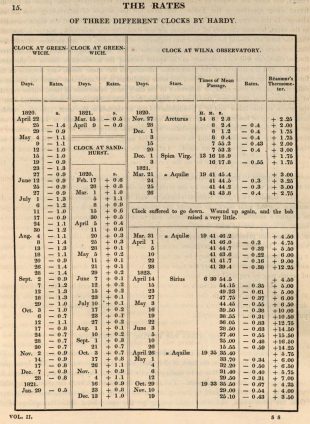
William Pearson's table comparing the rates of three different Hardy regulators. From Vol. 2 of his Introduction to practical astronomy. Digitised by Google from the copy in New York Public Library
The frequency of cleaning of Hardy's escapement
Much has been written about the deterioration in the performance of Hardy's clocks when dirt was allowed to build up on the pallets. Redfern investigated this scientifically, the results being published in 1993 in the article he co-wrote with Woodward, where he also wrote the following about the Greenwich Hardy:
'The improvement in precision over its predecessor, the ageing Graham No 3 (upgraded and jewelled by Arnold) was about 300% – from about 1 second a day to better than 0.4 sec. Unfortunately this degree of accuracy could not be sustained for long periods and the clock required maintenance and adjustment on average every 9 months'
Ten years later, and seemingly drawing on this, Roberts wrote in his book:
'Because Hardy's movements are very sensitive to any build up of dirt on the pallets; it can result in a gaining rate of several seconds a day; they have to be cleaned very regularly. In the case of the Greenwich Clock this was roughly every nine months.'
Neither publication states the source from which the figure of nine months was obtained. Nor is it clear exactly what Redfern meant by 'maintenance and adjustment'.
Although one might expect the Observatory to have kept maintenance logs for all its clocks, this does not appear to have happened. When compiling An account of the going of Mr Hardy's clock with his escapement form its being first put up in 1811 till the escapement was removed in 1830 and Mr Dent's escapement used (RGO5/222), Pond could have drawn most of what he wrote from his published volumes of observations, the contents of which appear to be identical to the manuscript copies now amongst the documents in RGO5. Embedded withing these there is what appears to be a complete (but rudimentary) service and adjustment record for the clock Hardy apart for a period in 1823 when the clock was not being used.
The two tables below, have been compiled using this data along with a small amount of additional material from RGO5/222. What they show is that Hardy's escapement was cleaned nine times over a period of just under 19 years, the average length of time between cleanings being roughly 25 months. This is very different to the 9 months figure quoted by Roberts – so either there are additional records that need to be unearthed or, more likely, Roberts' statement is incorrect.
The tables also show that there were 79 “interventions” during the same period, which equates to roughly one intervention every 3 months on average. They include:
- the 9 cleanings mentioned above
- 3 occasions when the pallets were oiled but the clock wasn’t cleaned
- the clock going down on 8 occasions
- 30 alterations to the pendulum
Table comparing the frequency of cleaning and other interventions of Hardy and Graham
1811 – 1821
Notes:
* indicates the clock being cleaned or having oil applied to the pallets.
The figures in brackets at the end of the relevant entries gives the number of days for which the clock was out of action while being cleaned. (NS) = Not stated.
|
|
|
||||
Year |
Hardy (Mural Circle clock) |
Graham 3 (Transit Clock) |
|||
| 1811 | Apr: Earliest record of the Hardy Clock running at the Observatory (RGO5/222) | Jan 10: 'At noon stopped the Clock 2 Minutes and lowered the bob of the pendulum 2½ divisions on the Nut.' |
|||
| * | Jan 22: 'The Transit Clock was cleaned, and set going nearly with sidereal time.' | ||||
| Jan 31: 'At 19h 20' raised the bob of the pendulum 1½ divisions on the Nut.' |
|||||
| Feb 23: ' At Noon raised the bob of the pendulum 1 division on the Nut.' | |||||
| 1812 | 15 Jun: First published Observation using Hardy |
Jan 1: 'Put back the Transit Clock 2 minutes, and lowered the pendulum a division of the Nut.' | |||
| Aug 9: 'The clock appears to have stopped 2" in winding up on the 10th [Aug].' | Jun 9: 'Raised the pendulum ¾ of a division on the nut, and put the clock 1 minute faster.' | ||||
| * | Oct 1:'The Circle clock was taken down to be cleaned ...' (1?) |
||||
| Oct 9: 'At noon raised the weight of the pendulum about one division of the screw.' | |||||
| * | Nov 9: 'For this day or two past the clock has gone very irregularly, and on examining it the second hand appeared occasionally to pass the second without stopping. Mr. Hardy was sent for, who applied a little oil to the pallets, and the defect seems now removed.' (0) |
||||
| Nov 15: 'Lowered the weight of the Pendulum 3 divisions, and set the Clock nearly with sidereal time.' | |||||
| Nov 25: 'Lowered the weight of the Pendulum 1½ divisions.' | |||||
| Dec 16: 'Raised the weight of the pendulum 1 division.' | |||||
| 1813 | Jan 10: 'Before the passage of αAndronodӕ Mr. Hardy put a new weight to the clock.' | Jan 21: 'Put back the Clock two minutes.' |
|||
| Feb 14: In winding up the Clock the second-hand moved back four or five seconds.' | Oct 1: 'Put back the Transit Clock 1 minute' |
||||
| Jun 15: 'Put forward the Circle Clock two minutes.' | Dec 12: 'Put back the Clock two minutes.' | ||||
| Oct 31: Lowered the weight of the Pendulum two divisions, and set the Clock nearly with sidereal time.' | |||||
| Nov 15: Raised the weight 1¾ divisions' |
|||||
| 1814 | Mar: Programme of observing Transits with the Mural Circle downgraded (see above) |
Jan 30: 'Put back the Clock two minutes.' |
|||
| Mar 27: 'Clock went down.' | Apr 4: 'Put back the Clock two minutes.' | ||||
| * | Dec 9 'Took down the Clock to have it cleaned' (11) | Oct 7: 'Put back the Clock two minutes.' | |||
| 1815 | Jan 1: 'Raised the wight of the Pendulum.' | Jan 2: 'Put back the Transit Clock two minutes' | |||
| Jan 12: 'Lowered the Weight of the Pendulum.' | Jan 17: 'Lowered the Weight of the Pendulum'. | ||||
| Jan 15: 'Let the Clock go down.' | Mar 6: 'Put back the Clock two minutes.' | ||||
| Jul 10: 'Let the Clock go down.' | May 22: 'Put back the Clock two minutes.' | ||||
| Jul 23: 'Put forward the Clock one minute.' |
|||||
| Sep 13: 'Put forward the Clock one minute.' | |||||
| 1816 | Jan 4: Put back the Clock 2 minutes, and lowered the weight of the Pendulum 3 divisions.' | Apr 2: Stopped the Clock, and set it nearly with Sidereal Time.' |
|||
| Mar 23: 'Let the Clock go down.' | |||||
| Jul 22: 'The Clock stopped, having been omitted to be wound up: set it going nearly with sidereal Time.' | * | Aug 5 'The Transit Clock was taken down to be cleaned.' (0) | |||
| * | Jul 29: 'Mr. Hardy took down the clock to be cleaned' (4) |
||||
| Aug 13: 'Stopped the Clock, and lowered the weight of the Pendulum four divisions' | |||||
| Aug 20: 'The Clock for this day of two past has gained considerably: it appeared that the weight of the Pendulum had been moved the wrong way; it has been lowered 9 divisions.' | |||||
| 1817 | Feb 10: 'Stopped the Clock, and set it nearly with sidereal Time.' |
Jan 18: 'Stopped the Clock, and raised the Weight of the Pendulum one division. Set it going again nearly with sidereal Time.' | |||
| Aug 24: 'Stopped the Clock, and set it going again nearly with sidereal Time.' | Feb 10: 'raised the Weight of the Pendulum 2 divisions.' | ||||
| Nov 16: 'Clock went down. Set nearly right with sidereal Time.' |
May 1: In winding up the Clock, the Weight bore against the Pendulum and stopped the Clock 2 or 3 seconds.' | ||||
| * | Aug 8 'The Transit Clock was taken down and cleaned' (0) |
||||
| 1818 | Jan 1: 'Let the Clock go down.' | ||||
| Jan 20: 'Stopped the Clock, and set it going nearly with sidereal Time.' | Jan 20: 'Put back the clock one minute' | ||||
| Apr 5: 'Stopped the Clock, and set it nearly with sidereal Time.' | Mar 8: 'Put back the Clock one minute.' |
||||
| Apr 13: ''Clock went down. Set it nearly with sidereal Time.' | May 2: 'Clock went down. Set it nearly with sidereal Time.' | ||||
| May 25: 'Stopped the Clock, and lowered the weight of the Pendulum 4 divisions, and set it nearly with sidereal Time.' | Jul 21: 'Put back the Clock one minute.' | ||||
| * |
Jun 5 'Mr. Hardy took down the clock to be cleaned' (6) | Sep 4: Lowered the weight of the Pendulum, and set the Clock nearly with sidereal Time.' | |||
| Aug 20: 'Let the Clock go down.' |
* |
Dec 28 'The Transit Clock was cleaned by Mr. Johnson' (0) | |||
| Dec 5: 'Clock went down' | |||||
| 1819 | Jan 3: 'Clock went down' | Jan 1: 'Raised the weight of the Pendulum' | |||
| Jul 30: 'Stopped the Clock, and set it nearly with sidereal Time.' | Jul 18: 'Put back the Clock 1'10".' | ||||
| Oct 28: Clock went down: set it nearly with sidereal Time. | Nov 17: 'Stopped the Clock, and set it nearly to sidereal Time. | ||||
| * | Dec 20 'Mr. Hardy took down the clock to be cleaned' (36). During the clock's carriage to London, the second hand was damaged (RGO5/222) | ||||
| 1820 | Feb 9: 'Raised the weight of the Pendulum,' | Jan 19: Lowered the weight of the Pendulum, and set the Clock nearly with sidereal Time. | |||
| Apr 19: Stopped the Clock and lowered the weight of the Pendulum a division, and set it nearly with sidereal Time.' | Apr 2: 'Found the Transit Clock nearly gone down.' | ||||
| Jun 16: 'Clock went down.' | Dec 31: 'Lowered the Weight of the Pendulum, and set the Clock nearly with sidereal Time.' | ||||
| 1821 | May 18: 'Put the Clock forward one minute.' |
Apr 1: Clock went down | |||
| Jun 22: 'Clock went down.' | Apr 19: 'Raised the weight of the Pendulum, and set the Clock nearly with Sidereal Time'. | ||||
| Sep 10 'The clock was taken down, in order to put up a new one, made by Messrs. Molyneux and Cope.' |
As well as looking at the total number of times each clock was cleaned it it also important to look at the regularity of cleaning. Although Hardy was cleaned more times than Graham 3, it is hard to make any meaningful comparison about how frequently the two clocks needed cleaning.
What is striking however is that when Hardy was cleaned, it was usually out of action for days at a time. This is quite unlike Graham 3 which was always cleaned and put back into service the same day. Caution however is required before jumping to any conclusions. After 3 March 1814, there was no pressing need for the clock to be put back into use as after that date, transit observations made with the Mural Circle were downgraded in importance, with Pond relying solely on those made with the Transit Telescope. Once Hardy had been moved into the Transit Room however, it was important that it should be out of action for as short a time as possible. From them until Dent removed Hardy's escapement in February 1830, the clock seems to have been cleaned and set going again on the same day.
The table below covers the period from the start of 1822 to February 1830 (when Dent replaced Hardy's escapement with a deadbeat escapement of his own).
Cleaning and other interventions of Hardy
Jan 1822 – Feb 1830
Year |
|||
| 1822 | Oct 18: 'Put the Clock forward one Minute.' | ||
| Dec 6: 'Set the Clock forward one minute.' | |||
| 1822 | Dec 30: last published transit observation made with Hardy and the Mural Circle |
||
| 1823 | * | Jan: cleaned (RGO5/222). No transit observations were taken with Hardy using the mural circle during the year. There is no reference to Hardy whatsoever in the published observations for 1823 until Nov 4 |
|
| Nov 4: 'Took down the temporary transit clock, and removed Mr Hardy's clock from the circle room into its place.' | |||
| Nov 22: 'Mr Hardy stopped the clock to put on a new second hand.' | |||
| 1824 | Mar 1: 'Let the clock go down.' | ||
| 1824 | Jul 21: 'Mr Hardy added almost one ounce and a half of quicksilver to the pendulum' | ||
| July 23: 'Raised the weight of the pendulum' | |||
| Aug 3: 'Raised the weight of the pendulum, and set the clock nearly with sidereal time.' | |||
| 1825 | Feb 5: 'Stopped the Clock one minute.' | ||
| * | May 18: 'On the 13th Mr. Troughton put up the transit instrument [which had been taken down on Feb 9th], but on account of the necessary verifications no observations for some days could be made worth recording. On the 18th Mr. Hardy took down the clock to clean it, and on the 21st it was put up again; from which time the observations commence' (3) | ||
| Jun 30: 'Lowered the weight of the Pendulum.' | |||
| * | Nov 24: 'Mr. Hardy stopped the clock to apply some oil; it was set going again nearly at sidereal time' (0). 'The clock was stopped to raise the weight of the pendulum.' |
||
| Nov 26: 'Raised the weight of the pendulum 4 divisions.' | |||
| Nov 29: Lowered the weight of the pendulum.' | |||
| Dec 6: 'Raised the weight of the pendulum'. | |||
| Dec 24: 'Let the Clock go down.' | |||
| 1826 | Jul 27: 'Put back the clock 1 minute' | ||
| Oct 14: 'Let the clock go down' |
|||
| 1827 | * | Feb 21 'Mr. Hardy stopped the clock, to apply fresh oil and make some alterations in the springs of the escapement. A small quantity of mercury was likewise added to the pendulum weight' (0?) | |
| Feb 24: 'Lowered the weight of the pendulum.' |
|||
| Feb 27: 'Found the clock stopped by the weight having broken down.' | |||
| * | Jun 26 'Mr. Hardy cleaned the Clock' (0) | ||
| Dec 28: 'Stopped the clock about 40 seconds, and lowered the weight of the pendulum.' |
|||
| 1828 | Jan 4: 'Let the Clock go down.' | ||
| Apr 29: 'The daily rate of the clock for some time past having been compared with the state of the thermometer, indicated that the pendulum was not sufficiently compensated. The clock was stopped for some time to examine the mercury, and set going again nearly at the same time as before.' |
|||
| May 3: 'Mr. Hardy applied a new glass cylinder to the pendulum of the clock, containing a column of quicksilver nearly half an inch longer than the former.' | |||
| * | May 5 'Mr. Hardy cleaned the clock' (0) | ||
| May 7: 'Raised the weight of the pendulum two divisions.' |
|||
| Jul 5: 'Put the clock forward one minute.' | |||
| 1829 | Jan 22: 'The clock was let down.' | ||
| Feb 18: 'From the observations made during the late cold weather, the want of compensation of the pendulum (before suspected) appeared so evident, that a quantity of quicksilver, about one eighth of an inch in height, was added. The clock was stopped on the occasion, and set going again nearly at the same deviation from sidereal time as before.' | |||
| Feb 20: 'Raised the weight of the pendulum three divisions.' |
|||
| Feb 28: 'Stopped the clock about forty seconds, and lowered the weight of the pendulum two divisions.' | |||
| 1830 | Jan 29: 'Put back the clock two minutes' | ||
| Feb 13: 'After the passage of the Sun, the clock was taken down by Mr. Dent, in order to apply a new escapement, and a clock of his own substituted in the place thereof.' |
|||
1830: Dent replaces the escapement and an argument ensues
In February 1830, Dent replaced Hardy's escapement with a dead-beat one of his own and at the same time, signed his name on the dial. This incensed Hardy so much that he wrote to the Admiralty who by then had taken over all the Board of Ordnance's responsibilities for the funding of the Observatory. The minutes of the meeting of Council of the Royal Society on 28 June 1830 record:
'The Admiralty having transmitted a letter from Mr. Hardy relative to certain alterations made in his clock at the Royal Observatory.
The Astronomer Royal communicated a written explanation on the subject.
Resolved that this explanation be transmitted to the Admiralty pursuant to the recommendation of the Visitors at the last Visitation [which had taken place on 29 May]'. (RGO6/22/197)
It would seem that Hardy was not satisfied with what the Admiralty told him as he wrote again on 14 October. This time his letter was forwarded directly to Pond who was asked for an explanation (RGO5/230/235). Unfortunately, neither of the letters from Hardy can be located. A copy of what appears to be Pond's 'written explanation' (dated 17 June 1830) is however preserved in the Royal Society Archives (RS/MS371/58). Interestingly, it does not appear in RGO6/22 suggesting that it was not transcribed into the minutes of Council. An account of the going of Mr Hardy's clock with his escapement form its being first put up in 1811 till the escapement was removed in 1830 and Mr Dent's escapement used which can be found in RGO5/222 is possibly a copy of the explanation Pond sent to the Admiralty following their October request.
Whatever it was that Hardy was complaining about in his first letter, in Pond's view, as expressed in the 17 June document, the only complaint deserving serious attention was the insertion of Dent's name on the dial. This was addressed by Pond who also provided an explanation as to why Dent was allowed to fit a new escapement. What follows below has been put together from what Pond wrote and the published volumes of Greenwich Observations.
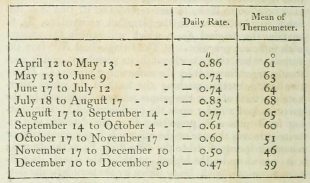
The rate of the Greenwich Hardy from 12 April to 30 December 1811. From Volume 29 of Rees�s Cyclopaedia (1819). Digitised by Internet Archive from the copy at the University of Toronto
Pearson was also of the view that there were issues with Hardy's pendulums, recording the fact in his Practical Astronomy (1829) where he wrote:
'We have had an opportunity of satisfying ourselves, from our own observations, that the principal deviations in the rate of a Hardy's clock, like the one at Greenwich, are attributable to a want of perfect compensation of the pendulum, rather than to any defect in the escapement … .'
In his 'written explanation', Pond wrote:
'About the month of February last, the clock after various unsuccessful experiments (made [over the past two years] by Mr. Hardy himself or by Mr. Taylor [the First Assistant] at Mr Hardy's suggestion,) on the quantity of compensating quicksilver, continued to go very indifferently. Mr Hardy though apprised, by my direction, of the imperfections of his clock not coming down frequently enough to remove or even palliate the inconvenience. And here it must be noticed, that to continue any of the Greenwich observations with an imperfect instrument is doing infinitely more mis-chief than omitting them altogether, since such observations, according to our peculiar method, vibrate the mean, and injure the result of other observations in themselves good. I became, therefore much alarmed at the continued irregularity of this clock.'
Pond continued his explanation by saying: 'At this time I saw Mr.Dent by accident in the transit room.' He then explained that Dent had won the previous year's chronometer trial and had also supplied a 'clock for the chronometer room of very superior excellence [Dent 2]'. When Dent offered to take Hardy's clock and 'make it perform as well' as Dent 2, Pond decided to take up the offer explaining that:
'Another clock could not be permanently substituted, as the stone pier is constructed expressly for Mr. Hardy's clock, so that in this emergency no method of proceeding with the observations appeared as advisable as availing ourselves of Mr. Dent's offer. ... It should be further stated that the whole of the above transaction took place under the impression on my mind that Mr. Hardy was prevented by indisposion from giving the necessary attention [to the clock].'
This was all very well, but it leaves a lot of questions unanswered. Firstly, what was Dent doing in the Transit Room? Secondly, why did Pond not simply bring a clock from elsewhere in the Observatory for use temporarily while awaiting for Hardy to come?
Whilst it was true that the way the Hardy Clock was mounted in the Transit Room prevented another clock from being mounted temporarily in its place on the same pier, there was nothing to stop one from being mounted on the south wall of the Transit Room in the same location that the Transit Clock (Graham 3) had occupied from 1750 until 1780. We know however that Graham 3 was not available as it was in use by Sabine for his pendulum experiments that were taking place at the far end of the building. Likewise, Dent 2 was in use in the chronometer Room and Earnshaw was in use in with Pond's 25-foot Great Zenith Tube. But what of the two clocks by Arnold or the other two clocks by Graham?
What Pond did not include in his 'written explanation' was that when Dent took Hardy away, a clock of Dent's own was substituted as the Transit Clock. It remained in use for just over six weeks until clock Hardy was returned. This was the only time that another clock was substituted for Hardy during the whole of Pond's tenure, suggesting he was rather averse to the concept of a reserve Transit Clock. Airy had no such qualms, making use of Graham 1, Graham 2 and Arnold 2 in the period 1836–1850.
As far as Dent putting his name on the dial was concerned, Pond did not either authorise it or condone it and believed that it was done 'in a manner likely to cause offence'. As mentioned above, Dent's inscription read: 'New deadbeat Escapement &c by Dent London A.D. 1830'. When Dent was challenged by Pond about this, he justified himself by 'contending that his escapement was entitled to a Public trial, and objected to the removal of his name without at the same time removing the escapement also'. With that threat in mind and no doubt recalling Hardy's own threat to remove the clock unless he was paid the full £325 asking price, Pond thought that the continuance of the observations without further sources of interruption was more important than any other consideration, going on to comment that the clock had run well after the alteration and had continued to do so.
Looking back to the trial of Hardy's escapement in 1807, it is worth asking if Hardy was guilty of a similar and perhaps worse naming offense to that of which he accused Dent? We know from what he wrote in 1820 that he fitted his own escapement onto an existing clock by another maker. That clock is believed to be one that is very clearly signed 'Raymond London' on the backplate but has a dial that states that Hardy both invented and built the clock – which is manifestly untrue. It is signed 'Willm. Hardy/ Invt. et Fecit/ London/ No.2'. Click here to view. Whatever the rights and wrongs of Dent adding his inscription to the Greenwich Hardy, at least what he wrote was true.
Towards the end of his Account of the going of Mr Hardy's clock (RGO5/222), Pond wrote:
'In 1829, February in consequence of the acceleration of its mean rate being so great, during a period of very cold weather, a quantity of mercury about 1/8 of an inch was added, and at the close of the [?]same year and the beginning of 1830, during a continuous period of cold weather it had accelerated on its mean rate nearly 4 seconds pr. day and notice was twice given to Mr Hardy to attend and in consequence of his not complying the case was refered to M. Dent'.
As an aside, it should be noted that although the phrase 'accelerated on its mean rate nearly 4 seconds pr. day' was accurately transcribed by Allix (1990), it was possibly misunderstood by him and most certainly misunderstood by Roberts (2003) who changed what Pond had said writing instead: 'In 1830 the clock's rate went up by nearly four seconds a day.' Wood (1992) also appears to have fallen into the same trap, writing in more general terms that dirt was 'responsible for a sharply accelerating gaining rate of several seconds a day'. It's daily rate did not increase by anything like this amount as can be seen from the tables below that were published by Pond in the1829 and 1830 volumes of Greenwich Observations.
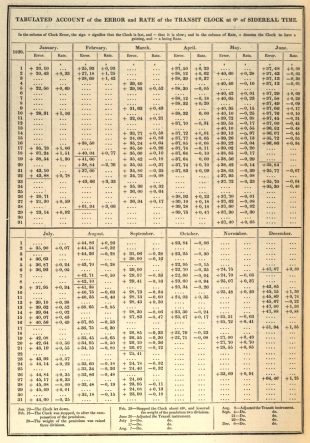
Tabulated account of the error and rate of the Transit Clock in 1829. Digitized by Google from the 1829 volume of Greenwich Observations at the University of Princeton
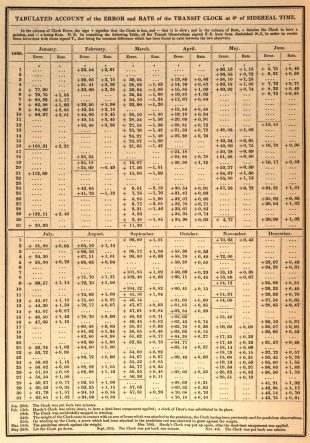
Tabulated account of the error and rate of the Transit Clock in 1830. Digitized by Google from the 1830 volume of Greenwich Observations at the University of Princeton
Meanwhile, in the late 1820s, John Wrottesley, a founding member of the Royal Astronomical Society, had begun constructing an observatory at his house which stood less than half a mile to the south of the Royal Observatory in Montpelier Row in Blackheath. Wrottesley appears to have been on good terms with the staff at Greenwich as his published catalogue of stars tells us that the staff of the Royal Observatory helped him determine the longitude of his observatory. It also gives the following rather intriguing information about his transit clock:
‘On the 1st of December, 1829, a clock with the dead-beat escapement, and having a mercurial compensation pendulum, was fixed to the pier above described. The wheel-work of this instrument is by Hardy, but the pendulum was made by Mr. William Richardson of the Royal Observatory. The beat of this clock is remarkably clear and loud, and is heard distinctly in very stormy weather. The arc of vibration of the pendulum was, in June 1831, 4° 47':5, and in February 1835, and now (September 1835), it is 4° 55'. This clock was subjected to a severe trial, by being set up in a new and damp building immediately anterior to the commencement of a winter so intensely cold as that of 1829-30; but I have no ground to suspect that any portion of the works was permanently affected by it.’
As well as having knowledge of Wrottesley's clock, Richardson also observed from time to time with the Transit Telescope at Greenwich. This raises several intriguing questions:
- Did Richardson's knowledge of Wrottesley's clock influence Pond's decision to allow Dent to change the escapement for a deadbeat one?
- Why did Wrottesley's clock have a dead-beat escapement rather than Hardy's own?
- Was Hardy's escapement more affected by cold weather than a dead-beat one?
Writing in 1841, William Pearson made the following observation of a problem that he had noted with the escapement on his Hardy regulator:
'It was found, however, from experience, that when oil of a common quality was applied to the pallet wheel, it was injurious to the performance, by causing the parallel pins of the impelling and locking springs to adhere a little to each other, so as to require some force to separate them at each vibration; but as the impulse is given by a direct push, no oil is necessary in this part of the machine, and but little on the pivots, as the holes are jewelled.' (MMRAS Vol 15, p.108 (1846))
Some 50 years later in the early 1890s Gill made the following comment about lubricating oil causing problems with his then transit clock at the Cape:
'Dent 2013, belonging to the Observatory was substituted for “Hardy” on 1888 January 25. Dent 2013 has a dead-beat escapement and a zinc and iron compensation pendulum (Dent's pattern); its rate, although better than that of “Hardy,” is not satisfactory, being considerably affected not only by changes of barometric pressure, but by secular changes of irregular character apparently due to change in the consistency of the oil.'
An examination of the temperatures recorded at the Royal Observatory shows that the temperature inside the Circle Room was more or less permanently below 0oC (32oF) from the middle of January 1830 until at least 5 February. It seems highly likely that the temperature in the Transit Room was much the same. Although it is not known what oil Hardy had used to lubricate the Clock at Greenwich, we do know that Maskelyne applied an oil made of 'an equal Mixture of Olive Oil and Oil of Sweet Almonds' to the pallets of the Transit Clock (Graham 3) in 1781 and that in 1807 he 'cleaned away all the dirty oil from the swing wheel and pallets of the verge; then put a little of the best olive oil to them'.
As noted above, when writing not long after the escapement had been replaced, Pond recorded that in the short time since the clock had been running again its rate appeared to be more regular. (RGO5/222). In the same document however (which documented the clock's history since its arrival in 1811), Pond indicated that the clock had had problems in very cold weather in every year beginning in 1812 and that he believed that the problem was related to the compensation provided by the pendulum rather than the escapement. Hardy presumably agreed, since it was he who changed the jar for the mercury in 1828. Perhaps Pond was still in some doubt as to whether Dent had really solved the problem as he continued to produce Tabulated accounts of the error and rate of the Transit Clock similar to those that he produced for the years 1829 and 1830 (reproduced above). They were seemingly discontinued by Airy in 1836.
Tabulated account of the error and rate of the Transit Clock in 1831*
Tabulated account of the error and rate of the Transit Clock in 1832*
Tabulated account of the error and rate of the Transit Clock in 1833
Tabulated account of the error and rate of the Transit Clock in 1834
Tabulated account of the error and rate of the Transit Clock in 1835
* Contains no notes about interventions to the clock or telescope
In 1852, James Glaisher produced a set of tables titled: Determination of the mean temperature of every day in the year, as deduced from the observations taken at the Royal Observatory, Greenwich, in the years from 1814 to 1851 (RS/AP/34/7). Now digitised by the Royal Society, but originally unpublished because of Glaisher's methodology (which was criticised by the referee Humphrey Lloyd (RS/RR/2/71)), the tables do give a useful overview of the kinds of temperature to which the Greenwich Hardy was subjected at different times.
The table below has been compiled from the data in Pond's seven years worth of tabulated accounts. Each new period commences immediately after the pendulum had been adjusted or after the clock had been cleaned. The clock's best performance appears to have been when it was new, Pond recording that 'its daily rate from April [1811] to the end of the year was remarkably uniform, it extreme variation being only 0.39s' (RGO5/222).
Period |
No. of
|
Lowest daily rate |
Highest daily rate |
Extreme
|
||
| 1829 Feb 29–1830 Feb 13 | 349 | -0.85 (1829 Aug 13) |
+3.26 (1830 Feb 12) |
4.11 | H | |
| 1830 Mar 31–1831 Dec 12 | 622 | +0.11 (1830 Sep 27) |
+2.49 (1831 Nov 20) |
2.38 | D | |
| 1832 Jan 04–-1834 Apr 08 |
825 | -1.08 (1832 Dec 13) |
+0.72 (1834 Mar 26) |
1.80 | D | |
| 1834 Apr 10–1835 Apr 03 | 359 | -1.42 (1835 Mar 26) |
+0.20 (1834 Oct 18) |
1.62 | D | |
| 1835 Apr 03–1835 Dec 31 | 273 | +0.03 (1835 Apr 07 |
+1.68 (1835 Dec 26) |
1.65 | D |
H=Hardy's escapement. D=Dent's escapement
Looking at the table, it is difficult to judge just how much difference changing the escapement made. Adjustments to the pendulum or the cleaning of the clock only happened when the daily rate was found to be changing at an unacceptable rate. It was a matter of judgement on Pond's part about when to intervene. If slightly shorter periods than those above are considered instead, the size of the extreme variation is much reduced. For example, if during the first period, Dec 31 1829 is taken as the end date, the extreme variation in the rate is reduced from 4.11 to 2.68.
Meanwhile Wrottesley's clock seems to have continued to perform well. In 1842, he relocated his observatory to Wrottesley Hall in Staffordshire taking his transit clock with him. In 1854, he described it as follows:
'The Hardy or transit clock has behaved exceedingly well during the whole course of the observations; the rate has been remarkably steady, and the beat is, as before loud and distinct. This is, indeed an admirable mechanism, and of all the instruments in my observatory has given me the most unalloyed satisfaction.' (Journal of Science and Art)
Following Wrottesley's death in 1867, the clock was put up for sale with the following description. 'The clock, by Hardy, is a very good one, there being no difference between its summer and winter rates.' (MNRAS, Vol.28, p.126). The fact that the clock was referred to in both 1854 and 1867 as being by Hardy suggests that at the very least, the dial carried Hardy's name.
Unfortunately most of the Wrottesley family papers were destroyed when Wrottesley Hall burnt down in 1897, meaning that significant further information on the history of the clock is unlikely to come to light.
As an aside, it is worth recording that as well as making the pendulum for Wrottesley's clock, Richardson made a similar pendulum that was fitted to Graham 3. Signed: RICHARDSON Royal Observatory, but undated, it was still in use at Herstmonceux in 1975 (Howse 1975), it is now in the care of the National Maritime Museum, a photo of it can be seen here.
1836: Dent is asked to clean the clock, remove the jewelled bearings if thought necessary, and to make the beat of the clock louder
In 1829, the Hardy clock at the Cambridge Observatory (which still has its original escapement) was recorded by its then Director, George Airy, as being noteworthy 'for the general steadiness of its rate, as [well as] for the loudness and unusual distinctness of its beat' (Cambridge Observations, Vol 1, 1829). Likewise, McClear said of the Hardy at the Cape:
'This was meant to be the transit-clock (for which it is peculiarly fitted by its loud sharp beat), ... I propose, therefore, to send the clock home [to England] for examination and repair, which I hope may be successful, as its excellent beat renders it a most desirable observing-clock.' (MNRAS Vol. 20, (1851))
By comparison, the Greenwich clock seems to have been (or become) much quieter – perhaps an unintended consequence of Dent substituting a dead-beat escapement for Hardy's or perhaps because of the different type of dust cover and case that the Greenwich clock may have had.
On 15 November 1836, a year after arriving at Greenwich as Astronomer Royal, Airy wrote to Arnold & Dent for the first time about the Greenwich Hardy. His letter began:
'I request that you will send a competent person to take down the Transit Clock for cleaning, and if you think necessary to remove the jewels from the pivot holes.' (RGO6/715/16)
Airy also asked for Arnold 2 to be moved from the Western Dome (western summerhouse) to the Transit Room and fitted up in 'a temporary manner' for use as the transit clock while Hardy was away. At this point, there was no mention of making the clock louder. Dent was not able to come immediately as he had a cold, but come instead three days later on 18 November while Airy was away in Bedfordshire (RGO6/24/12 & RGO6/784 & Greenwich Obs). It was possibly then that discussions took place about the loudness of the beat and a plan of action to make it louder.
Although the subsequent exchange of letters fills in some of the detail about how this was done, much information is lacking. Not only this, it is difficult to interpret due to our lack of knowledge of
- the location and nature of the flap(s) that are mentioned,
- the design of the case and the hood
- how Dent mounted the clock in his workshop (he presumably did not take the stone mounting block with him).
The first letter to mention the clock being made louder comes in one that Dent wrote to Airy on 23 November (1836):
'I shall be obliged by your appointing a time for me to wait on you respecting the opening made in front of Transit Clock for the escape of sound.' (RGO6/715/18)
The clock was returned to Greenwich on 2 December and set going again. It is possible that the two segmental apertures in the seconds dial (now plugged) were created at this time. It is also possible however that they were introduced when Dent was asked for a second time to make the clock louder following its installation in the collimator pier of the Transit Circle in 1850 (see below). On the same day that the clock was returned, Dent wrote to Airy saying:
'I beg to inform you that I was unable to jud[g]e of the loudness of the beat etc. of your Transit Clock, by the noise occasioned by the high wind and the other clock. – I have protected the aperture by wire gauze, and having left the clock with a considerably lighter weight than before. I shall be obliged by you letting me know, if the sound is sufficient loud and what is the semi arc of vibration, I must then have a weight made with the pulley introduced into it. as it is now, it must be wound on the 7th. day otherwise it goes down, and by the introduction of the pulley as stated, it will go the eight days.' (RGO6/715/19)
In his reply (dated 5 December 1836) Airy wrote:
'The beat is by no means so loud as that of the clock Arnold near it, and in the judgement of the Transit Observer is not so loud as it was when the lower flap was opened, but louder than it was when the lower flap was shut. The side holes are not in the place which I understood, and I think that being in front would have been better. If you see no objection I will try with the gauze off the side holes.' (RGO6/715/20)
Airy also mentioned that when the clock was wound earlier in the day it either 'stopped or its hand tipped back.' It was returned the following day (6 December) to Dent's workshop. This was followed up the next day with a letter from Airy about the going springs (maintaining power spring). The clock was returned to Greenwich on 10 December (Greenwich Obs).
Although the letters does not record the fate of the jeweling, Dent did in fact remove it, the fact being recorded in Introduction to the 1836 volume of Greenwich Observations as well as the Introductions to the subsequent volumes where Airy stated: 'The jewelled holes were removed by Dent in December 1836, and the pivots now turn in brass holes.'
In 1849 when carrying our work on the clock, Dent made the following comment in a letter to Airy:
'Permit me to observe that in former times when the large holes were jewelled the clock required cleaning from the thickness of the oil in a year. Since you sanctioned the removal of the jewel holes, for those of brass, it has not only gone for years, but the oil was still fluid & had it not been for the friction of the going-work would have gone for a much longer time.' (RGO6/722/18)
The preservation of Hardy's escapement and the parts removed by Dent in 1836
Hardy's escapement was returned to the Observatory either immediately following its removal or at the later request of Airy to whom its preservation was important. Likewise, the items removed by Dent in 1836. Both the escapement and the other items are now lost. The former survived until at least 1933 and the latter until at least 1864.
The various inventories record the following:
1840, May 15 Inventory, In the Octagon Room: Hardy's escapement (item 83); 'Old work of the transit clock, removed in 1836' (item 96). (RGO6/54/77 & RGO39/1/6).
1864 Inventory. In lower room of Great Equatorial Building (which at this time was a bit of a dumping ground): Escapement (item 79); 'Old work' (item 112).
1911 Inventory, escapement recorded as being in 'New Chronometer Room' in the Great Equatorial Building (RGO39/4/131). 'Old work' not found.
1926 Inventory. Escapement still present in the 'New Chronometer Room' (RGO39/5/233). 'Old work' not found.
1933 inventory (RGO39/6/221), Escapement still present in the 'New Chronometer Room', but the location of has been later crossed out and altered to 'Time Depart[ment]'.
For reasons yet to be established, the Admiralty instructed Airy to send Hardy's escapement to them during the reporting year 1839/40 (1840 Report ). It was eventually returned in 1843/44 (1844 Report ).
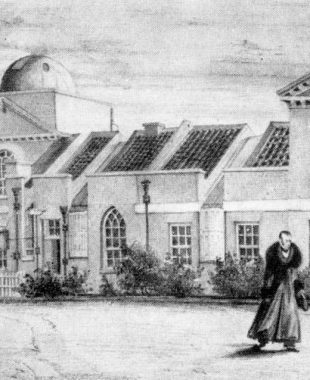
The Circle Room (left) and Transit Room (right) as viewed from the courtyard in 1839. Hardy would have been observed though the window to the right of the drainpipe. Detail from a drawing by Elizabeth Smith, 11 February 1839
The direct use of Hardy for an eclipse observation
On Saturday 25 April 1846, four telescopes were set up around the observatory to observe and time the start of the hybrid solar eclipse that was due to start at just after 5.30 in the afternoon. The circumstances of the eclipse were such, that when viewed from Greenwich, it started just after the sun had passed due west in its passage across the sky. This enabled it to be viewed with a portable telescope set up in the courtyard next to the Meridian Building (which was aligned east-west). From this position, it was observed with the 46-inch achromatic, and timed by observing the Clock Hardy though the Transit Room window. It is thought to have been the only eclipse observation ever to have been directly timed with Hardy.
Two other portable telescopes were set up elsewhere in the observatory grounds with solar chronometers being used to do the timings. The fourth telescope was one of the Observatory's fixed telescopes – the Shuckburgh Telescope, which was located in the North-East Dome. There, the eclipse was timed with the clock Arnold 1, which at the time, was permanently installed there.
The observations were published in the 1846 volume of Greenwich Observations. When consulting the volume, it should be remembered that until 1925, astronomers always began their days at midday rather than at midnight.
Time comparisons with the Altazimuth clock
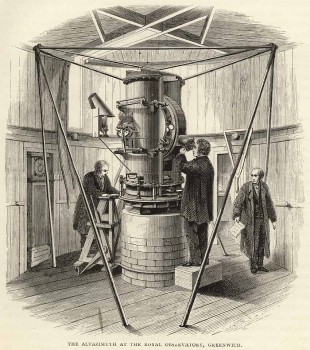
Airy's Altazimuth Telescope. The clock Graham 1, which was initially used to time the observations, can be seen in the alcove in the left. First published in an article by Edwin Dunkin in the 1862 volume of The Leisure Hour, the image was later reprinted in the 1891 edition of Dunkin's The Midnight Sky. Probably based on the image first published by Airy in 1847, the inclusion of the three figures helps gives the instrument a sense of scale
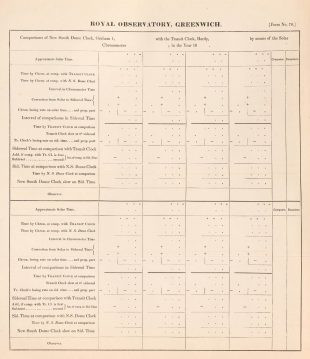
This form was produced by Airy in the late 1840s for comparing the sidereal time shown by the Graham 1 with the sidereal time shown by the Transit Clock Hardy, by means of a Solar Chronometer. The introduction of the chronograph in 1854 allowed most observations of transits taken with the Altazimuth to be timed directly with Hardy without the need for such a comparison to be made (see below). Specimen copy of Form No. 70 from the 1845 volume of Greenwich Observations (published in 1847). Reproduced courtesy of Bayerischen Staatsbibliothek under a No Copyright - Non-Commercial Use Only license (see below)
One of the necessary steps in the process of reducing the observations was to standardise the times shown by the two clocks. The process was described by Airy in the 1847 volume of Greenwich Observations as follows:
'The comparisons of the Transit Clock [Hardy] and the Clock of the New South Dome used with the Altitude and Azimuth Instrument (Graham 1) are made by means of a solar chronometer (Parkinson and Frodsham 1826), the chronometer is brought close to each of the clocks, and the time of accurate coincidence of beats is noted ; the chronometer-intervals between the comparisons, which is sensibly Solar Time, is converted into Sidereal Time; and the sidereal time at the comparison with the transit-clock, being found by correcting the transit-clock-time for error and rate of the transit-clock, the sidereal time at the comparison with the New South Dome Clock is found, and thus the Error of that Clock is ascertained. From the successive Errors, rates of the Clock are deduced, and the Errors applicable to the observations, and which are given in the sections of Azimuth and Zenith Distance, are computed.'
The same method of was used to compare Graham 1 with Hardy throughout the working life of the telescope, though the actual solar chronometer (which always showed mean solar time) varied. The same technique was presumably used with the other sidereal clocks in the Observatory when the times recorded on them needed to be referred back to Hardy.
1850: Hardy is moved for use with the new Transit Circle and two unanticipated problems arise
By the end of 1850, Airy's Transit Circle had been erected in the room that had housed the Mural Circles. All that remained to be done for it to be brought into use at the start of 1851 was to transfer Hardy from the Transit Room to its new home in the specially created recess beneath the south collimator (in which position it is preserved today). The details of the preparations that Airy made have not yet been located, but some considerable planning must have been involved as it was at this time that the movement is believed to have dismounted from its original seatboard and mounted on the present one of cast iron. The 1850 volume of Greenwich Observations 1850 records the move as follows
'December 27, 0h. The transit-clock (Hardy) was removed to the Transit-Circle Room, and a clock by Arnold (A2) was used in its stead.'
The move was not entirely successful as whilst removing the pendulum 'the spring' was broken and a new one had to be specially made in a great hurry by Dent's team (RGO6/723/151-2) in order that the clock was ready (weather permitting) for the first observation with the new telescope to be made on 1 January.
In planning the move, it seems that Airy failed to properly take into account its impact on the visibility of the dial and the audibility of the beat. Writing to Dent on 26 February Airy began:
'We find that with our new Transit-Circle, in the use of which the observer is somewhat more distant from the clock than he used to be, we have some difficulties reading the clock-face. ... '
It ended as follows:
'If you find the gutta percha tube advantageous for hearing, I should like to try it on this clock as its beat is rather faint.' (RGO6/724/101)
The problem with the dial was dealt with straight away and have been covered in an earlier section (above). The problem of the distinctness of the beat remained unresolved until Airy raised the matter for a second time with Dent on 28 June (1851), writing:
'I wish to know whether you think there as any objection to increasing the drop of the escape-wheel-teeth. If you think this may be tried, it would probably be worth while to make a new anchor and pallets, and put a heavier weight on the clock' (RGO6/724/119)
Dent concurred and to this end the clock was removed on 2 July for the work to be carried out. There is no record about whether a heavier weight was provided. Hardy was reinstated on 25 July having also had additional work carried out on the dial. (RGO6/724/124 & Greenwich Observations 1851).
1854: The introduction of a chronograph and the subsequent alterations made to Hardy
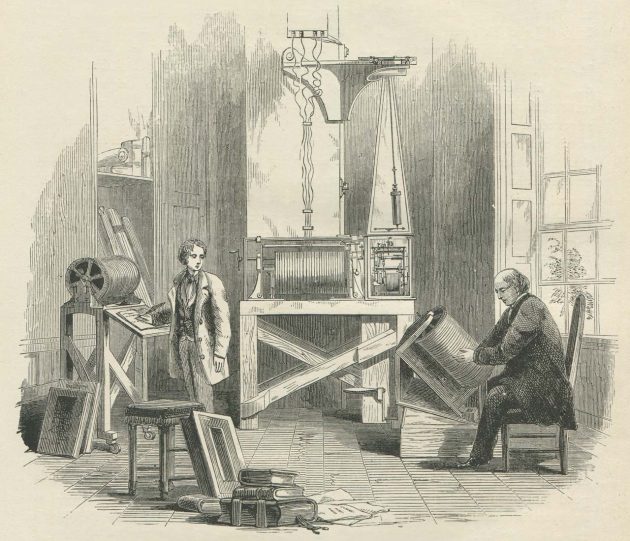
Looking northwards in the Chronograph Room. The chronograph is standing on the table in the centre, its conical pendulum being independently supported by a bracket attached to the telescope pier. The person on the right appears to be loading a new recording sheet onto the drum, whilst the one on the left appears to be transcribing the results from another. Originally published in the 1862 volume of The Leisure Hour, the image was later reused in the 1891 edition of Dunkin's The Midnight Sky, which is where this copy comes from
'Before describing the recording apparatus, it is necessary, however, to state that the original method of observing transits consists in counting the beats of a clock, and estimating the fraction of a second when the object passed one of the wires in the telescope. The clock-time is then entered into the observer's book, the operation being repeated as many times as the number of wires. The new method of observation, or the chronographic method, is much more simple when the registering apparatus is in good working order.
The chronographic recording apparatus is placed in the ground floor of the north dome [i.e. the eastern summerhouse]. The clock, which is of peculiar construction, the motion being governed by the conical rotation of a pendulum, gives a sensibly uniform motion to a revolving brass barrel, which is in connection with it. The barrel is covered with woollen cloth, upon which a sheet of paper is folded, the ends of the paper being gummed together. A spindle which is attached to the clock turns two long screws, causing a travelling frame to traverse the whole length of the barrel. This frame carries two levers, each armed at one end with a pricking point, mounted in such a way that, when the opposite end of the lever is pulled away from the barrel, the pricking end is pushed against it, and makes a permanent puncture on the paper. Two galvanic magnets are fixed on the travelling frame, so as to attract the lever ends opposite to the pricking points. All that is required, therefore, to cause those points to make punctures upon the paper, is to send galvanic currents through the magnets.
One of the prickers is devoted to the registration of the seconds of the clock in the transit-circle room, the communication being made by wires connecting the clock with the travelling frame. The other pricker is used for the registration of the times of observation when a star passes behind a wire in the telescope, a similar communication with wires being made. For the proper generation of the galvanic force, a voltaic battery is included in the circuit of each course of wires.
On this recording instrument, therefore, nearly all transits observed with the transit-circle, altazimuth, or great equatorial, are permanently registered. They are extracted from the sheets, and converted into figures on the following morning-an operation requiring care, but which, in skilled readers, is not considered a very difficult proceeding.'
When first introduced, Airy had hoped that the pendulum of the chronograph could be used for marking intervals of a second on the sheet. This proved unsuitable and Hardy was adapted to provide the signals instead. This too was not straight forward as Airy had to change to make two subsequent changes to the way he did it. The last of these was made in 1856. Airy explained what had happened prior to 26 May 1854 in his Report to the Board of Visitors:
'The Barrel-Apparatus for the American method of Transits has been practically brought into use: not, however, without a succession of difficulties, arising sometimes from causes very hard to discover. When the instrument was approaching to a serviceable state, there still remained an imperfection in the ill-defined form of the punctures on the paper. At this juncture, Lieutenant Maury, U.S.N., paid me a brief visit, and in the course of inspection of the instruments he alluded to this very defect, and to the method which had been used in America for its remedy. Although my apparatus did not admit of the same application, yet, possessed of the principle, I had no difficulty in embodying it in a form adapted to my wants; the prickers were mounted on springs, and now the punctures are perfectly round. The paper on which the punctures are to be made is folded in a wet state, upon a brass cylinder covered with a single thickness of tailor's woollen cloth, and has its edges united by glue.
The punctures, it will be remembered, are produced by two systems of prickers, which have nothing in common except that they are carried by the same travelling frame, which moves slowly in the direction of the barrel-axis while the barrel revolves beneath it. These require separate notice.
One pricker is driven by a galvanic magnet whose galvanic circuit is completed at every second of sidereal time. It was at first intended by me that the completion of the circuit should be effected by the same smooth-motion clock (regulated by a conical pendulum) which drives the barrel. I found, however, that I could not ensure such a constancy in the radial arc of the pendulum as would make its rate sufficiently uniform to entitle it to be considered as the fundamental clock; and, moreover, there was a little difficulty in referring its indications to those of the transit-clock (which must be used in some cases). I, therefore, carried wires from the pricker-magnet to the transit-clock, connected there with springs whose contact is made at every second by the transit-clock. At first, the contact was made by the touch of a pin fixed in the pendulum-rod; and this construction for a time answered well. But it so happens that, in our transit-clock, the pendulum is carried by one frame, and the point of attachment of the galvanic springs by a different frame: it was impossible to maintain these in steady adjustment; and the rate of the clock was sensibly disturbed. I have now adopted the following construction, which promises to succeed better. A wheel of 60 teeth is fixed on the escape-wheel-axis, and the teeth of this wheel in succession make momentary contacts of the galvanic springs.
The position of the springs is so adjusted that the effort of the wheel-tooth upon them occurs only when one escape-tooth has passed the sloping surface of the pallet, and the other escape-tooth is dropping upon its bearing; and thus the resistance of the springs does in no way affect the legitimate action of the train upon the pendulum.
The other pricker is driven by a galvanic magnet, whose circuit is completed by an arbitrary touch- made by an observer's finger upon a contact-piece. Of contact-pieces there are three. One is upon the eye-end of the Transit Circle: it effects the contact of two brass rings which (by means of wires passing in the interior of the tubes) are connected with two other brass rings surrounding the axis and touched respectively by two springs on the pier leading to the galvanic wires. The other two contact-pieces are upon the rotating base-plate of the Altazimuth (one to be used with Vertical Face to the Right, the other with Vertical Face to the Left); the parts which they bring together carry springs which touch two large horizontal rings on the fixed base; and these rings are connected with branches of the same pair of wires which communicate with the Altazimuth. Thus Altazimuth observations are referred absolutely to the same time-record as Transit-Circle observations.
It is necessary to mark upon the revolving barrel the beginnings of some minutes and the numeration of some hours and minutes. This is done by arbitrary punctures given by the observer's touch, upon a simple system which scarcely merits detailed description.
In order to guide the eye through the multitude of dots upon the sheet, lines of ink are traced by means of a glass pen, which is attached to the same frame as that by which the prickers are carried. ...
... I have only to add that this apparatus is now generally efficient. It is troublesome in use; consuming much time in the galvanic preparations, the preparation of the paper, and the translation of the puncture-indications into figures. But among the observers who use it there is but one opinion on its astronomical merits – that, in freedom from personal equation and in general accuracy, it is very far superior to the observation by eye and ear.'
The final alteration took place in 1856. Although significant, Airy did not report it to the Board.
‘The opportunity was taken of the Transit-Clock being removed for repair in the month of November 1856, to have one of the teeth in the wheel before mentioned cut away, so that once in each minute no contact of the two springs takes place. The omission of the corresponding puncture on the revolving barrel thus marks with certainty the commencement of each minute.’ Intro to Greenwich Obs 1856
The timing of the various alterations to Hardy (as extracted from the volumes of published observations to which links are given) was as follows:
Date |
||
| 1853 | Chronograph installed | |
| 1853, Dec | Galvanic wires connected to Hardy's pendulum on Nov 10, but removed on Nov 11. (Link) | |
| 1854, Jan 6 | 'An apparatus was attached to the pendulum of the Transit-Clock, for the purpose of closing a galvanic circuit in the middle of each oscillation'. (Link) |
|
| 1854, Feb | Removed for cleaning on Feb 17 and returned on Feb 23, Mudge and Dutton used in the meantime. (Link) |
|
| 1854, Apr 11 | Taken down and Graham substituted (which one not specified). (Link) |
|
| 1854, Apr 12 | Taken down and Mudge 'temporarily set up'. This would suggest that either the Apr 11 entry was incorrect (though it does not appear to have been corrected in the errata lists published in the succeeding years) or Graham was only used for a few minutes prior to Mudge being set up (Link) |
|
| 1854, May 15 | Hardy brought back into use. Airy records: 'To the clock is attached a supplementary wheel with sixty teeth, on the prolongation of the Axis of the scape wheel, so that at every beat of the clock one of the teeth presses upon the upper of two springs a, and closes the galvanic circuit'. (Link) |
|
| 1855, Jul 11–14 | Clock out of action while galvanic contact springs altered. (Link) | |
| 1856, Nov 18 | Dismounted on November 18 for cleaning and Mudge and Dutton used in its stead. (Link) | |
| 1856, Nov 24 | Remounted. While being cleaned, Airy took the opportunity to have one of the teeth in the wheel cut away, so that once in each minute no mark was placed on the chronograph drum. (Link) |
It's behind you!
The Transit Circle was operated by a single observer who was responsible for both taking transits and the measurements required to compute zenith distances. One of the unanswered questions regarding the use of instrument, is how the observer making an eye and ear observation read the clock when the object being observed passed on the north rather than the south side of the meridian. Under such circumstances, he would have been sitting or standing with the clock directly behind him. Observations made when sitting in the observer's chair in a reclined position must have been particularly problematic. In the published observations, Airy and his successors give no explicit indication of how this was done. In fact, it was only in the mid-1850s that any details of how the eye and ear observations were made published for the first time. In the Introduction to the 1854 volume of Observations, Airy tells us that:
‘With regard to the general method of observing by eye-and-ear, it may be sufficient to remark that it is the practice to take a second from the clock-face before the transit over the first wire, and to preserve the counting by listening to the beats, and not to look again at the clock-face till the transit is finished. In observing the planets, this rule is not always adhered to; the observer looking at the clock between the transits over the different wires. The fraction of the second is noted by remarking the place at which the object is seen at the successive beats of the clock. Errors in the hours and minutes are seldom alluded to in the notes of the printed observations; but every alteration of the seconds is carefully recorded.’
A similar type of statement was made in subsequent volumes up to and including 1909 after which the format of the published observations was significantly altered. Following the introduction of the chronograph in the 1850s, observations made by the eye and ear method were marked E & E in the published observations. At Durham, Richard Carrington took the second while standing, recording that:
'It was my practice in all cases to take a second from the clock face before sitting down to observe a transit, to continue the counting mentally, and to refer again to the clock at the end.'
In the absence of other information, it has to be supposed that at Greenwich; either the observer had to do something similar when taking a transit observation towards the north, but without the luxury of lots of space to move in (the pit was somewhat cramped), or he had to twist his head though 180o whilst already sitting down. Neither option appears to be without its risks.
In the 1854 volume, Airy also infroms us that Polaris and other stars near the pole were observed by the eye and ear method even after the introduction of the chronograph. In later years, it would appear that although eye and ear observations continued to be made for these stars, they were also sometimes timed using the chronograph.
In 1885, the chronograph was sent away for repair. During its absence, all observations were made by the eye and ear method. In the volume for that year, Christie wrote:
'Since the chronograph was returned, and the ordinary method of observing was resumed, it has been the practice on favourable nights for the transit-circle observer to observe two “clock-stars” by the eye-and-ear method, at the same time making a careful comparison between the clock “Hardy” (used in observing by this method) and the Sidereal Standard, which is used in chronographic transits. It is then an easy matter to compare the values of the quantity "clock slow” found by the same observer using the different methods.'
It is not presently know if and when eye and ear observations with the Transit Circle ceased. Although the instrument remained in use until 1954, from 1910 onwards, the raw observations ceased to be published. An examination of the surviving observing books might shed more light on the matter.
The introduction of the new sidereal standard (Dent 1906) in 1871 and the reduction in the role of Hardy as the Transit Clock
In 1871, Hardy lost its role as the de facto sidereal standard when Dent 1906 was introduced as the new Sidereal Standard clock. It continued however to be used as the Transit Clock and for the direct timing of observations of stars near the pole using the eye-and-ear method. However. a commutator was provided for throwing the contact springs of Hardy 'occasionally into circuit with the "observations" pricker-magnet of the chronograph, so as to obtain, at any arbitrary time, from the chronograph register, the difference between the indications of the two clocks. (Greenwich Obs, 1872). Although Arnold 1 was normally used as a substitute for Dent 1906 when it was out of action, there were occasions when Hardy was used instead, for example from September 1880 to April 1881 and again for a few days from late February to early March 1895 (see Historical summary below for more details).
The reserve Transit Clocks from 1823 onwards
From the date Hardy was installed alongside the Troughton 10-foot Transit Instrument in 1823 until the arrival of Airy as Astronomer Royal in 1835, there was just one occasion when both the telescope and clock were out of action at the same time (1825). There was also just one occasion when just Hardy was out of action for any length of time. This was in 1830 when the escapement was being changed by Dent. During its absence, a clock belonging to Dent was used as the Transit Clock.
When he became Astronomer Royal, Airy adopted the procedure of bringing a clock from elsewhere in the observatory to be used as a temporary substitute while Hardy was out of action. No single clock seems to have been favoured until 1859 when Arnold 1 was used for the first time. It remained the clock of choice in the years that followed, its position being cemented in 1863/4 when it was fitted with seconds contact springs which allowed it to be connected to the chronograph.
In order of their first use, the clocks used as the reserve from 1835 onwards were as follows (full details, where known, are given in the Historical Summary that follows in the section immediately below):
Clock |
Date first used
|
Year acquired |
|||
| Arnold 2 | 1836, Nov | 1773 | |||
| Graham 1 | 1845, Nov | 1725 | |||
| Graham 2 | 1849, Oct | 1725 | |||
| Mudge & Dutton | 1854, May | 1846 | |||
| Arnold 1 | 1859, Feb | 1773 |
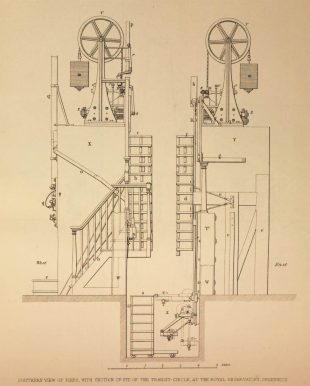
Section showing the Southern view of the piers of the Transit Circle with a section of the pit. Drawn by B. Sly and produced by Day & Son, Lithographers to Queen Victoria. Adapted from Plate 10 of Airy's description of the Transit Circle published as Appendix 1 of the 1852 volume of Greenwich Observations. Reproduced courtesy of the Munich DigitiZation Center (MDZ) and the Bavarian State Library (BSB).
Working out where the reserve clock was placed when used with the Transit Circle is more problematic as no location seems ideal, the observing pit being somewhat cramped with a width of just four feet. It has to be wondered To what extent Airy even considered the matter while designing the Transit Circle and its instrumentation.
Assuming that Airy did not make a mistake, we know that in 1874, 'the clock Arnold 1 was placed in the Transit-Circle-pit' while Hardy was being repaired (1874 Report). We also know from the published observations that both the reserve clock and Hardy were running simultaneously on at least some occasions. For example, when Hardy was brought back into use on 15 May 1854, the first observation made with it was taken just 12 minutes after an observation had been made with the reserve clock Mudge & Dutton.
For both clocks to have been in use at once, either the reserve clock must have been mounted in the pit in one or other of the corners at the southern end or it must have been mounted elsewhere in the Transit Circle Room. It is not impossible that a different location was used on different occasions.
The problem with the pit is working out where the reserve clock could be firmly secured as the pit was only three and a half feet deep. A clock like Graham 2 would have protruded above the level of the Transit Circle Room floor by as much as two and a half feet leaving it extremely vulnerable to being inadvertently kicked or knocked as people moved around the room unless it was attached to one of the collimator piers (facing either north or south) which would have required a section of floor in the room to be removable, or to the western pier facing east which seems unlikely given the narrowness of the pit.
The pit could be entered at two different points on its western edge. In light of this, it is not impossible that on some occasions the clock was fixed somewhere on the western wall of the Transit Circle Room. When viewed from the pit, the place where it would have been most visible is opposite the northern set of steps. When observing looking northwards, the observer would have had to take the time from the clock before entering the pit at the southern end.
An examination of the holes in the backs of the reserve clocks indicating how the clocks were mounted might help support this view. Unfortunately however, Graham 2 has since been re-cased and Arnold 1 and Mudge & Dutton were both sold in 1932.
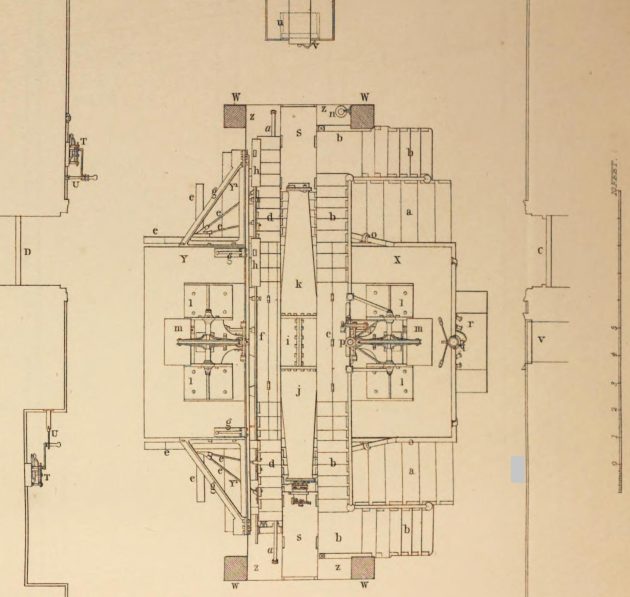
If it wasn't placed in the observing pit, the most likely place for the reserve clock to have been placed is against the west wall of the Transit Circle Room opposite the northern set of steps down into the observing pit at the location marked with a grey rectangle, Hardy being located at U at the top of the diagram. Ground plan of the Transit Circle Room and view of the Transit Circle etc. from above adapted from Plate 3 of Airy's description of the Transit Circle published as Appendix 1 of the 1852 volume of Greenwich Observations and reproduced courtesy of the Munich DigitiZation Center (MDZ) and the Bavarian State Library (BSB).
The use of Mudge & Dutton as the reserve Transit Clock in the years 1854, 1855 and 1856 throws up other potential difficulties. The published observations show that as well as being used as the Transit Clock, it was simultaneously being used with the Reflex Zenith Tube. First brought into use in 1851 in a room immediately to the east of, and accessed from, the Transit Circle Room, the Reflex Zenith Tube was moved in 1855 to a newly built room adjacent to the west side of the Transit Circle Room which was accessed from the old Transit Room. It was used for observations of the star γ Draconis. Mudge and Dutton was normally housed alongside it from 1851 until 1899 when it was moved to the Upper Chronometer Room. Given that only the day and the hour of the observation was recorded when observations were made of γ Draconis, it is surmised that Mudge & Dutton was removed from the Reflex Zenith Tube Room and set up in the Transit Circle Room while Hardy was out of action. Regrettably, the two rooms that had housed the Reflex Zenith Tube were both demolished during the conversion of the building for museum purposes in the 1960s.
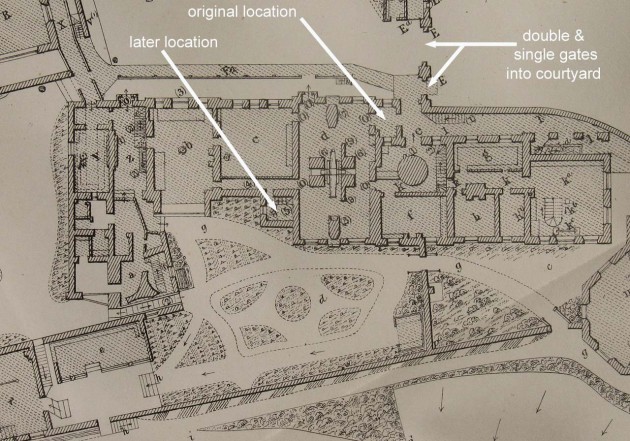
Ground Floor plan of the Meridian Building in 1863 showing the original and later locations of the Reflex Zenith Tube. (d) is the Transit Circle Room. Detail from a plan published as an appendix to the 1862 volume of Greenwich Observations
Following the arrival of Dent 1906 in 1871, Arnold 1 continued to be used as a substitute for Hardy until at least 1909 (when published records cease). However, an examination of the published observations indicates that towards the end of 1890, eye & ear observations ceased to be taken when it was used instead of Hardy. Arnold 1 was also used as a substitute for Dent 1906 when it was out of action. It was replaced in this role by the clock Dent 2 in 1906. (Introduction to Greenwich Obs 1905 & 1906)
Although the Transit Circle and Hardy remained in use until 1954, the Transit Circle ceased to be used for time determinations in 1927, the Small Reversible Transit Instruments being used instead. How long Arnold 1 continued to be used when Hardy was out of action is unclear. It was sold as surplus to requirements in 1932. It is important to note however that a substitute clock of some sort would still have been required in order for the Transit Circle to be correctly prepared for each observation.
Hardy's view of Maskelyne and Pond
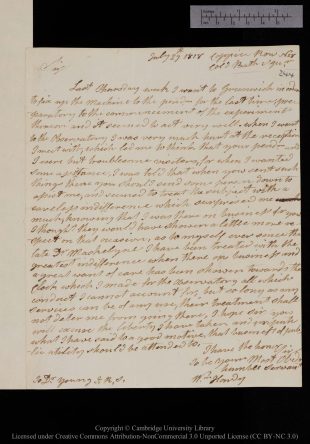
Hardy's letter of 29 July 1818 complaining about the Observatory. Reproduced under the terms of a Creative Commons Attribution-Non-Commercial 3.0 Unported License (CC BY-NC 3.0) courtesy of Cambridge Digital Library (see below)
It was perhaps his ongoing annoyance about his treatment that caused him to include the introductory letter, dated 25 April 1820, that was published to accompany his paper in Transactions of the Society Instituted at London for the Encouragement of Arts, Manufactures and Commerce. Volume 38. In it, Hardy painted a rosy view of his relationship with Maskelyne:
‘The order for the clock was unlimited in price, and directed me to consult the Doctor on every particular connected with it. I therefore waited on the Doctor to receive his instructions; his treatment to me was kind and hospitable, and he gave me every encouragement to exert myself, and to complete the clock in such a manner as to be durable and certain in its performance.
…
‘I cannot here refrain from saying a few words to the memory of the late Rev. Dr. Maskelyne. My first knowledge of the Doctor was at the period above mentioned ; at that time they were making great improvements at the Observatory, which engrossed the whole of the Doctor’s attention; the room for the new instruments was then building, and such was his perseverance, that he was out there in the most inclement weather, superintending the workmen, which I believe tended much to shorten his days: he was most indefatigable in his application to the interest of the Observatory, no doubt, for the great end of advancing the science of astronomy, in which he delighted. His attention to the business of the Observatory was punctual and strict, and he continued to transact it till within a week or two of his death, an event which, it will be allowed, was a great loss to the public, and to be regretted the more as he did not live to see the new instruments completed, in which he took such pride, and which he strove so much to accomplish.’
Roughly six weeks after writing this Hardy sent a signed manuscript copy of the last paragraph to Maskelyne's widow or daughter. Now preserved amongst the records of the National Maritime Museum, it can be viewed here: Hardy, in Memory of Maskelyne 7 June 1820 (REG09/37).
Hardy's 1818 letter suggest he was quite possessive about the clock and that he had failed to understand the exposed environment in which the clock would be required to operate. It should be noted that his comments about Maskelyne and the ordering of the clock were not written until after he had complained about Pond in 1818. Clearly frustrated by his treatment, the 1820 letter could be seen as him putting his version of events in the public domain and placing all responsibility for the expensive and unnecessary work he had carried out while making the Greenwich clock onto Maskelyne, on whom he heaped nothing but praise.
Despite Hardy's irritation with Pond, he continued to service the clock until 1830 when his ire was provoked again after Pond arranged for his escapement to be replaced with one made by Dent.
In light of the changes made to the clock in the subsequent decades, it is interesting to speculate on what the relationship between Hardy and Airy might have been like if Hardy had not died in 1832.
Historical summary with references
The following dates are unknown and are therefore not included in the table below:
- The date when the mercury pendulum with a glass jar was swapped for one with an iron jar.
- The date when the mercury pendulum with the iron jar was swapped for one of zinc and steel
- The date the dial was painted white.
The table includes the dates on which the clock was being cleaned or serviced, but not when adjustments were made to the pendulum. It is possible that some dates when the clock was being serviced have been omitted. This is particularly true after 1890 when such information ceased to be included as a matter of course in the tables of Transit Observations in the volumes of Greenwich Observations. A list of all the interventions including adjustments to the pendulum between 1811 and 1830 can be found in two tables higher up the page.
Date |
|||
| 1806 | 6 Mar: Last meeting of the Board of Longitude attended by Banks until 7 Mar 1811 (RGO14/7/87) | ||
| 26 Jun: Pond's paper showing the Greenwich Quadrants are defective read at the Royal Society |
|||
| 18 Jul: Visitation day at Greenwich - Maskelyne delivers a memorial asking for new instruments including a circlular instrument and a clock to go with it (RGO6/22/52 & RS/MS600/58 & 75) | |||
| 1807 | Jan 8: Hardy writes to Board of Longitude asking for a trial of his escapement (RGO14/23/239) | ||
| Jan 22: A committe of the Royal Society meets and resolves that the Observatory should be provided with a circular instrument a clock to go with it and a new room to put them in | |||
| Mar 5: The Board agrees to a trial (RGO14/7/103) | |||
| Mar 6: Hardy records that Maskelyne called on him to see the escapement |
|||
| Apr 23: At a Council od the Royal Society 'a letter from the Secretary to the Board of Ordnance date March 23rd 1807 was read stating that the said Board had given orders that the Circular Instrument, and necessary alterations to the building of the Royal Observatory, recommended by the President and Council of the Royal Society should be immediately provided.' No mention of a clock recored in the minutes' (RGO6/22/54) | |||
| May 29-27 Aug: Hardy's escapement trialled at Royal Observatory |
|||
| 1808 | Feb: Earnshaw writes the introduction to his Appeal, which is published later that year | ||
| Mar 3: Board of Longitude awards Hardy £50 | |||
| By 31 May, clock ordered from Hardy for Greenwich by Maskelyne for use as a transit clock with the new Mural Circle that is on order. |
|||
| 1809 | Sep 13: The bespoke pier for receiving the clock is in place and had been painted in error | ||
| 1811 | 9 Feb: Maskelyne died. 18 Feb: Probable date Pond appointed Astronomer Royal (ADM181/20) 7 Mar: Pond attends his first meeting of the Board of Longitude (RGO14/7/145) 12 Apr: Earliest record of the Hardy Clock running at the Observatory (RGO5/222 & Rees’ s Cyclopaedia) 13 Apr: Pond takes up residence at the Observatory after Maskelyne's family have finally moved out. Aug?: Hardy submits his bill for £325, which is then disputed. |
||
| 21 Aug: Board of Ordnance asks the Council of the Royal Society what a reasonable sum should be | |||
| 14 Nov: Hardy asked to attend a meeting of Council on 21 November | |||
| 1812 | Jan 19: Cumming reports on a meeting he had with Hardy to discuss the bill | ||
| 30 Jan: The Council of the Royal Society recommends to the Ordnance that that Hardy be paid a sum of £200 guineas for the clock. (RS/MS 372/153 & RGO6/22/68). 17 Feb: Hardy not happy and asks for 'two or three superior chronometer makers' to arbitrate or 'to take back the clock'. No information has been found as to how the dispute was eventually settled 11 Jun: First published Observation with the Mural Circle (Greenwich Obs). 15 Jun: First published Transit Observation using Hardy as the transit clock (Greenwich Obs). 1 Oct: 'The Circle clock [Hardy] was taken down to be cleaned' (Greenwich Obs). This is the first record of the clock being cleaned. 9 Nov: After having run irregularly of a day or two, 'Mr. Hardy was sent for, who applied a little oil to the pallets, and the defect now removed.' (Greenwich Obs) |
|||
| 1813 | Jan 10: 'Before the passage of αAndronodӕ Mr. Hardy put a new weight to the clock.' (Greenwich Obs) New 10-foot Transit Instrument ordered from Troughton |
||
| 1814 | 9 Dec: 'Took down the Clock to have it cleaned' Set going again on 20 Dec. (Greenwich Obs) |
||
| 1816 | 16 Jul: the 10-foot Transit Instrument by Troughton replaces Bradley's 8-foot Transit Instrument of 1750 on raised piers in the same location. First published observation made on Jul 21. (Greenwich Obs). 29 Jul: 'Mr. Hardy took down the clock to be cleaned' (Greenwich Obs). 2 Aug 'Mr Hardy cleaned the clock, put it up again, and set it going nearly with sidereal Time.' |
||
| 1818 | 5 Jun: 'Mr. Hardy took down the clock to be cleaned.' (Greenwich Obs). 11 Jun: 'Mr Hardy put up the Clock, and set it nearly with sidereal Time.' |
||
| 1819 | 20 Dec: 'Mr. Hardy took down the clock to be cleaned' (Greenwich Obs). 1 Feb 1820: set going again. (Greenwich Obs). During the clock's carriage to London, the Seconds hand was damaged (RGO5/222) |
||
| 1823 | 4 Nov: Hardy Moved from Circle Room to Transit Room for use as the Transit Clock, with the new Transit Telescope. (Greenwich Obs) 22 Nov: New second hand fitted (Greenwich Obs) |
||
| 1825 | May 18: 'On the 18th Mr. Hardy took down the clock to clean it, and on the 21st it was put up again; from which time the observations commence' (Greenwich Obs) Nov 24: 'Mr. Hardy stopped the clock to apply some oil; it was set going again nearly at sidereal time' (Greenwich Obs) |
||
| 1827 | Feb 21 'Mr. Hardy stopped the clock, to apply fresh oil and make some alterations in the springs of the escapement. A small quantity of mercury was likewise added to the pendulum weight' (Greenwich Obs) Jun 26 'Mr. Hardy cleaned the Clock' (Greenwich Obs) |
||
| 1828 | 3 May: First recorded alteration to the pendulum: 'Mr Hardy applied a new glass cylinder to the pendulum of the clock containing a column of quicksilver nearly half and inch longer than the former.' 5 May: 'Mr. Hardy cleaned the clock' (Greenwich Obs) | ||
| 1830 | 13 Feb: 'After the passage of the Sun the clock was taken down by Mr. Dent in order to apply a new escapement, and a clock of his own substituted in place thereof.' (Greenwich Obs). This was done because the The rate of the clock had become extremely unsteady (Intro to Greenwich Obs 1836) 30 Mar: 'Hardy's clock was put up again by Mr.Dent, having had a dead-beat escapement applied (Greenwich Obs). Hardy later complained to the Royal Society as Dent also inscribed the dial (in keeping), with the words 'New deadbeat Escapement &c by Dent London A.D. 1830.' (RS/MS/171/58). This was later abridged to 'New Dead Beat Escapement by Dent' when the dial was later painted white (date currently unknown) |
||
| 1831 | 13 Dec: 'After the passage of the Sun, Mr.Dent took down the clock to clean it'. 'On the 15th, Mr. Dent put up the clock again, and added nearly one-tenth of an inch of quicksilver, as it appeared to by the late going, compared with the temperature, that it was not sufficiently compensated.' (Greenwich Obs). 31 Dec: 'Mr Dent stopt the clock to take off the dial plate, in order to make some alterations.' (Greenwich Obs). 3 Jan 1832: 'On the 3rd, the dial plate of the clock was replaced, and the clock set going again.' (Greenwich Obs 1832) | ||
| 1834 | 10 Apr: 'On the 10th, Mr. Dent cleaned the clock and set it going again ... the quicksilver was found very impure; it was taken out, and some fresh substituted.'. The clock was taken down on Apr 8 for this purpose. (Greenwich Obs) |
||
| 1835 | Pond resigns and Airy becomes Astronomer Royal, taking up the post on 1 Oct. | ||
| 1836 | In Airy's first year in office, a number of clocks were altered by Dent. 18 Nov: Hardy was taken down after the Sun's passage and Arnold 2 used'. Returned 2 Dec. (Greenwich Obs) This is when the clock was cleaned, the 'jewelled holes' removed and the openings made in the dial to make the beat of the clock louder (Intro to Greenwich Obs). Dec 6: 'Hardy was again taken away and Arnold 2 used'. Returned 10 Dec. This was principally for the alteration of its going-spring (RGO6/24/12) | ||
| 1839 | 10 Jun: 'Hardy was taken down and Arnold 2 substituted.' 24 Jun: 'Hardy was put up again, but the observations were carried on with Arnold 2.' 1 Jul: Hardy brought back into use for observations. (Greenwich Obs) | ||
| 1840 | The 1840 inventory (RGO6/54/85 (item 22)) records the presence of a thermometer in the clock case. | ||
| 1845 | 26 Nov: 'At noon the Transit clock (Hardy's) was taken down by Mr. Dent to be cleaned, and the going fusee was corrected: during the time it was away the observations were made with Graham 1'. 10 Dec: The clock (Hardy) was set up again, and approximately regulated by Graham 1; the observations were made with Hardy on Dec 11.' (Greenwich Obs) | ||
| 1849 | 22 Oct: 'After the observation of the Sun, the Transit Clock was taken down to be cleaned; and another clock by Graham (G 2) was used instead of it till its return.' Returned 29 Oct & brought into use on 30 Oct. (Greenwich Obs). At Airy's request, the going work (going barrel) was examined and subsequently altered causing Dent stating that in his opinion it had 'always been the cause of failure since it was made' (RGO6/722/144–148) |
||
| 1850 | Airy's Transit Circle erected in the now former Circle Room which had been adapted to receive it. 27 Dec: Hardy transferred from the Transit Room to the Transit Circle Room for use as the Transit Clock. To this end, it was dismounted from its case and mounted so that the dial was in the lower part of the south collimator pier facing northwards, in which position it remains today. Whilst removing the pendulum 'the spring' was broken and a new one had to be specially made (RGO6/723/151-2). The telescope was bought into use at the start of 1851, replacing the Troughton 10-foot Transit Instrument | ||
| 1851 | Dial re-silvered and varnished (Feb 28 - Mar 10). The drop of the escape-wheel-teeth altered to make the beat louder, new pallets and possibly a new anchor being fitted (Jul 2–25). Possibly a new heavier weight was also fitted. Graham 2 used as Transit Clock on both occasions |
||
| 1853 | Chronograph installed. Galvanic wires connected to Hardy's pendulum on Nov 10, but removed on Nov 11 (Grenwich Obs) | ||
| 1854 | Chronograph brought into use. 6 Jan: 'An apparatus was attached to the pendulum of the Transit-Clock, for the purpose of closing a galvanic circuit in the middle of each oscillation' (Grenwich obs) Removed for cleaning on 17 Feb and returned on 23 Feb, Mudge and Dutton used in the meantime (Greenwich Obs) 11 Apr: 'Before this observation the Transit-Clock Hardy was taken down, and Graham was substituted.' (Greenwich Obs). Which Graham was not specified, but we do know that Graham 1 remained in the Altazimuth Dome. 12 Apr: 'At noon, the Transit-Clock (Hardy) was taken down, and all the following observations are made with the Zenith Sector Clock (Mudge), which was temporarily set up.' (Greenwich Obs). This would suggest that either the Apr 11 entry was incorrect (though it does not appear to have been corrected in the errata lists published in the succeeding years) or Graham was only used for a few minutes prior to Mudge being set up 15 May, Hardy brought back into use Greenwich Obs records: 'To the clock is attached a supplementary wheel with sixty teeth, on the prolongation of the Axis of the scape wheel, so that at every beat of the clock one of the teeth presses upon the upper of two springs a, and closes the galvanic circuit' |
||
| 1855 | 11–14 Jul: 'The Transit-Clock (Hardy) was stopped for the purpose of making some alterations in the galvanic contact springs, and Mudge and Dutton was used in its stead.' (Greenwich Obs) |
||
| 1856 | 28 Feb: 'The contact springs of the Transit-Clock were adjusted and cleaned, the clock being stopped for the purpose' (Greenwich Obs & RGO6/730/228) Dismounted on November 18 for cleaning and Mudge and Dutton used in its stead. Eye and Ear method used until Hardy remounted on 24 November (Greenwich Obs). While being cleaned, Airy took the opportunity to have one of the teeth in the wheel cut away, so that once in each minute no mark was placed on the chronograph drum (Intro to Greenwich Obs 1856) |
||
| 1859 | 'On February 8, the transit-clock Hardy stopped, and Arnold 1 was set up for use while the contact springs were repaired and re-adjusted, On February 12 Hardy was ready for use again.' (Greenwich Obs). It was presumably at this point that 'another pair of galvanic springs, whose contact is produced by the same 60-tooth wheel which produces the contacts of the original pair of springs that make the circuit for seconds'-puncture on the Chronographic Barrel' were added, the purpose of the new circuit being 'to regulate one of the clocks and to give motion to another, which are used in connexion with the new South-East Equatoreal.' (1859 Report) |
||
| 1861 | 26 Aug: 'The transit-clock was taken away to be cleaned. From August 27 to September 6, therefore, the observations were made by eye and ear, with the North Dome clock, Arnold 1.' (Greenwich Obs). While it was away, holes were made through those parts of the Collimator Pier that encased the clock, with the aim of increasing the amount of free ventilation of the clock and reducing the amount of any future rusting of its steel-work (1862 Report) | ||
| 1863/4 | Contact springs fitted to Arnold 1 to enable it to be used with the chronograph (rather than the eye and ear method) when Hardy was out of use. (1864 Report). No ref. to this in the 1864 correspondence (RGO6/742) so probably fitted in 1863, but 1863 (RGO6/741) correspondence still requires checking | ||
| 1864 | 'June 3. The clock Arnold 1, which had been used from April 29, during cleaning of the Transit-Clock, Hardy, was taken down; and Hardy was brought into use again.' Hardy was returned on 13 May: as well as being cleaned the pin in the western pair of contact springs was removed (Greenwich Obs & RGO6/742/118-120). Winding of the clock switched from one a week (Mondays) to twice a week (Mondays and Thursdays) |
||
| 1865/6 | 'Some irregularities in the rate of the Transit Clock appeared to be due to the weight and power of the springs, especially to one of the two pairs, which are used to produce galvanic circuits at every second of transit-clock time. These have been made lighter, and there appears to be no doubt that the rate of the clock is improved.' (1866 Report) |
||
| 1867/8 | 6 Feb: 'Mr Ashwell [from Dent] took off and cleaned both pairs of transit clock contact springs' (RGO6/745/103). 'I have given a new form to the head of the clock, for admission of small tin boxes in which a few lumps of quicklime will be placed, in order to keep the air about the wheel-work in a state of dryness.' (1868 Report). The quicklime was replaced monthly |
||
| 1869 | 2 Dec: 'The clock Hardy was taken away to be cleaned, and the clock Arnold 1 was used as a transit-clock until Dec 19' (Greenwich Obs). On its return, it kept stopping and Dent were asked to come and examine it on 3 Jan (RGO6/748/84). The clock was stopped, examined and the pendulum lowered three divisions before it was set going again (Greenwich Obs) |
||
| 1871 | During the year, Hardy suffered a number of issues with the contact springs, starting on 11 Jan. (Greenwich Obs). E. Dent & Co supplies three clocks for the forthcoming Transit of Venus expedition with zinc and steel pendulums that have been specially invented by Thomas Buckney (Dent 1914, Dent 1915 & Dent 1916). A similar pendulum was also supplied with Dent 1906 that was delivered the same year and installed in Magnetic Basement as the new sidereal standard providing impulses for the chronograph and enidng Hardy's role as the de facto standard | ||
| 1873 | 12 Feb: 'The clock Hardy was put in connection with the chronograph and used as the Transit-Clock for the remainder of the day, in consequence of the pricker being held down by the current from the Sidereal Standard.' (Greenwich Obs). 24 Oct: 'The clock Arnold 1 was brought into use, being connected with the Chronograph as Transit-clock' i.e. instead of Dent 1906 (Greenwich Obs). It appears to have remained in use until the end of 23 Jan 1874 (Greenwich Obs 1874) | ||
| 1874 | 19 Feb ''The Clock Hardy was taken away for repair, and Arnold 1 substituted in its place.' Brought back into use on 5 May. (Greenwich Obs). 'The clock Hardy, which was in a bad state, has been thoroughly renovated by Messrs. E. Dent & Co., the principal alterations being the substitution of new contact apparatus and of a new escape-pinion for the old parts. While these repairs were being executed, the clock Arnold 1 was placed in the Transit-Circle-pit for use in observations of Circumpolar Stars, &c.' (1874 Report). See also RGO6/752/125 & 128 |
||
| 1878 | 13 Jan: 'The Clock Hardy was sent to Messrs. E. Dent and Co. for repair, the Clock Arnold 1 substituted for use in the Transit-Circle Room.' Returned 11 Mar. (Greenwich Obs). 'The clock" Hardy" frequently used with the Transit-Circle, had become exceedingly rusty, and has received extensive repair.' (1878 Report) | ||
| 1879 | 17 Mar. Dent asked to 'send someone down, at your earliest convenience, to readjust the maintaining spring in the clock "Hardy": if frequently fails while winding the clock." (RGO6/757/58) | ||
| 1880 | 'These alterations [to Dent 1906 (the sidereal standard)]were carried out by Messrs. E. Dent and Co., between 1880, September, and 1881, April; the clock “Hardy” being used in place of the Sidereal Standard during the interval. In other words, Hardy was used as the sidereal reserve rather than Arnold 1. (1881 Report & Greenwich Obs 1880 & 1881) |
||
| 1882 | 25 June: 'The clock Arnold 1 was substituted for Hardy, which was removed while alterations made in the mounting of the South Collimator were in progress'. Hardy re-erected in 11 July. (Greenwich Obs) |
||
| 1883 | 13 Aug: 'The Clock Hardy was sent to Messrs. E. Dent and Co. for repair, the Clock Arnold 1 being used in its place.' Returned 18 Aug. (Greenwich Obs) |
||
| 1885 | 8 Oct: 'The Clock Arnold 1 was substituted for the Clock Hardy' . 23 Oct: 'The Clock Hardy was replaced in the transit-circle room'. (Greenwich Obs) | ||
| 1887 | 24 Mar: 'The Clock Arnold 1. was substituted for the Clock Hardy, which was removed by Messrs. E. Dent & Co. for repair.' Returned 28 Apr. (Greenwich Obs) 6 May: 'The Clock Arnold 1. was substituted for the Clock Hardy, which was removed by Messrs. E. Dent & Co. for repair.' Returned 11 May. (Greenwich Obs) |
||
| 1889 | 'The clock "Hardy," which had not been going well, was cleaned and repaired by Messrs. E. Dent & Co. in January. (1889 Report) |
||
| 1890 | 14 Jan: 'The clock Hardy was removed by Messrs, E, Dent & Co. for repair, the clock Arnold 1 being substituted for it.' Returned 24 Jan. (Greenwich Obs). 'The Sidereal Standard was cleaned in April [1891]and the clock "Hardy" in December [1890]. (1891 Report) |
||
| 1892 | The Mean Solar Clock was cleaned by Mr. Kullberg on 1892 May 27 ... . The clock Hardy was repaired on May 30...'. (1893 Report). No eye & ear observations were taken during Hardy's absence (Greenwich Obs). The 1893 Report is the first AR's Report to state that Kullberg had worked on one of the Observatory's regulators (though probably not Hardy). It is suspected that Dent probably continued to be responsible for Hardy until 1905 when Kullberg is specifically mentioned as working on it in the Report |
||
| 1893 | Described in 1893 inventory (RGO39/10/29) as 'Clock by Hardy' and being in the Transit Circle Room, with no information about the pendulum. Nor is there any reference to an earlier pendulum being stored in either of the two Chronometer Rooms or the Museum that had been set up in the partially constructed New Physical Building | ||
| 1894 | The clock Hardy was repaired on January 12 (1894 Report). 11 Dec: Possibly removed for cleaning & returned 15 Dec (RGO39/10/29), but there is no record of this happening however in the 1894 vol of Greenwich Obs or AR's Report |
||
| 1895 | 'The Standard Sidereal clock, which had been going very well till February, stopped on February 27. The escape pivot was found to have become dry and to be cut. The clock was repaired by Messrs. E. Dent & Co., and brought into use again on March 6. During the interval the Clock Hardy was used as the Standard.' (1895 Report & Greenwich Obs) |
||
| 1896 | 29 Feb: 'Clock Hardy removed to be cleaned'. 13 March: 'Clock Hardy returned' (RGO39/10/29 and Greenwich Obs). No eye & ear observations made during its absence |
||
| 1905 | 'The Clock Hardy, which was much rusted owing to damp weather, has been cleaned by Messrs. Kullberg, who have made alterations in the case to protect the clock from damp as far as possible.' (1905 Report). No eye & ear observations were made between 1 Jan & 13 Mar 1905 inclusive, the implication being that a reserve transit clock was not used, though a clock would have been needed to be visible to enable the setting of the instrument. (Greenwich Obs). 1905 is also the last year in which the Introduction to Greenwich Observations records that Arnold 1 was available and used if needed 'in the place of Hardy or of the Sidereal Standard Clock [Dent 1906].' The Introduction for the following year states that only that it was, if and when required, available for use as a replacement for Hardy only |
||
| 1909 | Last year that the volumes of Greenwich Observations were published with an Introduction containing details of the Observatory's clocks | ||
| 1923 | 9 Feb: 'Cleaned and overhauled'. (RGO39/4/60). This appears to be the first service since the inventory RGO39/4 was started in 1911. There is no record of it being serviced in the two later inventories RGO39/5 & RGO39/6 which cover the period up to the outbreak of the second world war | ||
| 1954 | 30 Mar: last published observation made with the Airy Transit Circle taken by Gilbert Satterthwaite (Greenwich Obs). By November, the movement and driving weight were being stored in the East Library at Greenwich (Clock Inventory, Nov 1954 (RGO71/1/3/1)). The location of the pendulum was not recorded |
||
| 1967 | Refurbished Meridian Building opens to the public for the first time. Hardy on display in 1851 location, but on loan from the Astronomer Royal |
||
| 1975 | Clock running (Howse, 1975) |
||
| 1984 | Conservation work carried out at the National Maritime Museum (NMM conservation files) | ||
| 1991 | Disassembled and lightly cleaned prior to reassembly ready (NMM conservation files) | ||
| 1990s | Clock running, but sometimes set to mean solar time and sometime sidereal time (NMM conservation files) | ||
| 1998 | Hardy transferred to the National Maritime Museum on closure of RGO |
||
| 2010 | Dismounted for examination and oiling on 21 January. Remounted 9 March and set running (NMM conservation files) |
||
| c.2018 | Removed during floor replacement and other building works. On completion only the movement was replaced, the driving weight and pendulum being retained in storage |
||
Nineteenth century views on Hardy's escapement
Edmund Denison's (Lord Grimthorpe) view (1868)
Further Reading
Hardy's obituary: Gentleman's Magazine, December 1832
On the Superiority of Zinc and Steel Pendulums, Thomas Buckney MNRAS 1886
Known Hardy regulators
Hardy's obituary states that as well as the Greenwich Clock, he also made:
' three astronomical clocks for the Russian government, three for the American government, one for the Anderson Institution at Glasgow, One for the Cape of Good Hope and one for Gen, Sir T. Brisbane.'
As well as these ten, Hardy clearly made at least eight others. At least three members of the Observatory's Board of Visitors owned one – The Duke of Sussex, William Pearson and Francis Baily. Redfern (1993) states that John Herschel who was also a Visitor, also owned one. No references however were given by Redfern and attempts to verify his statement have not yet proved productive.
The clocks Hardy made (or signed) are listed in three groups below.
- Those of which there are published images (this includes the Greenwich trial clock)
- Clocks that are known to still exist, but which do not appear in the first list
- Clocks that cannot be found but which Hardy is known to have supplied. Some of these might be amongst the clocks in the first list whose original owner is listed as unknown.
There has been much debate about the precise dates that the various clocks were ordered / delivered. Amongst the earliest are the two ordered for the United States Coast Survey by Ferdinand Hassler following his visit to the Royal Observatory in 1812. Other early clocks are those that were ordered for the Garnethill Observatory in Glasgow and that owned by Sir Thomas Brisbane for his private observatory, which was also in Scotland.
What is striking is that of the twelve complete regulators made by Hardy for which reasonably good images of the dial are available (Nos.2–13 in the list below) only two have identical dials (Nos. 12 & 13). Features that evolved are the way Hardy signed the dial, the simplification of the dial markings and the placing of the securing screws. There is a real sense of the design evolving over a period of at least 15 years. It would seem that it was only in the 1820s that Hardy changed from marking the hour numerals from 1 – 24 to 0 – 23. Interestingly, of the clocks for which an image is available, only the Cape and Downside Abbey clocks (Nos. 7 & 8) have dials whose detailing comes close to matching the plate published by Hardy in 1820. They are also the only clocks confirmed to have the four pillars shown in the 1820 plate (most seem to have five). Clocks 6–13 have their pillars screwed to the backplate, whilst on clock 3 they are riveted, no information being available for clock 2 and clock 1's movement is signed Raymond. Whilst the earlier clocks seem to have six crossings on the escape wheel, the later ones only have five. Both the shape of and the way in which the top bar (from which the pendulum was hung) also evolved over time before it reached what appears to be a standard form.Of the clocks for which images of the cases are available, only the two early clocks (Garnethill & Brisbane) have hoods with a broken arch. The remainder all have hoods with a doomed top similar to that of the Jensen clock whose image is reproduced in an earlier section. In the earlier clocks, the trunks were rectangular, but in the later ones they were tapered towards the top (as in the Jensen example). Likewise, it is only with the later clocks that there appears to have been the option of having the door glazed.
Allix (1990) reports differing numbers of turns on some of the barrels. Hardy also altered the design of the escape wheel as the teeth have squarer ends in Hardy's published plans compared to those drawn from life at Greenwich by Ferdinand Hassler in 1812. In his paper Design Analysis of a William Hardy Regulator Spring Detent, Leslie Paton writes of Hardy's escapement: 'A brief survey of some of the existing Hardy clocks shows that they all vary dimensionally'. Unfortunately, he does not state which clocks he examined, nor does he record any of the individual dimensions. There is also the added issue of whether or not any of the escape wheels he examined were replacements.
Hardy was a well-known chronometer maker who, prior to getting the Greenwich commission, is not known to have ever made a clock. The Brisbane Clock and possibly the month going clock (No.16 in the list) have signs that they were built as prototypes for the Greenwich Clock. Both have the winding arbour to the right of centre. On all the other clocks for which information is available (13 in total), it is to the left. The Brisbane and the Greenwich clocks have more numerals marked on the dial than any of the others. The Brisbane dial is also unique in that the numerals are all upright. On the others that have been examined they are concentric with the bottom of each number being closest to the centre of the dial.
No. in list |
Inscription |
Location |
Comment |
|
| 1 | Willm. Hardy / Invt. et Fecit / London / No.2 |
(bottom centre) | Sold as the trial clock in 2021 |
|
| 2 | Wm. Hardy London || Inv.t et Fecit | left & rt. of centre || | punct. t.b.c. | |
| 3 | Will,,=m Hardy || LONDON: Inv.t et Fecit | " |
m is double underlined | |
| 4 | Will,,m Hardy || LONDON: Inv.t et Fecit | " | punct. t.b.c. | |
| 5 | Will,,m Hardy || London. Inv.t et Fecit | " | ||
| 6 | Will.m Hardy Inv.t || et Fecit, London | " | punct. t.b.c. | |
| 7 | Will,,m Hardy || Inv.t et Fecit, London. | " | punct. t.b.c. | |
| 8 | Will,,m Hardy, || Invt et Fecit. London | punct. t.b.c. | ||
| 9 | Will,,m Hardy || Inv.t et Fecit, London. | " | The W is not of the typical form | |
| 10 | Will,,m Hardy, || Inv.t et Fecit. London. | " | ||
| 11 | Will,,m Hardy, || Inv.t et Fecit, London | " | ||
| 12 | Will,,m Hardy, || Inv.t et Fecit. London. | " | ||
| 13 | Will,,m Hardy, || Inv.t et Fecit. London. | " |
The thirteen clocks are:
1. Trial clock, 2. Brisbane, 3. Greenwich, 4. NAWCC, 5. Garnethill, 6. Sandhurst,
7. Cape of Good Hope, 8. Downside Abbey, 9. Fyvie Castle, 10. Jensen. 11. Time Museum (former),
12. Cambridge Observatory, 13. Francis Baily's.
Table of key features
Clock |
2 |
3 |
4 |
5 |
6 |
7 |
8 |
9 |
10 |
11 |
12 |
13 |
| Pillars (No.): R = riveted to backplatea | ? | 5(R) | 5(R) | 5(R) | 5 | 4 | 4 | 5 | 5 | 5 | 5 | 5 |
| Hood: Broken Arch (B) Domed (D) | B | ? | ? | B | D | D | ? | ? | D | D | D | D |
| Trunk: Rect. (R), Tapered (T) | R | ? | ? | R | R | T | ? | ? | T | T | T | T |
| Seat board: Brass (B) or Wood (W) | W | B | B | ? | W | B | n/a | ? | W | B | B | B |
| Hour dial marks: 1–24 = A. 0–23 = B |
A | A | A | A | A | A | A | B | B | B | B | B |
| Winding arbour Left or Rt. of centre | R | L | L | L | Lb | L | L | L | L | L | L | L |
| Fastening of top bar: A or Bc | A? | ? | A | A | B | B | ? | B | B | B | B | B |
| Escapewheel crossingsd | ? | 6 | 6 | 6 | 5e | 6 | ? | 6 | ? | 6 | 5 | 5e |
a otherwise screwed
b below centre line
c A = top of backplate & front of frontplate; B = top of backplate & top of frontplate
d some may not be original
e new escapewheel by Stevenson
List 1. Hardy regulators with published images
In compiling this list, an attempt has been made to place the clocks in order of their manufacture. This is based on documented dates (of which relatively few exist), the method of fixing the pillars to the backplate (riveted or screwed) and features of the dial and case (which are assumed to have evolved over time rather than specified by the purchaser).
1. The clock sold by Bonhams as the Board of Longitude trial clock
| Ordered by / for etc. |
Board of Longitude trial | |
| Date | Completed c.1806 | |
| Inscription on dial | Willm. Hardy / Invt. et Fecit / London / No.2 (bottom centre) |
|
| Numerals on seconds dial | 5, 10, 15, 20, 25, 30, 35, 40, 50, 55, 60 | |
| Current escapement | Dead Beat |
|
| No. of pillars | 6 | |
| Seat board | ? | |
| Hood | Shallow arched cresting over a ripple-moulded cornice | |
| Current owner | ? | |
| Images on-line | Bonhams catalogue, 15 Dec 2021, lot 78 (nine images) |
|
| Other published images | Wood (1992) |
|
| Further information | Despite the inscription on the dial, the movement is not believed to have been made by Hardy. It is signed Raymond, London on the backplate. Allix (1990) suggests however that it was made by Thwaites. It is not known if there was ever a clock marked No.1 |
|
| Other References | Allix (1990) |
2. The Brisbane Paramatta Observatory Clock
| Purchased by |
Sir Thomas Brisbane for his private observatory in Scotland. Taken by him to Australia in 1821 for use at the Parramatta Observatory | |
| Date | c.1810?? | |
| Inscription on dial | Wm. Hardy London || Inv.t et Fecit (Punctuation t.b.c.) | |
| Numerals on seconds dial | 5, 10, 15, 20, 25, 30, 35, 40, 50, 55, 60 | |
| Numerals on hour dial |
1 – 24 inclusive | |
| Current escapement | Dead Beat |
|
| No. of pillars | ? | |
| Seat board | Wood | |
| Hood | Broken-arch | |
| Current owner | Powerhouse Museum Object No: 9889 |
|
| Images on-line | Object No: 9889 (front and rear images of the complete clock and information relating to its construction) Object No:P3549-154 (photograph of dial) Object No:P3549-155 (side view of the movement) |
|
| Other published images | Lomb (2004), see below |
|
| Further information | 1. Wooden seatboard. 2. One of only two known Hardy regulators with the winding arbour to the right of centre. 3. Originally the weight fell too close to the pendulum and attempts were later made to move it further away. 4. Hour hand has been replaced by a wheel. 5. Possibly a prototype constructed by Hardy prior to making the Greenwich Clock. 6. Possibly designed to be wall mounted – the base being either a later addition of a more recent replacement. |
|
| Other References | Allix (1990) The Instruments from Parramatta Observatory, Nick Lomb, Historical Records of Australian Science (2004) |
3. The Greenwich Clock
| Ordered by / for etc. |
Nevil Maskelyne for the Royal Observatory |
|
| Date | Probably ordered in 1808. Delivered April 1811 |
|
| Inscription on dial | Will,,m Hardy || LONDON: Inv.t et Fecit (left and right of centre). It should be noted that the m is double underlined and sits above double commas. Dent added a further inscription in 1830 (see above) | |
| Current escapement | Dead beat (originally fitted by Dent in 1830: modified 1851) |
|
| Numerals on seconds dial | 5, 10, 15, 20, 25, 30, 35, 40, 50, 55, 60 | |
| Numerals on hour dial |
1 – 24 inclusive | |
| No. of pillars | 5 | |
| Seat board | Brass (later replaced by one of cast iron | |
| Original Hood | Not known - ?possibly broken-arch similar to that of the Brisbane and Garnethill clocks? | |
| Current owner | National Maritime Museum (Object ID: ZAA0591) | |
| Images on-line | See main article above and National Maritime Museum entry (Object ID: ZAA0591) | |
| Further information | See above |
4. The National Association of Watch & Clock Collectors, Inc. clock
| Ordered by / for etc. |
Unknown |
|
| Date | Unknown |
|
| Inscription on dial | Will,,m Hardy || LONDON: Inv.t et Fecit (Punctuation t.b.c.) |
|
| Numerals on seconds dial | 10, 20, 40, 50 | |
| Numerals on hour dial |
1 – 24 inclusive | |
| Current escapement | Modified Hardy original |
|
| No. of pillars | 5 | |
| Seat board | ? | |
| Hood | No case |
|
| Current owner | The National Association of Watch & Clock Collectors, Inc. Donated to the National Watch & Clock Museum in 2001 by Dr. ray Davis |
|
| Images on-line | Watch & Clock Bulletin (Journal of the National Association of Watch & Clock Collectors, Inc. pp. 56 & 57 (Jan/Feb 2023) (four images including ones of the dial, the rear of the movement and the escapement) |
5. The Garnethill Observatory / Dysart clock
| Ordered by / for etc. |
Andrew Ure for the newly constituted Garnethill Observatory in Glasgow |
|
| Date | Probably ordered in 1809, but definitely by June 1810 (The London Chronicle). Completed by 1814 at the latest |
|
| Inscription on dial | Will,,m Hardy || London. Inv.t et Fecit | |
| Numerals on seconds dial | 10, 20, 30, 40, 50, 60 | |
| Numerals on hour dial |
1 – 24 inclusive | |
| Current escapement | Restored Hardy escapement. Work carried out by John Redfern |
|
| No. of pillars | 5 |
|
| Seat board | ? | |
| Hood | Broken-arch, rectangular trunk |
|
| Current owner | National Museums Scotland | |
| Images on-line | National Museums Scotland, Object: T.1988.96 (2 images: Complete clock and dial |
|
| Other published images | Allix (1990) (1 image) |
|
| Further information | The broken-arch hood is similar to that of Brisbane's. According to Allix (1990), Hardy scratched the following inscription on the back of the dial: 'This regulator was made for the Glasgow Observatory but from a disposition to shuffle off the agreement I had it for three years by me when the Earl of Dysart bought if of Me from a liberal disposition to marking that the treatment I received from the Glasgow people was not right. W. Hardy June 1817'. Converted at some point to a dead-beat escapement, but much of Hardy's escapement apparently left in place. Sold at Christies 12 December 1988 and acquired by National Museums Scotland soon after. In 1810 Ure acquired Pond's 'Westbury Circle' for Garnethill. It is not known why Garnethill did not follow through with the Hardy. Nor is it clear if the clock was delivered and later repossessed by Hardy or if the order was to all intents and purposes cancelled prior to delivery. According to Gavine (1982) Ure consulted widely in 1809 about the instruments he should buy for the new but yet to be erected observatory. Amongst the people he visited were Sir Thomas Brisbane, Maskelyne, Pond and Troughton. Gavine also records that the clock was 'a Hardie astronomical clock with jewelled pivots. similar to those made for Greenwich and Brisbane' and records a purchase price of 150 guineas. Unfortunately, his sources are not entirely clear. | |
| Other References | Redfern & Woodward (1993). Allix (1990). Gavine, David Myles (1982). Astronomy in Scotland, 1745–1900. PHD thesis, The Open University |
6. The Military Academy Sandhurst clock
| Ordered by / for etc. |
Probably the Royal Military College (later renamed the Royal military Academy) |
|
| Date | c.1818 |
|
| Inscription on dial | Will.m Hardy Inv.t || et Fecit, London (Punctuation t.b.c.) | |
| Numerals on seconds dial | 10, 20, 40, 50 | |
| Numerals on hour dial | 1 – 24 inclusive | |
| Current escapement | Restored by Roger Stevenson using Hardy's original drawings and also the measurements from the clocks at Greenwich, and Cambridge | |
| No. of pillars | Allix states 4, but his image appears to show 5 |
|
| Seat board | Wooden | |
| Hood | Domed top, rectangular trunk |
|
| Current owner | Unknown |
|
| Images on-line | Christie's catalogue (Sale 7102, lot 14), 15 Sep 2004. The movement shown is from a different clock |
|
| Other published images | Allix (1990) p.607. Rear of movement showing backplate and escapement Roberts (2003) p.92. 5 images (16.7A-E). Image B has been flipped. |
|
| Further information | The Observatory at Sandhurst was built in 1818. Pearson published details of its rate between Feb & Dec 1820. Sold by Christie's for £35,850 in 2004. Winding hole below centre line on 44 minute radius, Minute numerals enclosed within an outer circle on the dial. Although Stevenson fitted an escape wheel with five crossings, it seems probable that the original had six. |
|
| Other References | Allix (1990) Roberts (2003) Christie's catalogue |
7. The Royal Observatory at the Cape of Good Hope clock
| Ordered by / for etc. |
Board of Longitude for the Cape Observatory |
|
| Date | Completed 1822 (RGO14/48/173, RGO14/48/58 & RGO14/7/391) | |
| Inscription on dial | Will,,m Hardy || Inv.t et Fecit, London. (Punctuation t.b.c.). Apart from the positioning of the above inscription, the layout and marking of the dial appears to be the same as that of the Downside Observatory clock (No. 8 in the list) | |
| Numerals on seconds dial | 10, 20, 40, 50 | |
| Numerals on hour dial |
1 – 24 inclusive | |
| Current escapement | Dead-beat |
|
| No. of pillars | 4 | |
| Seat board | Brass | |
| Hood | Domed top, tapered trunk |
|
| Current owner | Royal Observatory Cape of Good Hope |
|
| Images on-line | 11 images immediately below | |
| Further information | Part of Hardy's original escapement was left on the movement when the dead-beat escapement was fitted. Hardy's cross bar supporting the pendulum has been removed and the pendulum independently mounted on a substantial metal frame that is bolted onto the wall behind and passes through a specially created opening in the backboard. Because of this the dust cover is no longer fitted (does it survive?). The dial has a circular piercing in the seconds dial which was presumably made when the clock was adapted for use with a chronograph. The holes drilled into the right-hand edges of the front and back plates possibly supported some of the associated equipment (now removed). The dial also has a horizontal slit passing through the centre whose purpose is currently unknown |
|
| Other References | Results of observations made at the Royal Observatory, Cape of Good Hope |
8. Downside Abbey Observatory clock
| Ordered by / for etc. |
Unknown, but at Downside Abbey Observatory by the 1860s |
|
| Date | c.1822? |
|
| Inscription on dial | Will,,m Hardy, || Invt et Fecit. London (Punctuation t.b.c.) |
|
| Current escapement | Grimthorpe gravity escapement (fitted in the 1950s) |
|
| No. of pillars | 4 |
|
| Hood | No longer in original case |
|
| Numerals on seconds dial | 10, 20, 40, 50 | |
| Numerals on hour dial | 1 – 24 inclusive | |
| Current owner | Downside Abbey |
|
| Images on-line | Dominic Winters auction catalogue (21 images) |
|
| Other published images | Wood (1992): images of converted movement from the rear and side |
|
| Further information | Built for St. Gregory's College and completed in 1860, the observatory at Downside Abbey burnt down in 1867. The transit room however survived, as did the transit clock by Hardy. Holmes & Fitzgerald-Lombard give its later history as follows: 'Having escaped the ravages of the fire, it was reconstructed some time in the early 1890s by Father Edward Stutter (1842-1922), a keen amateur astronomer, and taken by him to Acton Burnell ... It there actuated a chronograph ... After Father Stutter's death the timepiece was stored for many years in a box at Downside until in the late 1950s, it was restored by Dom Augustine James (1883-1970).' Put up for auction on 21 July 2023 with an estimate of £10,000 – £15,000, but not sold (auction results). The auction catalogue states that the old case was damaged in the fire and that the present oak case dates from the early 20th century. |
|
| Other References | Wood (1992); Dominic Winters auction catalogue; The Downside Review, Vol 5 (1886), p. 31-39; Holmes & Fitzgerald-Lombard, The Great Observatory at Downside 1859–1867 |
9. The Fyvie Castle clock
| Ordered by / for etc. |
Ordered by William Gordon for his observatory at Fyvie Castle in Aberdeenshire Scotland |
|
| Date | 1821? |
|
| Inscription on dial | Will,,m Hardy, || Inv.t et Fecit, London. The W is not typical, having an entirely different form with 1½ curls at its start |
|
| Numerals on seconds dial | 0 – 23 inclusive | |
| Numerals on hour dial | 10, 20, 30, 40, 50, 60 |
|
| Current escapement | Hardy original. Repaired by Chris Edwards in 2018 after all its pallet springs were broken in about 1985–6. Roberts (p.85) states incorrectly that they were reinstated by Stevenson |
|
| No. of pillars | 5 |
|
| Seat board | ? | |
| Hood | ? |
|
| Current owner | National Trust for Scotland (Fyvie Castle) | |
| Images on-line | Dial (part) & small versions of the first 2 images below Movement from the front/ left side with dial removed Restored escapement Winding barrel Alternative link (Scottish Field) |
|
| Other published images | Wood (1992): 2 images showing the damaged escapement before it was repaired |
|
| Other References | Allix (1990) |
10. The Jensen Clock
| Ordered by / for etc. |
Unknown – named after its owner in the later 1940s |
|
| Date | c.1825?? |
|
| Inscription on dial | Will,,m Hardy, || Inv.t et Fecit. London. | |
| Numerals on seconds dial | 10, 20, 30, 40, 50, 60 |
|
| Numerals on hour dial | 0 – 23 inclusive | |
| Current escapement | Replica Hardy escapement (early 1900s by Lecluse) |
|
| No. of pillars | 5 |
|
| Seat board | Wood | |
| Hood | Domed top, tapered trunk, glass panelled door | |
| Current owner | National Maritime Museum, Object ID:ZAA0606 (purchased 1980) |
|
| Images on-line | 20+ images on the Museum's website |
|
| Other published images | Allix (1990). 3 images complete clock, Movement and A.A.E. Lecluse's scratched notes under a pillar washer. Roberts (2003). P85, Fig.16.3. Mislabelled as the clock that Hardy supplied to Greenwich |
|
| Further information | The veneered case is quite unsuited to the extreme conditions of temperature and humidity to which a transit clock was subjected. Although it is on display at the Museum's Royal Observatory site, it was never owned by the working Observatory or used there. | |
| Other References | Allix (1990). |
11. The former Time Museum clock
| Ordered by / for etc. |
Unknown |
|
| Date | 1820s? |
|
| Inscription on dial | Will,,m Hardy, || Inv.t et Fecit, London |
|
| Numerals on seconds dial | 10, 20, 40, 50 | |
| Numerals on hour dial |
0 – 23 inclusive | |
| Current escapement | Replica Hardy made by John Martin and Roger Stevenson in the early 1980s |
|
| No. of pillars | 5 | |
| Seat board | Brass | |
| Hood | Domed top, tapered trunk |
|
| Current owner | Museum of Science & Industry, Chicago (Roberts (2003)) |
|
| Images on-line | – | |
| Other published images | 10 images in Roberts (2003) | |
| Further information | Allix (1990) gives the date as c.1814 whilst Roberts (2003) gives it as 1814. The 1814 date appears to be based on the fact that it has a brass seat board. Purchased by Roberts in 1980 where it was restored. Sold to Time Museum. Subsequently sold at Sotherby's following the Museum's closure |
|
| Other References | Allix (1990) Roberts (2003) |
12. The Cambridge Observatory clock
| Ordered by / for etc. |
Cambridge Observatory |
|
| Date | 1820s. Possibly ordered with other instruments as early as 1820. Replaced Molyneux and Cope as Transit Clock no earlier than 1825. 1825: earliest published reference located to date that mentions the clock (see also this reference from 1826) 1828: first published observation mentioning Hardy |
|
| Inscription on dial | Will,,m Hardy, || Inv.t et Fecit. London. | |
| Numerals on seconds dial | 10, 20, 40, 50 | |
| Numerals on hour dial | 0 – 23 inclusive | |
| Current escapement | Hardy (original) |
|
| No. of pillars | 5 |
|
| Seat board | Brass | |
| Hood | Domed top, tapered trunk, wooden door with small glass window at the bottom though which the beat scale can be viewed |
|
| Current owner | Whipple Museum. Accession Number 2800 |
|
| Images on-line | Complete Clock (above), Dial (below) and Whipple Museum collections (4 images of case and dial) |
|
| Other published images | Allix (1990): 2 images (complete clock and movement from the side/rear). Wood (1976): 1 image (Clock with trunk door open). Wood (1992): 1 image complete clock |
|
| Further information | The impulse pallets are jewelled, the locking ones are not. Transferred to Institute of Astronomy at Cambridge. Loaned to National Maritime Museum 1967–1981. Formally transferred to Whipple Museum 10 Dec 1980 |
|
| Other References | Allix (1990) |
13. Francis Baily's clock
| Ordered by / for etc. |
Francis Baily |
|
| Date | c.1825?? |
|
| Inscription on dial | Will,,m Hardy, || Inv.t et Fecit. London. | |
| Numerals on seconds dial | 10, 20, 40, 50 | |
| Numerals on hour dial | 0 – 23 inclusive | |
| Current escapement | Original Hardy restored (see below) |
|
| No. of pillars | 5 |
|
| Seat board | Brass | |
| Hood | Domed top, tapered trunk, glass panelled door | |
| Current owner | Unknown |
|
| Images on-line | Bonhams Skinner catalogue 25 Apr 2015, lot 104 (13 detailed images) Sundial Farm Antique Clocks (19 detailed images) |
|
| Further information | Unsold at auction in 2015. The 2015 catalogue states that in 1993, Roger Stevenson restored the spring pallets, and made a brass cased weight, pendulum jar and lid the rear chaton and some screws. The clock also passed though the hands of Sundial Farm Antique Clocks. Their text is also reproduced on the this Watch-Wiki page. The Sundial Farm images include one of the bottom of the seatboard with the words 'Mr Baily' written on it ink. The accompanying text has the following additional information including the fact that it had been purchased at auction in 1991, that the grain patterns on the plinth are nearly identical with those of the Cambridge Clock (above). It also states that escapement detents and pallets had been badly repaired when the clock was purchased in 1991 |
|
| Other References | – |
List 2. Other clocks definitely not included in the list above
Ordered by / for |
Existence |
Other info. |
|
14 & 15 |
Ferdinand Hassler | ? | Ordered by Ferdinand Hassler in 1812/3for the American Coastal Survey. In the list of scientific instruments procured for the survey that he compiled in 1815 he wrote the following: 'Two astronomical Clocks, of the same improved construction as those lately made by the same artist and inventor, Mr Wm Hardy, for the observatories of Greenwich & Glasgow. spring scapement, silver plated dial, compensation by a glass cylinder with mercury, acting as [lens of] the pendulum.' In 1824, Hassler published a description of the two clocks (links below). It included four figures amongst which were drawings of the escapement. It is interesting to note, that they differ in significant details from those published by Hardy in 1820. The clocks differed from that at Greenwich and elsewhere as they had aperture hour dials and at Hassler's request, only the escapements were jewelled. Hassler's clocks also had (at his request) 'a strong square pillar' attached to the seatboard that sat behind the pendulum and helped support the brass bar at the top of the movement from which the pendulum was suspended. From what Hassler implied, the clocks may also have been mounted and cased in a similar way to the Greenwich clock, but this is not entirely clear. A report published in 1856 states that the clock was 'a more cumbrous instrument' than one made by Kessel. In 1850, Locke recorded that he understood that a 'pivot motion is now substituted, in place of the springs of the Hardy clock'. |
16 |
? | Yes | Allix records: A month going movement with mercurial pendulum but no case. One of only two known Hardy regulators with the winding arbour to the right of centre. Location: America |
17 |
Rev. Pearson | Yes | Current owner, unknown. Allix records: 5 pillars. the date 1816 scratched on the dial. Hardy's escapement with pallets repaired by Martin Pegler. Those for impulse are jewelled, the locking ones are not. |
18 |
John Wrottesley? | ? | This clock is a bit of a conundrum as in 1829 only the wheel work was recorded by Wrottesley as being by Hardy: ‘On the 1st of December, 1829, a clock with the dead-beat escapement, and having a mercurial compensation pendulum, was fixed to the pier above described. The wheel-work of this instrument is by Hardy, but the pendulum was made by Mr. William Richardson of the Royal Observatory.’ (MMRAS, Vol 10, p.158). In 1854 he wrote: 'The Hardy or transit clock has behaved exceedingly well during the whole course of the observations; the rate has been remarkably steady, and the beat is, as before loud and distinct. This is, indeed an admirable mechanism, and of all the instruments in my observatory has given me the most unalloyed satisfaction.' (Journal of Science and Art). Following Wrottesley's death in 1867, the clock was put up for sale with the following description. 'The clock, by Hardy, is a very good one, there being no difference between its summer and winter rates.' (MNRAS, Vol.28, p.126). The fact that the clock was referred to in both 1854 and 1867 as being by Hardy suggests that at the very least, the dial carried Hardy's name. Wrottesley Hall burnt down in 1897, destroying almost all the Wrottesley family papers. See also the section above titled '1830: Dent replaces the escapement and an argument ensues'. |
List 3. Other clocks that may be included in the first list above, but which are now lost or untraced or amongst those whose original owner is not known
19 |
The third clock listed in Hardy's Obituary that was supplied to the American Government |
20–22 |
3 clocks supplied to the Russian Government, one of which is recorded as being at Wilna in 1820 and is believed to have still been there in 1949. |
23 |
Rev. Thomas Hussey's clock (c.1825–1831). Probably purchased for his observatory in Hayes Kent which was built in 1831 behind his house. Sold c.1840 to Durham University for their new observatory. The clock is mentioned in the Introduction to both the 1846–1848 and the 1849–1852 volumes of the Durham Observations. For more information on Hussey's observatory, see Hayes Rectory. Richard Carrington, who was the observer at Durham from October 1849 –April 1852, recorded the following about the clock in the Introduction to the published results of the Observatory ‘The clock (by Hardy) did its part most satisfactorily. It was once cleaned during the time that I used it. The beat was very sharp and audible, and the average difference of two consecutive daily rates not more than 0s,15; double that quantity being an extreme value. This clock stood in the S.E. angle of the transit-room, and, being visible from the dome above, was also used in Equatoreal observations. As, however, from the elevated position of the Observatory, noise caused by wind was a frequent source of annoyance, a hearing-tube of gutta percha, about thirty-five feet in length, was supplied at my request, and led from the clock-case into the dome, which was often of essential use.’ |
24 |
The Duke of Sussex's clock. One of a number of items belonging to the Duke that was sold at auction by Messrs. Christie and Manson on 4 July 1843. Listed as item 121, it was described as 'A regulator, by William Hardy, with his Rementoir escapement, with mercurial pendulum, in a mahogany case, A.D. 1820'. Allix records that it was sold for £31. 7s. Christie and Manson sales catalogue |
25 |
The Göttingen Observatory Clock. In 1802, King George III approved funds for the construction or a new observatory at Göttingen, which was subsequently completed in 1816. Ten years later, in the 1 April 1826 edition of the London Mechanic's Register, it was reported that 'His Royal Highness the Duke of Sussex [the sixth son of George III and President of the Royal Society from 1830–1838] and, with that ardent zeal for the promotion of useful science, which forms so prominent a trait in his character, has presented to the University of Gottingen for their new observatory, a transit clock completed on the most improved principle, by W. Hardy, who made a similar one for the Royal Observatory, Greenwich, and other public institutions at home and abroad'. What happened to the clock requires considerable further investigation. See also this link to a book published in 1854. |
Other possible Hardy clocks
26 |
Hardy's obituary records a clock supplied to the Anderson Institution in Glasgow. As Ure was appointed to the staff in 1804, it is probable that this is in fact a reference to the Garnethill Clock (No.5 in the list above). If it was a separate clock, no other references to it have yet been located. |
27 |
Redfern (1993) mentions that a clock was also owned by John Herschel. No references were given and attempts to verify his statement have not yet proved productive. |
Total number of clocks Hardy may have supplied
There are 4 clocks in the first list whose early history is not known and 7 clocks in the third list. It is possible that Hassler misdescribed the clocks that were supplied to him and that clock 4 in the first list is in fact the same as clock 14 or 15 in the second.
The total number identified is therefore at least 19 and perhaps as many as 24 or more (including the clock trialled at Greenwich which had its movement made by Raymond).
Image licensing
The images reproduced courtesy of Cambridge Digital Library are more compressed than the originals and have been reproduced under the terms of a Creative Commons Attribution-NonCommercial 3.0 Unported License. Links to the individual images are as follows:
Image 1: Trial Results of showing the rate of Hardy (RGO14/23/243)
Image 2: Hardy's letter to the Board of Longitude, 31 May 1808 (RGO14/1/200).
Image 3: Hardy's letter to the Board of Longitude, 29 July 1818 (RGO14/23/244)
The following images are © National Portrait Gallery, London and are reproduced under a Creative Commons Attribution-NonCommercial-NoDerivs 3.0 Unported (CC BY-NC-ND 3.0) licence.
William Hyde Wollaston, by William Ward, after John Jackson. Mezzotint, early 19th century. National Portrait Gallery Object ID: NPG D36339
The following images are reproduced under the terms of a Creative Commons Creative Commons Attribution-NonCommercial-ShareAlike 4.0 Licence (CC BY-NC-SA 4.0) courtesy of The Board of Trustees of the Science Museum.
Sir Joseph Banks (cropped from the original). Object Number: 1982-333/3
Thomas Earnshw. Object Number: 1962-374
Bradley’s Mural Quadrant. Detail from a drawing by John Charnock c.1785 is Reproduced under the terms of the Creative Commons Attribution-Non-Commercial-ShareAlike (CC BY-NC-SA) licence courtesy of the National Maritime Museum, Greenwich, London. Object ID: PAF2940.
The image of Hardy's escapement (detail from plate 6 of Papers on various subjects connected with the survey of the coast of the United States by F. R. Hassler (1824)) is reproduced under a Creative Commons BY-SA 4.0 license courtesy ETH Zürich.
Form No. 70. is reproduced courtesy of Bayerischen Staatsbibliothek under a No Copyright - Non-Commercial Use Only licence. It is taken from the 1845 volume of Greenwich Observations published in 1847
© 2014 – 2025 Graham Dolan
Except where indicated, all text and images are the copyright of Graham Dolan
